Prepare Your Business for New Food Waste Legislation in the UK
From 31 March 2025, most UK businesses must arrange separate food waste collections. Learn and prepare for the new food waste legislation in the UK.
New commercial food waste legislation in the UK will be in place from the end of March 2025. It means that from this date most businesses will have to separate food waste from other rubbish streams. Companies must store food waste in separate bins and arrange collection by licensed waste carriers.
These are part of Defra’s simpler recycling plans that aim to improve recycling rates, simplify waste management, and benefit the environment. Mandatory food waste separation should ensure less waste food makes its way to landfill sites and is instead disposed of responsibly.
At Business Waste we can help companies of any industry and size anywhere in the UK arrange separate food waste collections. Call 0800 211 8390 or contact us online today for a free quote to prepare for the new food waste law. Keep reading to find out more about the changes to food waste legislation in the UK.
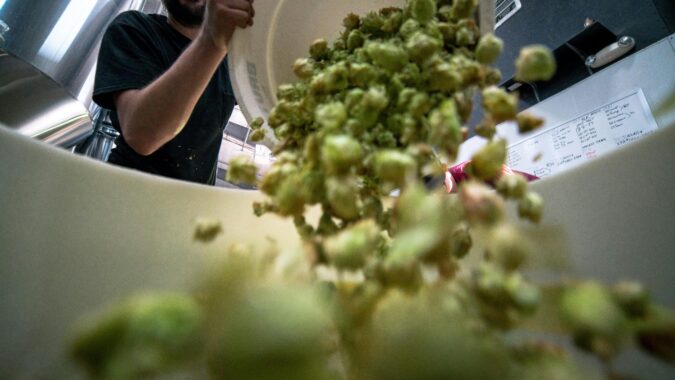
The new food waste legislation in the UK is part of a legal statutory instrument to standardise recycling across England. This is the Environment Act 2021 (Commencement No. 9 and Transitional Provisions) Regulations 2024. It focuses on changing waste separation and collection requirements for domestic and non-domestic premises, which includes most businesses having to arrange separate food waste collections.
Any business in England that produces more than 5kg of food waste per week must arrange separate collection by licensed waste carriers. This includes any biodegradable materials produced from processing or preparing food – including inedible parts like bones, eggshells, fruit and vegetable skins, tea bags, and coffee grounds.
According to the official government response, the preference is for food waste collected to go for anaerobic digestion treatment. This is because it generates biofuel and digestate from unavoidable waste food. The biofuel can be used for energy while digestate is spread on land to recycle nutrients to help form a circular economy.
The new food waste law requiring businesses to separate waste food comes into effect on 31 March 2025 in the UK. This includes for public and third-sector organisations like schools, prisons, and hospitals. For micro businesses (firms with fewer than 10 full-time employees), they must comply with the new food waste law by 31 March 2027.
Mandatory food waste separation will apply to all non-domestic properties in England that produce more than 5kg of food waste a week, under the new regulation. This covers all businesses, prisons, hospitals, care homes, offices, schools, garages, and transport hubs. It’s especially relevant for restaurants, cafes, pubs, takeaways, bakeries, and butchers.
Micro businesses will be exempt from the new food waste regulation. That means any firm with fewer than ten full-time employees can still dispose of food scraps and leftovers in general waste bins. However, separating food waste is advisable where possible for companies of any size and industry.
It’s much better for the environment for waste food to be composted or sent to an anaerobic digestion plant rather than going to landfill or for incineration. These options create natural fertilisers and biogas that can be used as an energy source. Plus, your business will pay less landfill tax as part of your waste management costs by separating food waste.

The UK government aims to eliminate food waste to landfill by 2030. It’s hoped that this new legislation can drive England towards that target, as it also covers changes for food waste collections from homes. Wales and Scotland already have their own food waste legislation in place, which this aims to replicate for England.
Every year more than 9.5 million tonnes of food waste are thrown away in the UK. A huge amount of this isn’t recovered or recycled and ends up rotting in landfills, adding to carbon emissions and greenhouse gases. Sending food waste to landfill can cost more than £100 per tonne, so it’s an expensive business too.
If you run any kind of business in England that creates more than 5kg of food waste per week then you should start to prepare for the new commercial food waste regulation. You must have arranged separate storage and collection of food waste by 31st March 2025.
At Business Waste we can help you prepare for these changes and comply with the new regulation. Save money with free food waste bins for your business anywhere in the UK – you only pay for the collection costs. There are no rental or delivery fees. Our expert team can answer your questions and determine the best solution for your organisation.
Follow these steps to prepare for the commercial food waste legislation changes in England:
Contact Business Waste today to arrange your commercial food waste collections.
From 31 March 2026, all households in England should receive food waste collections at least once a week. Local authorities and councils are responsible for arranging this in their areas. Households will likely be provided with a small bin or box to separate food waste from general waste and dry recycling.
The domestic food waste should then be taken to an anaerobic digestion or composting site. This aims to reduce the amount of organic waste making its way to landfill. Your local council should be in touch about the details and timelines for these changes.
Recycling clothes is important as it saves water, materials, and energy compared to creating new garments from scratch. It also keeps old clothes out of landfill sites and incinerators, which reduces the carbon footprint associated with used clothing. Individuals and businesses produce lots of fashion waste, so sustainable management is vital.
In the UK we throw out 300,000 tonnes of old clothes every year – that’s a lot of wasted material. Of this amount, less than a fifth are recycled even though you can recover and reuse many textiles. This includes everything from ripping your favourite pair of jeans, kids outgrowing jumpers, and corporate uniforms and construction workwear becoming damaged.
Homes and businesses should do all they can and recycle rather than bin clothes at the end of their life. These are some of the main reasons why recycling clothes is important:

Throwing away old clothing in a general waste bin means there’s a chance it could make its way to landfill. Some councils and local authorities dispose of general waste in landfill sites, so if you chuck an old t-shirt in your household general waste bin it could now be rotting in landfill.
According to WRAP, around £140 million worth of clothes go to landfill sites in the UK every year. This is a staggering waste of money, terrible for the environment, and clothes take up valuable space in landfill sites that could be used by materials that can’t be reused, recycled, or recovered.
Clothes also release toxins when they decompose in landfill due to the chemicals, dyes, and any synthetic fibres they may contain. These can leach into the nearby ground and water while clothes contribute to methane production as they break down – a potent greenhouse gas. Recycling clothes avoids all such problems.
Clothing production relies on using lots of water, raw materials, and other resources. Recycling old clothes eliminates the need to source fresh materials and use up gallons of water to create new clothes. It contributes to a circular economy, while the water and materials saved by recycling can be put to good use elsewhere.
For example, making just one t-shirt uses 2,700 litres of water. Cotton is commonly used to create clothing and it’s highly water-intensive because it’s grown in some of the warmest countries. Then there’s the use of water for dyeing garments, which can pollute clean water in some cases.
Synthetic fibres are formed from crude oil, while the likes of leather, wool, and silk all rely on animals. Recycling old clothes helps recover these materials and reuse them to create new clothing items and textiles. This helps reduce the reliance on gathering fresh materials from such sources, which benefits the environment.

The global fashion industry is responsible for around 10% of greenhouse gas emissions. This is down to the energy required to produce materials and process them into apparel, the transportation of materials and clothing around the world, and the disposal of old and worn-out old clothing items.
If every UK household recycled one black bag full of clothes rather than binning them it would save enough carbon to heat 400,000 homes. Emissions from incineration and methane from clothes decomposing in landfill are huge. Recycling avoids this and cuts carbon emissions as it’s more energy-efficient than producing new clothes.
The trend for buying cheap clothing and wearing items a few times before discarding them is devastating for the environment. Fast fashion is one of the main polluters in the world. Reassessing your spending habits as a consumer and recycling used clothes is an easy way to tackle the issue.
Businesses can also play a part by adapting their practices. Clothes retailers could reduce how many new seasons and collections they introduce. Offering an incentive to customers who recycle their old items in-store can also benefit the environment, whether it’s a discount or providing access to a new range.
Other companies also rely on clothing, such as uniforms in restaurants, construction gear, and even suits for lawyers. Set a good example as a business by reusing and recycling business clothing where possible and avoid updating designs too regularly, as this can create unnecessary waste.

An easy way to recycle clothes that are in decent condition is to donate them to a local charity or community cause. Some charities will sell them in their shops to benefit their work while others may send them directly to those in need. You can also recycle clothes at clothing banks to help good causes.
Businesses that have lots of old clothes, such as excess stock or used corporate workwear, can also donate those in usable condition to charities. It’s a great way to do your bit, help others, and avoid such waste going to landfill.
If you run a business that needs textile collection and recycling services then at Business Waste we can help – whatever the type, volume, and condition of the old clothes. Get a free quote for clothes recycling for your business anywhere in the UK today – call 0800 211 8390 or contact us online.
Preparing to move house is an exciting but busy time. You’ll likely have a list of things to do longer than a giraffe’s neck but it’s a great opportunity to have an efficient clear out of those items you no longer need. There’s no point taking a spare Christmas tree, broken microwave, or unused bedding to your new home.
Sorting out waste before you move can save money and time too. It removes the effort of packing stuff that’s just going to be thrown out anyway and means there’ll be less for your removal firm to manage, which could lead to lower fees. Your future self will thank you for removing waste sorting from the list of jobs to do in your new house.
Hiring a skip can be tempting but it’s expensive, you need the space (and a permit if it’s not placed on private land), and often everything ends up in landfill. Instead, follow these tips to manage all your waste efficiently, cost-effectively, and in an environmentally friendly way when moving home.

The biggest items you might want to get rid of when moving house will probably be pieces of furniture. Now is the time to say goodbye to that old sofa you’ve been meaning to replace for years, a broken wardrobe, or the dining chairs and table that won’t suit your new home’s style.
Otherwise, you’ll spend money and effort carting big bits of furniture around just to take them to a different tip. That should be your last option to get rid of furniture when moving home, although it may be necessary if the furniture contains persistent organic pollutants (POPs). The greenest choice is to pass on your old items of furniture for others to use if they’re in decent condition.
Ask friends, family, or neighbours if they want anything, which prolongs the furniture’s life. Donate furniture to a nearby charity shop – some even offer free collections to save you a trip. Alternatively, sell online using sites such as Facebook Marketplace and Gumtree (you can even make collection mandatory, so you don’t have to transport the furniture).
White goods and electrical appliances are some of the other bulky items you might consider getting rid of when moving home. You’ll likely leave the oven behind anyway. If you’re organised you may have agreed to include some other appliances with the house sale, such as a washing machine.
It can be a good negotiating option and saves you the hassle of shifting a few big items. Only leave behind any white goods if it’s been agreed with the buyers. Most people take fridges, freezers, washing machines, and tumble driers with them. If you’re not leaving these items then it’s a good time to assess their future.
You may want a more energy-efficient fridge for your new home or should your washing machine be playing up it could be time for a change. Repairing any faulty electrical appliances is best to extend their life, and save resources, energy, and money. Those beyond repair should be recycled as electricals contain many valuable and hazardous elements.
Many electrical retailers are part of a distributor takeback scheme for WEEE in the UK. Check which stores near you participate and if they’ll accept your old electrical items. This offers a free way to recycle all sorts of old electronics. With small electronic items like kettles and toasters, you can take them to electrical recycling banks.

As you’re emptying your wardrobes to pack up clothes for moving you’ll probably come across items you’d forgotten about. Now is the perfect time to review garments that no longer fit, suit your style, or will be worn again. Put these to one side rather than boxing up with everything else.
Do the same with any sheets, duvet covers, and other linen you’re not going to use in the future. Clothes and bedding in decent condition can be taken to most charity shops and sold to support the cause or sent to those in need. You can also sell old clothes on second-hand sites like Vinted or recycle them in clothes banks.
Threadbare rugs and old carpet rolls might not be worth taking to your new home either. However, if you’re getting a fresh carpet fitted in your new home then contact the carpet fitter and they may remove and recycle your old rugs for you. Otherwise, visit your local household waste recycling centre (HWRC).
Your duvets and pillows may have lost their shape, become stained, or even faded and ripped after years of use. These are trickier to recycle but some retailers offer takeback schemes (such as Dunelm) to ensure responsible disposal. Alternatively, donate to an animal charity or shelter that could use it as bedding.
Before putting your home on the market you probably tidied up the garden to make it presentable. If you’ve got a garden waste bin then you can use this (as long as it’s emptied before you move out – you don’t want to leave a full bin for the new owners).
Emptying the shed can uncover lots of old tools, plant pots, and gardening equipment you no longer need, especially if you’re moving to a home without a garden. Donating to charity shops, passing on to friends and family, or selling online are all good options. You could also check if any local community groups or allotments can make use of your old gardening gear.
If you’ve got a compost bin then decide whether you’ll leave it for the new owners or take it with you. It’s unlikely you’ll want to transport it full of compost so either spread it on part of the garden that needs it or bag it up. You could also give some compost to any neighbours or nearby allotments that want it.

Sorting through the attic, cupboards, and under the bed can uncover all sorts of miscellaneous smaller items. It’s prime time to decide what’s worth keeping and what needs a new home, like you. Separate and bag or box up books, toys, games, small electrical devices, and other things you won’t take with you.
You can’t recycle books in your household recycling bin due to the glue holding the pages together. Instead, take these to a nearby charity shop or local library. Toys, games, and many working electricals should be accepted by most charity shops as well. This extends their life and prevents them from going to landfill.
After sorting through everything in your house and deciding what’s coming with you and what must find a new home elsewhere, you should do everything you can to ensure it avoids going to landfill. Whatever items and amounts you decide to throw away, there are a few ways to get rid of waste when moving home responsibly:

Leave your wheelie bins behind as they’re essentially council property and there should be wheelie bins provided for general waste and recycling at your new home. There’s no law around it but it’s good etiquette to leave the bins empty if possible for the new owners.
They’ll likely create a lot of rubbish in the first week so will need the capacity. If they’re not moving in immediately you could fill them and ask a neighbour to take them in after you’ve left. You could also ask your neighbours if you can put a bit of rubbish in their bins too.
It’s poor form to leave lots of rubbish and waste items behind for the new homeowners or tenants. This passes on the responsibility for them to dispose of it, which could cost them money. Only leave anything that’s been agreed in the terms of the house purchase – such as an oven, washing machine, or anything else.
There could be possible legal consequences if you leave anything not agreed in writing with the new homeowners and solicitors. You also don’t know how the new homeowners or tenants will get rid of these items – they could end up in landfill. Contact Business Waste and we can find a solution to help dispose of your waste away from landfill.
Brits are a fashion-conscious bunch, whether we realise it or not. The country has produced many fantastic designers and become renowned for everything from the flat cap and bowler hats to three-piece suits, trench coats, tweed, and tartan. But staying at the cutting edge of fashion means many people regularly throw away old garments.
According to Clothes Aid, we send 700,000 tonnes of clothing to recycling centres, textile banks, clothes collections, and charities every year in the UK. That’s enough to fill more than 450 Olympic swimming pools. But have you ever wondered what happens to clothes at recycling centres and how our old dresses, shirts, and even socks are reused?
Discover what happens to clothes at recycling centres and their possible journeys from your wardrobe to being reused and recycled.

In most places across the UK, you should not put clothes in your recycling bin at home. Check with your local council or authority to see if they accept old clothing and textiles in domestic recycling bins first though. The majority don’t though as most household recycling bins are for dry mixed recycling like paper, cardboard, plastic, metals, and packaging.
If you put clothes or textiles in a recycling bin where they’re not accepted it can cause contamination. They’ll be removed during the sorting process at the recycling facility and if it doesn’t have the means to recycle textiles they could be sent to landfill or for incineration. It’s therefore best to recycle through the proper channels.
You can take clothes to your local tip or household waste recycling centre (HWRC) in most parts of the UK. Check before you go that they’re accepted and recycled. There should be a specific clothing/textile waste container or area for recycling – don’t throw them into any general waste bins as they may end up in landfill.
Most tips/HWRCs only accept domestic clothes waste, not commercial clothing waste from businesses or other organisations such as old uniforms or stock. If you need to get rid of any type or amount of clothing/textile waste from your company then you’ll have to arrange commercial waste collection.
Many local councils and authorities also have clothing banks around the city or town. These are often found in supermarket and council car parks and other places where there are normally bottle banks and electrical waste banks. They offer a convenient option if you don’t live near a tip or have a car.

Only about 12% of clothes are recycled around the world. Many are donated, reused, or worn out, while sadly lots also end up in landfill or are incinerated. Very few clothes are recycled material-to-material (turned into new recycled clothes). The likes of cashmere can be recycled into suits.
Other old clothing can be recycled into materials used in carpets, insulation, car seats, and more. However, it takes lots of time and labour to sort and separate old clothing as today our threads are made from all sorts of fibres and materials that are tricky to recycle. These include blends of yarn, synthetic fibres, and even microplastics.
Any clothes sent for recycling go to a Materials Recovery Facility (MRF). These are the general steps of what happens to clothes at a recycling centre:
Clothes banks and donation bins are big metal containers used by councils and charities where you can drop off all sorts of old items. Some clothes banks may only be for specific items, such as footwear, and there may be rules (such as clothes must be clean and bagged). Check any signs before popping your old clothing into a donation bin.
The waste management company in charge of the clothes banks will come and empty, remove, or replace them on a regular schedule. It could be weekly, fortnightly, monthly, or just when the donation bin is full. This may vary depending on where the clothes bank is, how much it’s used, and who’s behind it.
All the clothes from the bank will be taken to a facility for sorting and grading. Any grade A clothing (wearable, in good condition, no marks or stains) often goes to charity shops for resale. Grade B clothing (wearable but with marks, bobbling, fading, or tears) is usually sent for use overseas by people in need.
Any clothing that’s badly damaged, in no condition to be worn, and doesn’t class as grade A or B may be sent to a recycling centre. Items like bedding and some other textiles may be resold if in decent condition. Otherwise, they can go to garages and other organisations for use as dust sheets when painting.

Check the label or sign on a clothing recycling bin and it should explain what happens to them. Normally they’re either sold for profit to help the charity, sent overseas, or used to support a local community cause. Any clothes put in a recycling bin that can’t be reused will likely end up at a recycling facility.
At Business Waste we collect a wide range of old clothes and textiles from all sorts of companies. This includes everything from unsold stock leftover at retailers to corporate workwear and uniforms. We can provide free containers to store your textile waste and recycle as much as possible thanks to our zero landfill policy.
We’re a national waste broker with great connections to recycling facilities across the country with the expertise and experience helping many organisations recycle. Get a free quote for waste clothes and textile collection anywhere in the UK today or speak to one of our friendly experts with any questions – call 0800 211 8390 or contact us online.
Peel back the glamorous outer layer and it reveals a few problems in the beauty industry. One of the main ones is the huge amount of waste the sector generates and what happens to it. For starters, the global beauty industry creates 120 billion bits of packaging every year, which all end up as waste.
Nail bars, hair salons, and beauty parlours all produce high volumes and wide ranges of rubbish. Then there’s the waste from makeup containers, cosmetics, and personal care items used at home. Manufacturers, beauty businesses, and consumers all need to act to improve the sustainability of looking stunning by recycling and reducing waste.
Discover all about the beauty industry’s problems with waste, how to create an effective recycling plan for your beauty business, and ways to responsibly dispose of cosmetics and their containers as a consumer in this guide.

The beauty industry relies on various products and practices to rejuvenate skin, hair, and other areas. A professional pampering or personal treatment at home creates all sorts of waste items, from makeup brushes to swabs, strips, wipes, and cosmetics containers. It’s estimated between 20 and 40% of beauty products end up as waste.
Waste is a big problem for the beauty industry due to its volume and the types of waste materials it generates:
There are other environmental problems in the beauty industry, such as the use of palm oil, a big carbon footprint from the transportation of materials and products around the world, and animal testing.
Every kind of business that operates in the beauty industry needs an effective waste management plan in place. This helps reduce your organisation’s environmental impact and save money on waste disposal costs by recycling more and requiring fewer bin collections. Use the following tips to make up an efficient recycling plan for your beauty business.
Start by reviewing your current waste management practices. This should include the types and amount of waste your business creates, where it’s stored, and the disposal method. Any aesthetics waste, chemical waste, or hazardous materials must be stored safely on your site before removal.
Review the results of your audit and the current bins you use to see if there are any areas where you’re throwing out recyclable rubbish with general waste – such as cardboard packaging or glass containers. If so, you should consider adding a dry mixed recycling or cardboard recycling bin to your waste services.
Consider any areas where you create high levels of waste and try to work out why this is. It could be poor working practices, an ordering error, or something else. There might be ways to cut this down, which may also reduce the number of bins and collections you need to lower your waste management costs.

Some types of makeup packaging are trickier to recycle than others and aren’t accepted in many domestic recycling bins. It’s mainly due to the materials and contamination risks. This includes items like plastic eyeshadow palettes, mascara/eye shadow tubes, eyeliner pens, face cream pots, and face mask packaging.
As a beauty business, you can help the environment and consumers by offering a makeup recycling program. Some retailers already provide a take-back scheme for beauty packaging. Doing so demonstrates your organisation’s eco-credentials and helps get customers through the door who may then be likelier to use your other services.
Try to use, buy, and sell products with as little packaging as possible – or items that at least come in recyclable and eco-friendly packaging. A greater focus on the issues the beauty industry faces with packaging waste means more manufacturers are working to produce products with little or recyclable packaging.
Those in packaging made from recycled materials are also more sustainable. Avoid products in plastic packaging where possible, as this is often harder to recycle. Use items in cardboard, paper, and glass packaging and buy in bulk to reduce resources. Some manufacturers may offer a recycling take-back program too.
One cause of waste for beauty businesses is products expiring before they’re used or sold. Maintain an updated inventory and rotate stock (use the first in first out process) to avoid items going out of date. This is important whether you’re looking to reduce waste in a hair salon, tattoo parlour, shop, or beauty salon.
Make sure all products are stored in appropriate places and conditions to prevent the likes of creams and cosmetics from getting too warm or cold and spoiling. If you end up with some items close to their expiry date consider selling them at a reduced price to customers. This should mean less is wasted.
Put in place a recycling policy for your beauty business. Train your employees to follow clear steps to recycle rubbish and dispose of waste properly – especially any chemical waste. Highlight the importance of recycling to help the environment and the positive impact it can have on business costs.
Inform customers if your business offers a take-back scheme to encourage them to return cosmetics packaging. If not, tell them about any other available recycling schemes where they can dispose of any products you sell or supply. Ensure signs and directions are clear to reduce the risk of contamination.
It’s not just businesses that generate waste in the beauty industry. Once products are sold or supplied to consumers the responsibility of what happens to the goods and packaging is in their smooth hands. Responsible use and disposal of cosmetics waste is essential. Use the following tips for ways to recycle beauty products you use at home.
Makeup recycling is an easy way to reduce waste, whether you’re getting rid of unwanted lipstick or an empty face cream tub. Recycling unused or used products is possible in various ways. Never pour makeup down the sink or a drain though, as the chemicals may then enter waterways and damage the environment.
These are a few ideas for ways to recycle old makeup:

There are many beauty recycling drop-off points in shops across the UK where you can recycle makeup. Various brands and retailers are working with waste management companies to provide bins in-store where customers can drop off old makeup that’s then removed and recycled. Some of the main retailers where you can recycle makeup in the UK include:
Recycling makeup containers is possible, but the right method depends on the type of material. To recycle a makeup container of any kind you must first clean it out and remove any remaining product to avoid contamination. Then you can either recycle it in your household recycling bin, take it to a household waste recycling centre (HWRC), or drop-off point.
In most cases, you can recycle makeup containers made of cardboard or some types of plastic in your domestic recycling bin. Check the plastic recycling number and symbol and whether your local authority accepts it in their collections first. For any glass makeup containers you can usually take them to a glass bottle bank as long as they’re clean and dry.
Consumers can help reduce waste in the beauty industry by recycling cosmetics and changing behaviours for a more sustainable future. Here are a few ways to buy and use beauty products in a way that will hopefully create less waste:
Find more information on our page about managing beauty salon waste.
Or explore more expert guides about reducing waste of many other materials.

Many restaurants serve up something unsavoury alongside their delicious dishes – lots of avoidable waste. There’s all the leftover food, packaging from ingredients, and even furniture when it’s time for a refurbishment every five or so years. A growing trend for low and zero-waste restaurants aims to make the sector more sustainable.
The UK hospitality industry creates £3.2 billion of food waste each year according to WRAP. This includes hotels, bars, and other entertainment venues alongside restaurants, and they produce many other waste materials at high cost too. Running a zero-waste restaurant could help your business save money as well as the planet.
There are many areas to look at if you want to operate a low or no-waste restaurant. Small changes and large improvements can help cut your waste management costs and benefit the environment. Find out how to run a zero-waste restaurant with these ideas.

Every restaurant is different. The best way towards becoming zero waste is to audit your existing waste management practices. Review the current types, number, and sizes of bins you use to assess what waste materials and volumes your restaurant produces on a daily, weekly, and monthly basis.
This should highlight how much waste your restaurant regularly creates and identify key areas where reducing waste is most important. Start by setting small achievable targets to cut back on waste in these areas and building an action plan. Over time you can increase the targets until you eventually eliminate waste from every stream.
The following sections provide useful ideas for ways to minimise waste across all areas of your restaurant.
Leftovers from customers – also known as plate waste – are a big reason for the high levels of food waste created by restaurants. Research found plate waste makes up 34% of food binned in restaurants, so it’s a key area to tackle. These are a few things you can try to phase out plate waste in your restaurant:
It’s estimated that food service and hospitality companies throw away 920,000 tonnes of waste food annually. According to WRAP, 21% of food wasted is due to ingredient spoilage in UK hospitality every year. Eliminating waste in your commercial kitchen is something you have more control over when running a restaurant than plate waste.
Use the following tips to reduce waste food from your restaurant’s kitchen:
However hard you try to create a zero-waste restaurant you might still create some level of waste food. Responsible disposal of it can help ensure the waste goes to good use. Move towards becoming zero waste with these options for dealing with leftover food or ingredients:
First In First Out (FIFO) is a simple system to prevent food spoilage and waste in your restaurant. Essentially, you move ingredients with the shortest use-by dates to the front of shelves in cupboards, fridges, and freezers. When deliveries arrive put the latest food with longer dates to the back.
Train your staff in the FIFO process to minimise the risk of food spoilage. Regular reviews and stock rotation every week should highlight any items that have been missed so they can be moved forward and used. And it identifies any food you’ve got too much of so you can adapt your menu to use them up.
Clear labelling of ingredients with use-by dates and allergens helps chefs identify any gone-off ingredients. It also makes keeping track of your inventory easier to avoid over-ordering ingredients that go off. Plus, knowing what’s in every container avoids accidentally throwing out usable food because you don’t know what it is.
Many restaurants, cafes, and pubs produce lots of waste oil from frying up food in their kitchen. It can clog drains and sewers due to improper disposal and pollute the environment. There are a few ways to cut down on oil waste in your restaurant:
The single-use plastic ban means restaurants should no longer provide plastic cutlery and cups. Avoid offering any other disposable items – have washable and reusable chopsticks on the table, for example. If you have a takeaway service consider a discount for anyone with a reusable cup for drinks.
Packaging is a big source of plastic waste for restaurants. Try to only partner with suppliers that have plastic-free packaging or that reduce packaging as much as possible. For example, Restaurant Nolla in Helsinki only works with suppliers that deliver food with no packaging – so it is possible. Buying in bulk is another way to cut down on plastic wrap and other packaging.
Out front in your restaurant is another place where you can reduce waste with a few simple steps. At the table, many waste materials may build up beyond leftover food. Transition to a zero-waste restaurant with these actions to minimise waste at your tables:

Switching from physical menus on every table to an online one saves sheets of paper in the short and long term. Stick a QR code on each table that diners scan to see the menu. It’s also good to have a couple of tablets with the menu loaded up available for any customers without a smartphone or who need larger print.
Your kitchen will appreciate this method too, as you can update the menu in real-time to remove any dishes if they sell out. It also avoids wasting paper when it’s time to change over to a seasonal menu as you won’t need to print an extra Christmas menu – just put it online.
In a pub, café, or restaurant with a small menu, you could even just write out the dishes available that day on a chalkboard. Remove paper bills and receipts and switch to email instead to save even more paper. Or ask customers if they want a paper receipt, as most people throw it away shortly after anyway.
Restaurant toilets are an often-overlooked area where you can reduce waste as well. Most bathroom bins will be full of paper towels that aren’t recyclable once used. Remove any paper towels and replace them with electric hand dryers. Use recycled toilet roll in cubicles for an eco-friendlier approach. At the sinks have refillable soap containers to minimise plastic use and waste.
Many restaurants have a refurbishment every five or seven years. Rather than chucking out old furniture when the time comes, consider upholstering chairs and tables instead. Repairing and upcycling furniture saves lots of waste going to landfill. You can always donate furniture to a charity if you must get rid of it.
Repair rather than replace broken equipment from your restaurant where possible too. Get some experts to repair any kitchen equipment such as ovens, dishwashers, or even electric whisks. This saves huge amounts of WEEE and should be cheaper than buying brand-new equipment.

The beginning of a new year is a popular time to set goals for the coming 12 months. Businesses update targets while many people renew gym memberships and try to stay away from cigarettes, chocolate, or other vices. January feels like a fresh start for making behavioural changes.
Beyond the traditional tried and tested New Year’s resolutions, why not aim for something that benefits the environment this year? Reducing waste is important for businesses and households across the world. Setting a few simple goals helps keep you on track with just some small behavioural tweaks needed to reach them.
Get started with our 12 New Year’s resolutions to reduce waste – one for every month of the year. Each goal helps protect the planet but may also save your business or household money. Choose your favourites, do them all, or try one a month, whichever method you prefer should make a positive difference.

In the modern digital world is there much need for paper? Request online rather than paper bank statements, read eBooks as opposed to hard or paperbacks, and opt for an email receipt wherever possible. Take a bag when you go shopping or collect a takeaway to avoid being given items in a paper bag.
Many offices can reduce their number of printers to minimise the amount of pointless documents printed out and paper wasted. Making it less convenient to print off posters or other items should ensure staff think twice before doing so. Move from paper to online pay cheques too.
Completely avoiding buying anything in packaging is almost impossible, but there are things you can do to reduce packaging waste. Take reusable containers to zero-waste shops and fill them up with dry goods like coffee, pasta, and spices instead of buying packaged items in supermarkets. Visiting greengrocers, butchers, and fishmongers also avoids purchasing overly packaged foodstuffs.
As a business, you could switch suppliers to those that use no or minimal packaging for their products (or at least recyclable and sustainable materials). Reuse boxes and containers for storage, set goals to cut shrink wrap usage, or offer return schemes for packaging where possible.
Strive to buy as many things as you can second hand. This avoids the items going to waste, saves on energy and resources to create new products, and is always cheaper. Scour charity shops or online marketplaces such as Gumtree, Vinted, and eBay for clothes, furniture, cooking equipment, suitcases, games, and almost anything else you need.
Stamp out single-use plastic in your life by always being prepared. Have a reusable bag in your car or coat pocket in case of an emergency trip to the shop when you’re out and about. Keep a reusable water bottle and/or coffee mug/thermos in your bag to fill up at work or elsewhere without resorting to a disposable plastic cup.
Avoid the impulse to throw something away as soon as there’s a slight issue with it. Lost a button on a shirt? Sew a new one on. Snapped the handle off your favourite mug? Stick it back on with some glue. You can always take items in need of repair to professionals such as a tailor, cobbler, or electrician.
Businesses can offer discounts on damaged goods, whether it’s superficial damage to the packaging, a part missing, or something with a minor crack or blemish. Alternatively, find ways to improve and upcycle slightly damaged things by adding a fresh coat of paint, accessories, or using other creative methods.
Eliminating packaging from your life might be impossible, so focus on reusing it to reduce waste. Most types of packaging are great for storage, such as empty takeaway containers, jars of jam or sauce, and cardboard boxes. Clean out glass jars and reuse them when buying loose coffee and pasta from zero-waste shops.
Cardboard boxes can be used by households and companies for storage. They’re also useful to transport deliveries or for help when moving home. Make it your mission to find a way to save, reuse, or recycle all packaging you end up with this year so that none of it goes to landfill.
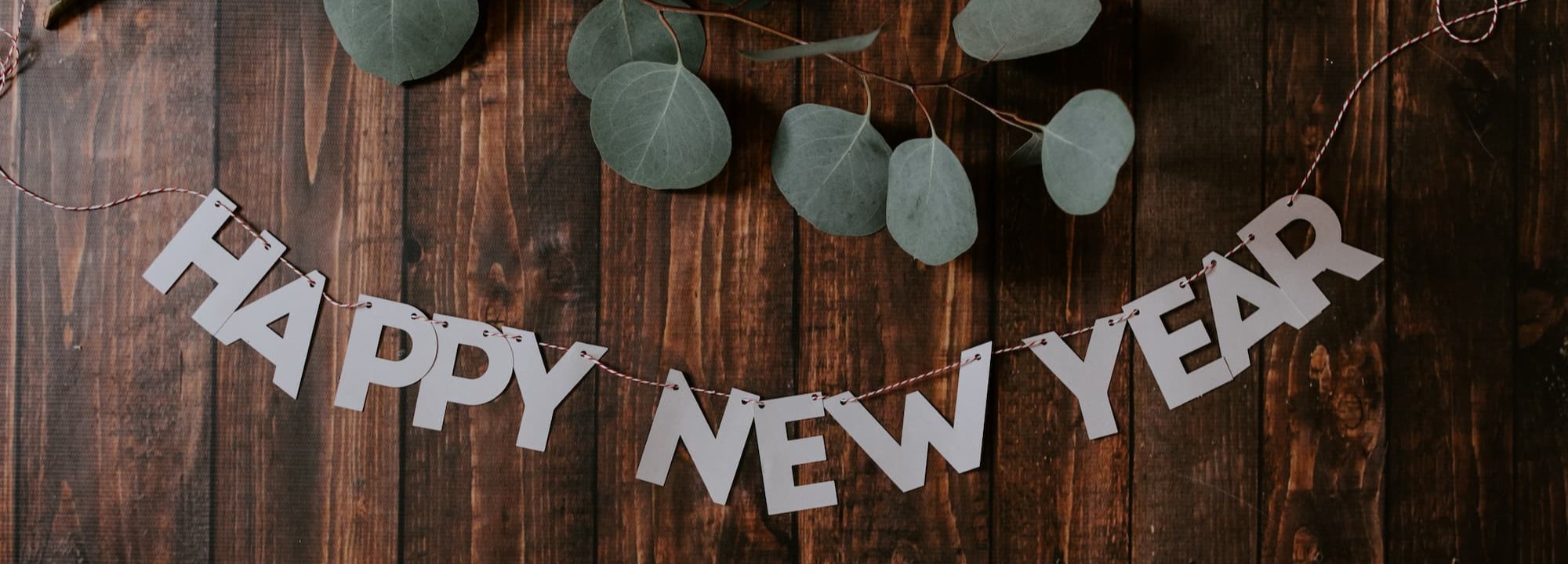
A great way to deal with food waste is to start a compost pile. If you’ve got a garden or even just a small back yard you could buy a compost bin or create your own heap. This is a natural way to recycle waste food and create fertiliser. Learn how to compost.
This year make your motto ‘give away don’t throw away.’ Dontate clothes, toys, books, electricals, and more to charity shops, friends and family, or community groups rather than chucking them in the bin. It gives the items a new lease of life, reduces waste, and saves others money.
Try to throw as little rubbish as possible into your general waste bin. Aim to check anything you’re about to dispose of with general waste and work out if you can recycle or reuse it. If you can’t recycle it in your household recycling bin, make a pile for items to take to your local household waste recycling centre (HWRC).
Workplaces should make a New Year’s resolution to increase recycling rates too. An easy way to start this is by introducing more recycling bins for different materials that are easy to access. Consider separate bins for cardboard, plastic, glass, metal, and food waste – or smaller businesses can combine with one dry mixed recycling bin.
Homes and businesses can do more to reduce food waste this year. Simply buying less food is a good place to start – make a list of what you need and stick to it. Rotate food in your pantry and fridge to ensure items with the shortest date are used first before they expire.
Preparation waste is unavoidable when working with some ingredients, which is where soups are the saviour. Use vegetable peel and scraps as the base of a tasty soup rather than throwing them away. Look for other recipes where you can use leftovers to eliminate food waste and add a fresh dish to your repertoire.
Aim to avoid buying anything that can’t be recycled, reused, or donated. Stay away from food, electrical items, clothes, and other goods in non-recyclable packaging and any items made from non-recyclable materials like certain plastics. Over time you’ll start to make it a habit to check if something is recyclable or reusable, gradually giving them up.
Purchasing larger packets of food means the ratio of packaging to its contents is smaller, which reduces waste. It’s often cheaper in the long run to buy in bulk as well. If you’ve got storage space then stock up on dry goods such as cereals, pasta, and coffee in big boxes, which saves on the number of shopping trips too.
Want more ideas for ways to reduce waste in your home or business this year? Explore our expert guides and find out how to reduce specific waste types and rubbish across various industries.
The Welsh Parliament (the Senedd) passed a new law in the last week of November – the Workplace Recycling Regulations. This will change how all workplaces across the country store, manage and dispose of commercial waste from the start of April 2024.
Businesses, charities, and public and third sector organisations must separate certain recyclable materials and arrange collection away from other waste. Essentially, it means workplaces will legally have to separate paper and card, glass, packaging, food, electrical, and textile waste for recycling like most households already do.
The Senedd is making this a legal requirement to improve recycling rates in Wales and move the country closer to becoming a zero-waste nation and reducing carbon emissions. Failure to comply could result in a fine for your business.
Learn all about the new Workplace Recycling Regulations and how to prepare for them with Business Waste.

The Workplace Recycling Regulations is a new law that legally requires all workplaces in Wales to separate certain waste materials and arrange collection separate from other waste. Businesses, charities, and public sector organisations will need to use bins or containers to store paper and card, glass, packaging, food, unsold small WEEE, and unsold textiles.
Workplaces will no longer be able to put all waste in a single bin if it includes any of these recyclable materials. However, you can use one bin for paper and card, and another to collect metal, plastics, and cartons (packaging) together. Glass must be collected on its own.
It also affects the disposal methods of food waste, recyclable rubbish, and waste wood. Under the new law, there’s a ban on sending:
Failure to follow these new Workplace Recycling Regulations could result in a fine for your business, charity, or third sector organisation.
The Workplace Recycling Regulations in Wales come into force from 6 April 2024. After this date, all businesses, charities, and public sector organisations anywhere in Wales must ensure relevant waste materials are collected separately and disposed of appropriately.
The only exceptions are NHS and private hospitals, which have an extra two years to comply with the regulations. Plans to reform workplace recycling in Wales were outlined over the summer, but the law was officially passed in the Senedd during the last week of November 2023.
Changes to the law around workplace recycling in Wales aim to help the country work towards becoming a zero-waste nation and reducing carbon emissions by 2050. Recycling rates for households in Wales are already high compared to most other countries. Just over 65% of materials collected by local authorities from homes are recycled.
The new Workplace Recycling Regulations aim to replicate these results for businesses and improve recycling rates in Wales across the commercial, charity, and public sectors. Separating and sorting recycling in workplaces should ensure greater volumes of high-quality recycling are produced and much less waste is sent to landfill and for incineration.
There’s also an economic boost by increasing recycling rates across Wales. It helps to keep materials in use for longer, which tackles the rising cost of materials and reduces how much landfill tax businesses pay for their waste management. Greater recycling should also create new and more job opportunities.
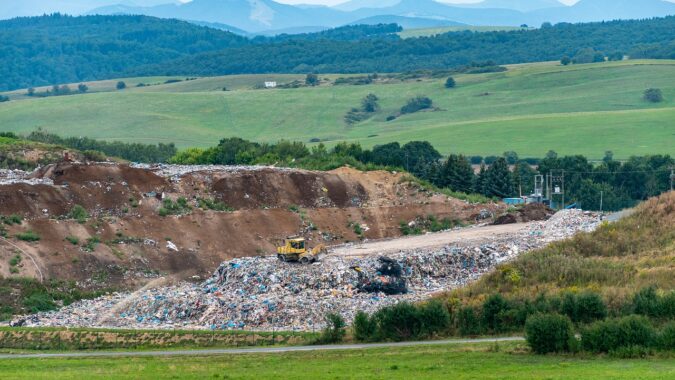
Under the new Workplace Recycling Regulations, certain waste materials must be collected separately. This aims to avoid contamination and increase the quantity and quality of individual recycling streams. The following waste materials must be stored and collected separately from other rubbish:
You can’t put all your waste in one bin if any of the above materials are present. For example, you can’t throw away paper, glass, and cartons in a general waste bin. This means your business in Wales could need up to six extra bins from April 2024 to comply with the new regulations, depending on what waste types you generate.
Get help with Business Waste as we can provide a wide range of recycling bins for free to separate waste types anywhere in Wales. There are no delivery or rental charges, you just pay for collection.
Any premises in Wales that create more than 5kg of food waste a week must arrange separate collection of their waste food, so it doesn’t go to landfill. This includes restaurants, cafes, takeaways, hotels, pubs, catering companies, and canteens in offices, schools, nursing homes, hospitals, and anywhere else that serves food.
The new regulations also stipulate that workplaces must not dispose of any food waste down the sink or drain or into a public drain or sewer. You must not use a macerator or similar technology like enzyme digesters or de-waterers to dispose of food waste down the sink or drain either.
Every workplace in Wales is required to follow the new Workplace Recycling Regulations. This includes businesses, charities, and public sector organisations. The occupiers of a workplace must ensure recycling is separated for collection and the new law is followed whether you own, lease, rent, or temporarily occupy the premises.
For any workplace in a shared location, the individual organisations are responsible for complying with the regulations. If a central recycling system is required then you might need an agreement in place with the landlord or facilities manager. The regulations also cover waste and recycling collectors and processors who manage household-like waste from workplaces.
The new workplace recycling law applies to all workplaces in Wales, including:
Natural Resources Wales (NRW) will be responsible for overseeing the separation requirements for recycling materials and the ban on waste going to incineration and landfill is upheld. Local Authorities in Wales will regulate the ban on food waste disposal in sewers from workplaces within their regions. Failure to comply with the new regulations could lead to a fine for your organisation.
The earlier your organisation prepares for these new regulations, the easier it will be to ensure compliance and avoid the risk of a fine. As with any commercial waste collection, only licensed waste carriers must remove and handle the rubbish your organisation produces. To ensure it’s managed responsibly you should receive a duty of care certificate.
A few key steps to prepare for the Workplace Recycling Regulations in Wales:
At Business Waste we can help organisations in Wales comply with the new law with our commercial waste services. We provide free bins to separate your recycling and ensure it’s recycled away from landfill and incineration – you only pay for collection. Licensed waste carriers will remove your waste and you receive a free duty of care certificate too.
Get a free quote for recycling and waste collection in Wales today – call 0800 211 8390 or contact us online.
Christmas is the season of giving. But that doesn’t mean presenting your binmen or waste collection company with gifts of extra rubbish to remove this year. It happens though, as UK homes create almost a third more waste over the festive period – and businesses aren’t much better.
For example, around 227,000 miles of wrapping paper and 270,000 tons of food are chucked out every year at Christmas. It’s enough to turn Rudolf’s nose red with anger. Check out our Christmas waste facts for more shameful stats about how much rubbish we churn out every holiday season.
There are many ways to be sustainable at Christmas and give back to the environment. Your decorations, food, and celebrations can be as green as one of Santa’s elves’ outfits with a little effort. Use these sustainable Christmas ideas to enjoy the most wonderful time of the year in an eco-friendly way.

The most sustainable Christmas trees are real ones grown locally in the UK. Once cut a new tree can be planted and grown, which is highly sustainable. Ones sourced locally require less transport, fuel, and carbon emissions too. You should check if any tree is from a sustainable forest (or FSC-certified) before you buy.
Other sustainable Christmas tree ideas include renting a real tree rather than buying one. This can be cost-effective and ensures the tree is replanted in the new year. The tree can have a positive impact on the environment and wildlife throughout the year and be used again next Christmas.
What you do after Christmas with your tree is vital for sustainability. Real trees take 10 to 12 years to grow so it’s ideal to replant them in your garden or pass them on to a certified forest. If you have an artificial one, hold onto it and reuse it in the future, as many are plastic and hard to recycle due to containing a combination of materials.
In the UK we spend more than £20 billion on Christmas presents every year. Unfortunately, plenty aren’t that sustainable due to packaging and the products themselves. Greater awareness and eco-focus mean there are more options available to buy sustainable Christmas gifts and ideas for creating your own.
Wrapping paper, tags, and bags also contribute to how sustainable any Christmas presents you give out are. Use our tips to reduce Christmas wrapping paper waste. Reusing paper from last year, sourcing recyclable wrapping paper, and using reusable bags are simple steps towards sustainability.
It’s estimated that we send around eight billion Christmas cards in the UK every year. That’s an awful lot of trees chopped down for the paper and card to make them all. Most Christmas cards are recyclable and therefore fairly sustainable, although those featuring glitter, glue, and plastic are trickier to recycle.
Recycling Christmas cards also requires energy and effort, so a more sustainable option can be to consider sending an e-card or simply don’t bother this year. Finding a cute Christmas picture and sending it to friends and family over social media, WhatsApp, or email could suffice and use zero paper and card.
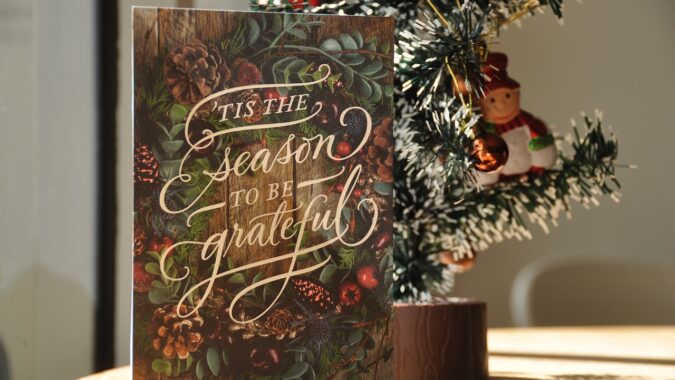
The Christmas party season is a fun time that leads to plenty of excess – eating, drinking, and dancing more than usual. Often it includes creating excess waste too, with loads of leftover food, decorations thrown away, and plastic plates and cups binned. But it doesn’t have to be that way.
A little bit of preparation can create a sustainable party whether you’re planning the work Christmas do or arranging a festive get-together at home for friends and family. Considerations covering the food, decorations, activities, and recycling can help reduce how much waste your celebrations create and ensure there’s less cleaning up afterwards.
As most people only wear Christmas jumpers in December they’re not always the most sustainable clothing items. Keep yours for a few years and it can be better for the environment though. A few ways to source a sustainable Christmas jumper include to:
Tinsel is terrible for the environment as the PVC film and metallic coating can’t be separated and recycled. Thankfully, there are many eco-friendly alternatives for decorating your home or workplace in December. These include making a sustainable Christmas wreath from natural items to stringing up solar lights outside or on your Christmas tree.
Handmade decorations, sustainably sourced baubles, and table decorations – including sustainable Christmas crackers – are essential. Avoid plastic decorations and those that use a combination of materials as they’re harder to recycle. One of the most sustainable actions is to simply use the same decorations from last year and store them for many years to come.

The equivalent of around seven million bins full of waste food are produced in the UK over Christmas every year. That includes millions of mince pies, sprouts, turkeys, Christmas cakes and pudding being thrown out. Smart shopping, portion control, saving and using leftovers in other recipes can all help reduce food waste for your festive feasting.
There’s a hidden cost of advent calendars, as many include single-use plastics that are bad for the environment. Sweet and chocolate wrappers aren’t always recyclable and many end up in landfill. But advent calendars are great for getting kids (and some adults) into the Christmas spirit.
Buy or make a sustainable advent calendar that has as little packaging as possible. Plenty are made purely from cardboard that’s easy to recycle. Alternatively, create your own for a waste-free option. It’s important you recycle or reuse the advent calendar next year after the big day for a fully sustainable solution.
Looking for more ways to reduce waste and celebrate a sustainable Christmas this year? We’ve put together a range of expert guides with tips and advice about reducing waste at home and work this festive season.
Umbrellas protect against the UK’s frequent wet and windy weather. The battering they receive from numerous storms adds up after a while though, tearing the material and sometimes snapping their spokes. If you’ve popped up a parasol for the last time or struggled as your umbrella turned inside out once too many, it’s probably time to get rid of it.
Around 1.45 million umbrellas are sold every year in the UK to help keep us dry on those all too common grey and drizzly days. Sales have also increased over the past few years with more than £14 million spent annually on new umbrellas. But what do you do when one reaches the end of its life?
Recycle an umbrella rather than chucking it in the bin where there’s a chance it could end up in landfill. There are various ways to reuse and recover the materials of a broken umbrella. Discover some great umbrella recycling ideas in this guide.

There are various types of umbrellas and each one is made from a combination of materials. These usually include a mix of metal, wood, plastic, and fabric. The different materials they contain make umbrellas tricky to recycle. Unfortunately, you can’t simply put them in your household recycling bin.
Don’t throw away a broken umbrella in your general waste bin at home or work either though, as it could end up in landfill. Instead, the best option is to break up an old umbrella into its different materials to recycle them separately at your local household waste recycling centre (HWRC). Separate and recycle each part of your old umbrella:
You’ll also need to responsibly dispose of the cover as well as the umbrella. This is often a thin piece of fabric similar to the material used for the umbrella’s canopy. Most modern umbrellas have covers made from nylon or polyester but check the material to ensure it’s recyclable.
If it’s made of a type of fabric then you should be able to recycle it with other textiles. Either find a clothing or textile bank or take it to your HWRC and recycle it in the specific textile bin. For any plastic umbrella covers check the plastic type and recycle with other plastics if possible.
Various businesses can find themselves with umbrellas they need to dispose of as well. It could be shops with excess umbrellas they can’t sell or damaged stock, umbrellas left behind after an event such as a festival, or even manufacturing firms that produce umbrellas having broken items they need to get rid of from a factory.
Umbrellas that any type of business wants to recycle or dispose of class as commercial waste. If your business has lots of old, unused, or broken umbrellas it no longer needs then you must arrange commercial waste collection. Licensed waste carriers will remove them and transport them to a waste management facility for recycling and responsible disposal.
Call 0800 211 8390 or contact us online for a free quote to collect and dispose of your commercial umbrella waste.
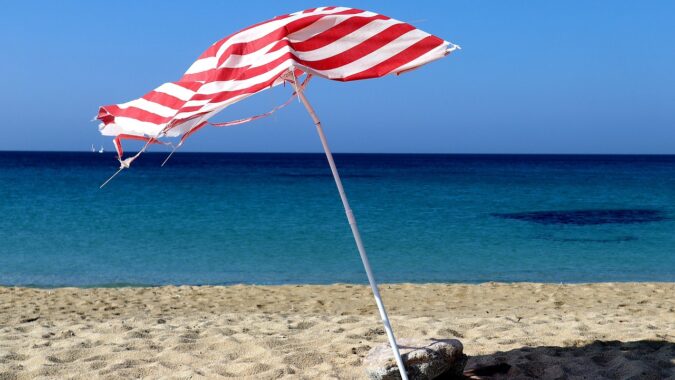
A broken umbrella will be as useful as a chocolate teapot when the next storm comes. Consider fixing it before throwing it away though. It’s always best to reduce waste and reuse before recycling, as it saves resources, time, and effort. How to fix a broken umbrella depends on what parts are damaged.
A few ways to fix a broken umbrella:
There are many ways you can reuse an old or broken umbrella even if it won’t keep the rain or sunshine out any more. Upcycling umbrellas helps to reduce waste, keep them out of landfill, and save on the energy and resources required for recycling. Plus, it puts them to good use in other ways.
Here are a few easy ideas for upcycling by turning your old umbrella into a:

Every 5th November the UK’s night skies light up with the colours, sounds, and smells of burning bonfires, extravagant fireworks, and sweet toffee apples. Millions of people attend public firework displays while plenty throw Bonfire Night parties in their gardens. Like most celebrations though, these create lots of extra waste.
Bonfires aren’t good for the environment, the rubbish from used fireworks isn’t recyclable, and there can be more food waste produced with discarded toffee apples and trays of parkin cake. However, we don’t want to extinguish the fun of the 5th of November.
Instead, this guide outlines ways to ensure your celebrations are as low-waste and eco-conscious as possible. Plot how to enjoy Guy Fawkes Night in a low-waste way with these environmentally friendlier Bonfire Night party ideas.
A few facts about the environmental impact and safety stats associated with Bonfire Night:
Setting off fireworks and having a bonfire in your garden is a fun way to celebrate Guy Fawkes Night but it’s not the most sustainable option. Many councils, pubs, and community clubs host their own Bonfire Night parties. There are many reasons why attending a public display is better for the environment, as it:

There are plenty of ways to reduce waste and your environmental impact if you’re planning a Bonfire Night party at home. Fireworks are the main focus of the evening, so ensuring these are as environmentally friendly as possible is vital. A greater awareness of the effect fireworks have on the environment means there are now eco-friendly options available.
Eco-friendly fireworks are made with a nitrogen-based fuel that burns cleaner and produces a lot less smoke. They’re designed to reduce atmospheric pollution caused by traditional fireworks that have charcoal and sulphur fuel. Currently, they’re not as easy to find but making the effort to source eco-friendly fireworks is worth it for a sustainable Bonfire Night.
Fireworks aren’t environmentally friendly, and they can’t be recycled whether they’re used or not. Unfortunately, paper wrapping, plastic packaging, and any wooden sticks with fireworks aren’t recyclable due to contamination. Responsible disposal is vital to avoid accidental fires. Here’s how to dispose of fireworks safely depending on their type:
Sky lanterns are a more recent addition to some Bonfire Night celebrations. They might look impressive illuminating the night sky but they’re terrible for the environment and quite dangerous. This is because sky lanterns are essentially pretty bits of rubbish on fire floating around that eventually fall to earth.
The fuel that lights and lifts off the sky lanterns isn’t great for the atmosphere but it’s when they land that the problems start. They can set fire to dry materials near where they land, choke or get caught up in any animals, and end up in our waterways. Skip the sky lanterns this Bonfire Night.
Burning rubbish might sound like a great way to avoid any non-recyclable waste ending up in landfill, but you should avoid this. Building a bonfire with household waste, plastics, wet wood, and many other materials can pollute the air, create lots of smoke, and an unpleasant smell.
Burning many waste types is also illegal with a potential fine of up to £50,000. As well as environmental concerns there are also safety risks, so fires must be held in a secure place with plenty of water nearby. If you’re planning a bonfire then here’s how to have one in the most environmentally friendly way:

Throwing an effigy of Guy Fawkes onto a bonfire is a tradition that goes back hundreds of years. The most environmentally friendly action is to not bother making a Guy as it introduces extra materials that may release toxic emissions when burnt. There are a few ways to make it a bit eco-friendlier though.
Find some old clothes, such as a shirt and trousers or a pair of pyjamas. Ideally, these should be in a state beyond reuse, such as ripped or stained. Lightweight items made from untreated natural fibres like cotton or linen are best as they should burn quickly, easily, and release fewer toxins.
Make the head from an old linen pillowcase. Avoiding plastic or synthetic materials prevents the release of harmful chemicals. Then stuff the clothes and head with old and dry paper (including newspaper). Use some string or thread to tie up the wrists, ankles, and any other gaps, and then he’s ready for the bonfire.
There are sure to be plenty of autumn treats and drinks flowing at your Bonfire Night party. Careful planning helps reduce and even eliminate any food waste and packaging waste being created. Here are a few easy ways to reduce food waste on Guy Fawkes Night:
The Department for Environment, Food & Rural Affairs (Defra) revealed reforms to bin collections and the UK’s waste system at the end of October 2023. These proposals have been dubbed ‘Simpler Recycling.’ They aim to increase, improve, and standardise recycling and waste collections by local authorities across the country for households and businesses.
This should get rid of the current ‘postcode lottery’ where homes in some areas of the country can recycle materials like glass in their domestic recycling bins, while others can’t. The plans also aim to crack down on waste crime, which costs England £1 billion a year, through mandatory digital waste tracking.
There’s a deadline of the end of March 2026 for most of the proposed changes, so there’s plenty of time to get to grips with them. Understand what Defra’s simpler recycling plans are and how they could affect your business with these answers to your common questions.
Note: Simpler Recycling reforms are not currently in force and the proposed changes and timeline could change. Below is all the current information and expected dates about the plans available. You can find more information on the UK government website.
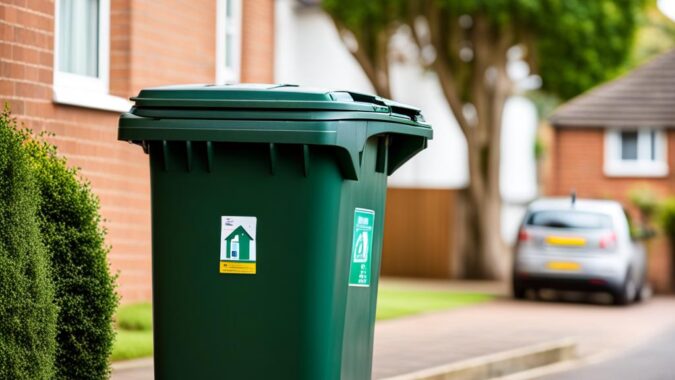
Defra’s simpler recycling reforms will affect households, businesses, and waste carriers. It will change bin collections for households to ensure more materials are recycled and that all homes in England receive the same waste collection services. You should also be able to recycle the same materials at work as you can at home under the proposed reforms.
The main changes that Defra’s simpler recycling is set to introduce are:
There are three main reasons why Defra is set to update the current waste system – to improve recycling rates, simplify waste management, and crack down on waste crime.
Household recycling rates in England have grown from 11% in 2001 to 42% in 2022. However, they’ve stagnated and missed the target of reaching an average of 50% by 2020. Ensuring all domestic waste collections include the seven core recycling streams should improve recycling rates towards the UK’s household waste recycling target of 65% by 2035.
Applying Defra’s simpler recycling scheme across all households and businesses will mean the same materials can be recycled at home or work anywhere in the UK. This removes the current ‘postcode lottery’ about what can be recycled where and avoids any confusion. It should encourage manufacturers to design sustainable packaging that’s recyclable anywhere in the UK, helping boost recycling rates.
Around 18% of waste in England might be managed illegally according to the Environment Agency. This can have a hugely negative impact on the environment and businesses and costs the economy in England £1 billion a year. Reforming the licensing system for waste carriers, brokers, and dealers with mandatory digital waste tracking aims to centralise reporting and reduce illegal waste activity and its negative impact.
The bulk of Defra’s simpler recycling plans aim to be in place by the end of March 2026. However, it’s believed collections of core recycling materials from businesses, schools, and hospitals should be in force earlier by March 2025. Collection of plastic film is also set for later, presumably due to the difficulty of recycling such material.
The main three dates for the changes to bin collections are:
Businesses will need to arrange collections and recycling of all food waste, glass, metal, plastic, paper, and cardboard they produce by licensed waste carriers. All businesses, schools, hospitals, and other ‘non-household municipal premises in England’ must arrange collection for recycling or composting of the same recyclable waste streams as households under Defra’s new plans – excluding garden waste.
These arrangements must be in place by the end of March 2025. Using commercial waste collection services and licensed waste carriers should ensure compliance with the new plans. You could use separate bins for each recycling stream or dry mixed recycling bin collections to combine paper, cardboard, plastic, and metals for ease.
The government plans to hold a consultation about the definition of ‘non-household municipal premises.’ Depending on the outcome of this it could mean places of worship, prisons, charity shops, and residential hostels are included and will also need to arrange recycling collections in line with the new plans.
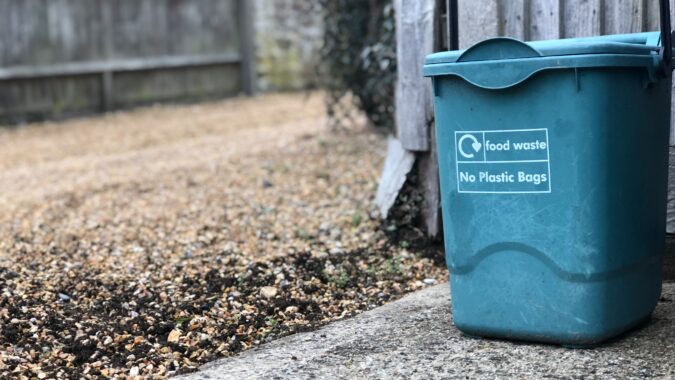
There are plans to overhaul the system that tracks how waste is handled and the ways data is collected with mandatory waste tracking. The exact details are yet to be released but it should improve detection of waste crime by regulators. New systems will record information from the point waste is produced to when it’s disposed of.
This provides regulators with all the information and evidence required to hold waste criminals to account. An increase in background checks for organisations and individuals who move commercial waste is set to be introduced too. These should make it easier for regulators to identify rogue operators and make it harder for unlicensed waste carriers to get work.
Most of the reaction has been positive but a few concerns have been raised. An announcement was initially promised by the end of 2022. With nearly a year’s delay, it wouldn’t be a surprise if deadlines are pushed back again and could make implementation challenging due to this initial delay.
The commingling of materials was also highlighted as disappointing with a preference for enforcing the separation of cardboard and paper as a minimum. This would increase the quality of recycled paper and cardboard produced by removing contamination. However, it does mean fewer bins for households.
Greater detail on how simpler recycling will work with the emerging extended producer responsibility (EPR) regime for packaging is also required. And there are also worries about whether councils and local authorities will have the bins, vehicles, and systems in place in time to deal with the proposals.
You can prepare for these changes in advance and increase your commercial recycling with Business Waste. Get a free quote for any type of waste collection anywhere in the UK today – call 0800 211 8390 or contact us online today.
What to do with old candles when they’ve burnt out for the last time is important. Candles may seem like a green way to illuminate your space and add a warming atmosphere, as they don’t rely on electricity. Yet at the end of their life, you’re left with a jar, part of a wick, and some small bits of wax.
How to dispose of a candle responsibly depends on what parts of the candle you’ve got left, the condition, what materials they’re made from, and if you’re getting rid of a candle from your home or business. With the right steps, you can reuse and recycle candles in various ways.
Find out how to dispose of candles in this guide with ideas about what to do with old candle jars, leftover wax, and the wick.

To dispose of candles in the UK at home you must first separate the parts of your old candle. Start by scooping out any remnants of candle wax that remain at the bottom of the jar or candle holder. This should be put to one side for reuse or thrown away in your household general waste bin.
Most wax in domestic candles is made of paraffin, vegetable or animal fats, or oils. Recycling candle wax and recovery of this material isn’t economically viable for many local councils and authorities, so general waste is the only option for disposal in most cases. However, you can reuse the candle wax in various ways (see below).
Any remaining bits of wick should also be disposed of with your general waste as they’re not recoverable. If your old candle is in a glass jar then you should clean it out to remove any remnants of wax. Then take it to your local bottle bank or nearest household waste recycling centre (HWRC) to recycle your glass candle jar with other glass waste.
For any other types of candle holders or jars made from materials other than glass, check your local recycling collections. Many plastics can be recycled in your domestic recycling bin. A tea light can be recycled in most household recycling bins too, as they’re made from aluminium that’s highly recyclable. Ensure it’s clean and dry before recycling.
You can recycle glass candle jars with most other old glass bottles and jars. Empty out any leftover wax and wicks then take them to your local bottle bank or HWRC. Recycle glass candle jars in the mixed glass recycling bottle bank or the one for its specific colour.
To recycle glass candle jars from your business you put them in any glass bins you have and add them to your commercial glass waste collections. Again, you must remove any wax and wash out the jars before doing so. This removes contaminants and increases the chance of recycling.
Recycling glass candle jars is important as glass is fully recyclable. It can be endlessly recycled with no loss of quality and is used to create many new glass products. This saves on the energy and resources required to create fresh glass candle jars, resulting in a positive environmental impact.

Before recycling any glass candle jars or reusing the wax you need to separate the two. Using a knife and/or spoon to scoop it out sometimes works if the wax is soft and you use a bit of elbow grease (not literally). Often it’s too hard, but there are easier ways to get it out.
There are three main ways to clean out the wax from your candle jars before recycling them:
Rather than recycling candle jars when you’ve cleaned them out and emptied them, they have various other uses. This includes old candle jars made of glass, metal, plastic, or any other material. A few ideas of what to do with empty candle jars include to:
Any businesses with old candles and jars to dispose of must arrange commercial waste collection. It’s a legal requirement that only licensed waste carriers remove commercial waste from your premises, which includes old candles from shops, hotels, restaurants, and any other business. Use a professional waste management company that ensures recycling of your candles.
An easy way to dispose of candles from your business is to remove any wax and wicks, and then recycle them with your current commercial glass waste collection. Just like recycling candle jars at home, you can dispose of them responsibly at work with other waste glass bottles and jars.
This ensures all the candle jars from your business are recycled and turned into new glass products. It also saves you money on landfill tax by reducing the amount of waste you send to landfill. Arrange commercial waste collections to get rid of old candles whether it’s leftover stock, broken candles, or used ones from tables in a restaurant.

You can reuse candle wax after it’s been used in a candle. It just needs remelting and repurposing to use again as a fresh candle or for other things. If you melt it and mix it with another type of wax it can affect the smell, colour, and consistency.
Never pour candle wax down the drain, as it will cool, harden, and block your pipes. To reuse candle wax you first need to melt the wax left in your old candle jar in a bowl of boiling water or over a simmering pan. Once it’s melted there are a few ways to reuse candle wax to make a:
Small amounts of solid candle wax can be disposed of in domestic and commercial general waste bins. If you can’t or don’t want to reuse and recycle candle wax then it should be removed from the jar and thrown away. Never throw a glass jar in general waste as it’s 100% recyclable.
Ensure the wax is cool and dry – don’t throw away warm melting wax as it could stick to the bin or waste bag and pose a fire risk. Put it inside any other rubbish in the general waste bin, such as wrapping it in an empty crisp packet.
From 31 March 2025, most UK businesses must arrange separate food waste collections. Learn and prepare for the new food waste legislation in the UK.
The study participants included business owners and company employees, revealing unexpected findings about corporate environmental practices.
A digital product passport (DPP) shows data about an item’s environmental impact. Find out what digital product passports are and why they’re sustainable.
Food, packaging, and many single-use items are all thrown away when flying. Discover how to have a low-waste flight on your next trip with these tips.
Changes to the classification of ten waste wood items will come into play from 1 September 2023 in the UK. The new classification of these products as hazardous and potentially hazardous waste will affect both producers of waste wood (businesses) and recyclers. Understand the updated regulations to ensure the proper disposal of your wood waste.
The regulatory changes follow around five years of work and testing by the Wood Recyclers’ Association (WRA) to determine the hazardous waste content of various waste wood products. They mainly affect ‘amber’ waste wood items from the construction and demolition (C&D) sectors, though it could impact some other industries.
Learn all about these changes to wood waste regulations and what your business might need to do to ensure the safe, legal, and responsible disposal of your wood waste.

The Environment Agency (EA) is changing its regulation by withdrawing Regulatory Position Statement (RPS) 250 from 1 September 2023. It means ten wood items from buildings constructed before 2007 will now classify as types of hazardous waste. Wood recyclers won’t accept them unless they’ve undergone appropriate tests to prove they’re not hazardous.
RPS 250 was introduced in July 2021 to allow potentially hazardous ‘amber’ waste wood items from the construction and demolition waste stream to be moved and processed as non-hazardous. Under these new changes, they’ll automatically classify as hazardous waste and require specialist hazardous waste disposal.
The withdrawal of RPS 250 is happening after successful work by the WRA and UK regulators. They’ve collected evidence over five years as part of its Waste Wood Classification Project, which reduced the list of potentially hazardous C&D amber items to ten.
Ten items of waste wood from pre-2007 buildings now classify as hazardous:
There are four grades of wood waste that all classify as hazardous, non-hazardous, or potentially hazardous:
If your organisation produces any of the ten types of waste wood items from pre-2007 buildings they’ll now be treated as hazardous waste. This means you can’t dispose of the likes of external doors or roof timber from pre-2007 buildings with the rest of your wood waste.
Instead, you’ll have to book a separate hazardous waste collection for any of these ten items or arrange suitable testing. You can organise testing of your waste wood items and if it’s proven to not contain any hazardous elements then you can recycle it with the rest of your wood as normal. Confirmation of the test and results must be sent to the wood recyclers.
Research by the WRA estimates that less than 1% of waste wood from C&D activities will contain hazardous content. This represents a small amount of UK waste wood production of around 4,000 tonnes in total. The amount of these potentially hazardous waste wood items is also predicted to fall over time due to newer buildings being constructed and continued testing.

Household wood waste is regulated by RPS 249. This covers when household waste recycling centres (HWRCs) can accept domestic hazardous waste wood and store it with non-hazardous household waste wood. It was introduced on 1 August 2021 and will be withdrawn by 1 April 2024.
Testing of household wood waste is ongoing. The WRA is currently sampling and testing household waste wood types, with expectations that it may confirm hazardous content is falling and expected to disappear. If you currently have domestic wood waste to recycle, check with your local HWRC for what they accept.
The regulation changes mean most wood recyclers will update their acceptance criteria to exclude the ten types of hazardous wood waste. This is because most wood recyclers don’t have the facilities to dispose of hazardous waste. Upgrading to accept and dispose of hazardous waste properly would come at a great cost to most wood recyclers to deal with only a small amount of waste.
Wood recyclers will continue to accept most non-hazardous wood waste. They can also take and recycle any of the ten potentially hazardous wood waste items if they’ve been tested and certified as non-hazardous. Disposing of hazardous wood waste through proper channels reduces the risk of contamination and ensures safe, legal, and responsible disposal.
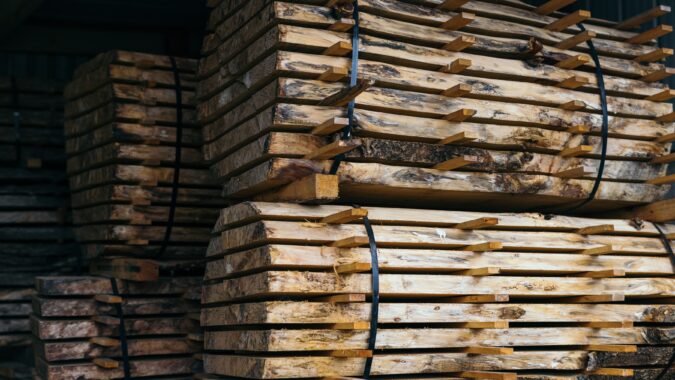
Book removal of any type and amount of waste wood your organisation creates anywhere in the UK with Business Waste. We can provide free bins and containers to store your waste wood securely on-site – you only pay for collection. All wood waste is diverted away from landfill where possible.
Our experts can advise on whether your wood may be potentially hazardous and work out the best solution for its disposal. Get in touch for a free quote for commercial wood waste collection today. Contact us online or call 0800 211 8390 and speak to one of our friendly team about your wood waste.
Brits look up tips to lose weight, delete Instagram, and make pancakes over 70,000 times more than recycling advice every month, according to recent online search engine data.
Around 8.5 billion Google searches are made globally every day. This includes millions in the UK that provide a good indicator of topics of interest to the public. But how many relate to recycling? Fewer than the number of people looking up ‘Barbie dream house’ combined it seems (36,000 searches a month).
According to what we’re searching online, most of us are more interested in learning how to solve a Rubik’s cube than finding out where to recycle batteries. With household recycling rates stagnating across the past ten years in the UK, could few searches for recycling tips and information signal a dwindling lack of interest in recycling by the British public?

“Data about what we search for online provides a clear indication of the topics that are most important to the general public,” says Business Waste representative Mark Hall. “For example, over spring and summer searches for Oppenheimer and Barbie rocketed as anticipation for both blockbuster films grew.
“Recycling isn’t seasonal, it’s a year-round activity. Unfortunately, our research suggests limited interest in learning how to recycle all sorts of materials in the home and workplace.”
To get a good idea of what items and materials Brits are most interested in recycling we looked at the most common search terms starting with ‘how to recycle…’ by volume. This was done using the Keywords Explorer tool from Ahrefs – provider of leading SEO (search engine optimisation) tools – and filtering to UK results.
The results highlight that people search most for information about how to recycle common materials like plastic, paper, and glass. Trickier items to recycle like polystyrene and light bulbs are also high on the list, as well as searches for recycling methods for the latest trend that’s hard to recycle – vapes.
These are some of the most searched-for ‘how to recycle…’ terms every month in the UK:
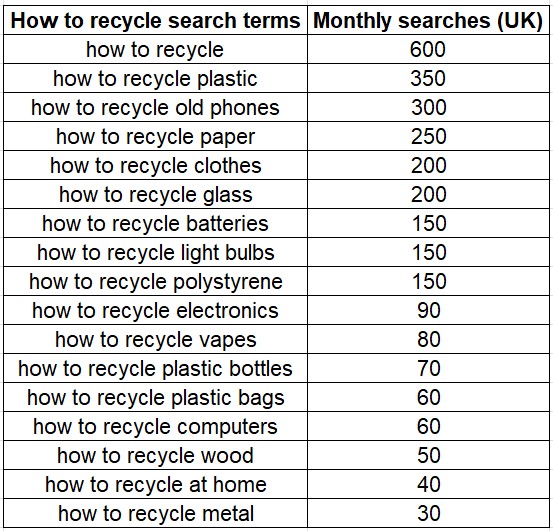
To provide some context, contrast the online searches for terms starting with ‘how to…’ that have the highest volume. There are tens of thousands more every month for a range of useful (and questionable) information. In some ways, it shows Brits care more about knowing how to delete their social media accounts than finding ways to recycle and dispose of waste properly.
“The fact that tens of thousands of us are searching for tips to solve a Rubik’s cube compared to just a handful wanting to know how to recycle plastic bottles suggests recycling has fallen down the list of priorities,” adds Hall.
“And for anyone interested, less than 10 people a month search for ‘how to recycle a Rubik’s cube’. We’d advise donating it to a charity shop or passing it on to someone else.”
These are some of the most searched-for ‘how to…’ terms every month in the UK:
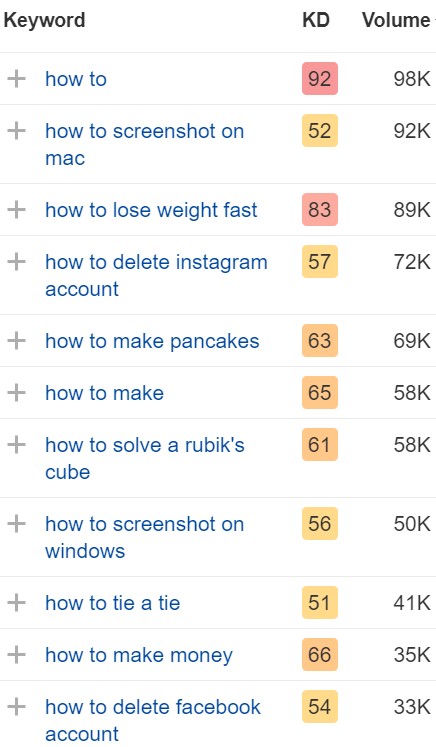
Online search data always throws up a few funny surprises and ‘how to recycle…’ terms are no different. There might not be many, but a few people are still trying to find out ways to recycle underwear (only if it’s clean!) and floppy disks (remember them?). Plus a few are seeking meta-information about recycling a recycle bin.
| How to recycle search terms | Monthly searches (UK) |
| how to recycle old underwear | 20 |
| how to recycle recycle bin | 20 |
| how to recycle toilets | 10 |
| how to recycle hair | 10 |
| how to recycle 3.5 floppy disks | 10 |
| how to recycle old keys | 10 |
| how to recycle cut grass | 10 |
Household waste recycling rates have more than doubled in England from 19% in 2003/4 to 44.1% in 2021, according to the latest government figures. However, stagnation means there’s lots of work for the UK to meet its waste recycling target of 65% by 2035.
Better education and awareness about what materials are recyclable and how to recycle common items for households and businesses is essential to achieve these goals.
“Online search data isn’t an exact measure of recycling activities and through our work we see many businesses and households upping their recycling efforts. As a general guide for trends and public interest, the low search volumes for many recycling terms are concerning. Most of us spend half our lives online, so hopefully a boost to recycling search terms will be represented with a real increase in recycling in the real world,” concludes Hall.
[1] https://www.oberlo.com/blog/google-search-statistics
[2] https://www.statista.com/statistics/444744/household-recycling-rate-uk/
[3] https://www.ons.gov.uk/businessindustryandtrade/itandinternetindustry/bulletins/internetusers/2020
[4] https://researchbriefings.files.parliament.uk/documents/SN06152/SN06152.pdf
[5] https://www.parliament.uk/globalassets/documents/post/postpn252.pdf
[6] https://www.gov.uk/government/statistics/uk-waste-data/uk-statistics-on-waste
[7] https://www.gov.uk/government/publications/progress-report-on-recycling-and-recovery-targets-for-england-2020/progress-report-on-recycling-and-recovery-targets-for-england-2020
Could chants of “we recycle more than you!”, “you’re unsustainable, and you know you are!”, and “who’s the ****** not recycling!” be bellowed from the terraces this season? If so, don’t expect to hear many in a Scouse or Brummie accent. That’s according to a revised Premier League table based on recycling rates in the areas of each stadium.
At Business Waste we used the latest data for household waste recycling rates across England to predict how this season’s Premier League could pan out. Rather than focusing on wins, draws, and losses, the rankings use the recycling rates of the local authority that covers every stadium’s location.
Data covering recycling rates for individual constituencies isn’t available, which means Everton and Liverpool are tied, as are Chelsea and Fulham. These teams are placed in alphabetical order (and given their positions, there aren’t any worries about bragging rights). To make things fair all data is from 2021/22, as government data for 2022/23 is yet to be released.

“Awarding points for the teams that win the most is all well and good, but it gets a bit boring when Man City lift the Premier League trophy at the end of the season again,” says Business Waste representative Mark Hall.
“To make things interesting this year and to highlight the differences between recycling in places across England and the work to be done, we thought it a good time to bring recycling rates into the equation.”
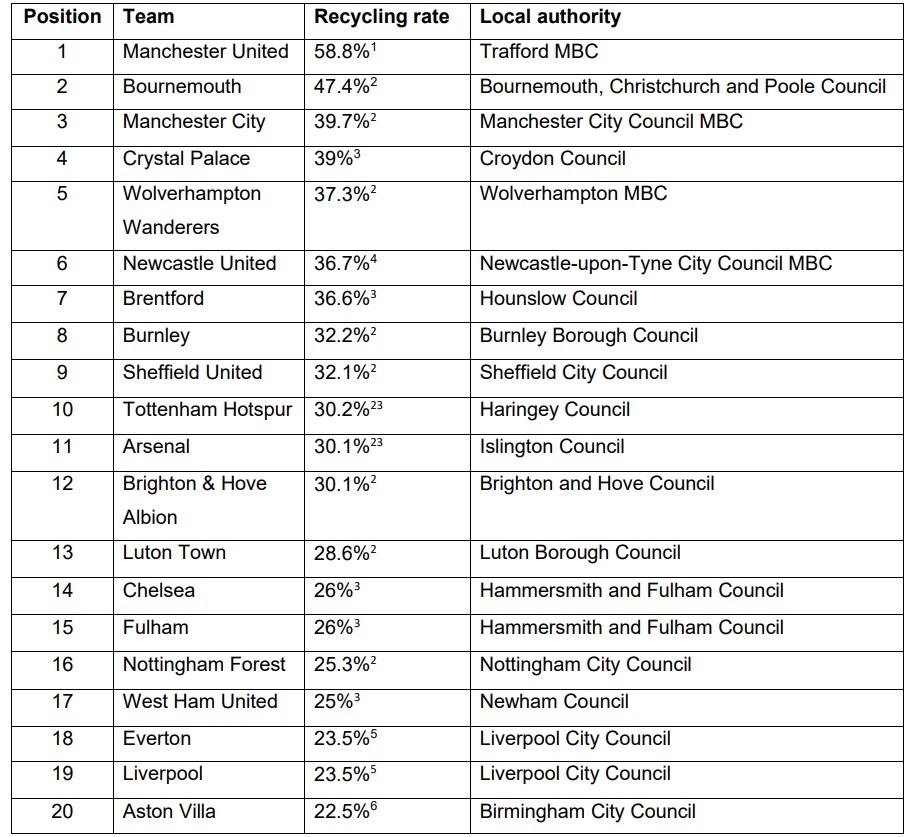
“Erik ten Hag will be hoping Trafford Council’s great work boosting recycling rates across the borough is replicated on the pitch if Manchester United are to topple their title-winning rivals across the city. And new Bournemouth manager Andoni Iraola would be working miracles should their position here comes to fruition in the proper Premier League table,” adds Hall.
“At the other end it might be another season of struggle for Everton and Forest, which won’t surprise many of their fans. Liverpool and Villa supporters are more likely to be up in arms if their local authority’s poor recycling rates are reflected in their results this season.”
The table shows there’s still plenty of work for most areas in England to reach the government’s target of recycling 50% of all household waste. While Premier League clubs can’t have a direct impact, they can all play their part to encourage increased recycling and sustainability for their clubs and fans.
Many teams are working towards a greener future. The Premier League Sustainability Rankings considers what clubs themselves are doing to improve their climate credentials. Last season Spurs and Liverpool came out on top, showing that while their local authorities may be falling behind they take sustainability more seriously. And unlike the recycling rate table, Bournemouth find themselves down at the bottom of the sustainability rankings.
Hall adds: “Given the huge amount of money floating around in football it’s about time more teams invested in sustainable waste solutions inside and outside their stadiums. Running a football club that’s as green as its pristine pitch should be the goal for every top-tier team in England.”

Run a football club, rugby team, tennis courts, or any other sporting organisation? Boost your recycling efforts with the help of Business Waste. We offer everything from waste audits and waste management plans to collections of any type and amount of recycling rubbish anywhere in the UK.
We can provide free bins for your recycling, so you only pay for collection. This helps separate your commercial waste and ensure as much as possible is recycled, benefiting the environment and your sports club. Get a free no obligation quote for waste collection in the UK today – call 0800 211 8390 or contact us online.
[1] https://www.trafford.gov.uk/residents/environment/recycling-rubbish-and-waste/Recycling-rate-%E2%80%93-how-well-are-we-doing.aspx
[2] https://www.letsrecycle.com/councils/league-tables/2021-22-overall-performance/
[3] https://data.london.gov.uk/dataset/household-waste-recycling-rates-borough
[4] https://www.newcastleworld.com/your-newcastle/newcastle-upon-tyne/thousands-of-tonnes-of-waste-from-newcastle-households-rejected-from-recycling-centres-4104245
[5] https://www.liverpoolecho.co.uk/news/liverpool-news/liverpools-woeful-recycling-rates-will-23398569
[6] https://birminghameastside.com/birmingham-at-the-bottom-of-the-recycling-table-and-no-change-in-sight/
From 31 March 2025, most UK businesses must arrange separate food waste collections. Learn and prepare for the new food waste legislation in the UK.
The study participants included business owners and company employees, revealing unexpected findings about corporate environmental practices.
Extended producer responsibility (EPR) is a new UK regulation that aims to increase the responsibility of businesses that supply or import packaging. It’s a reform to the current Packaging Waste Regulations that will change the management and funding of packaging waste. The costs of managing packaging once it becomes waste will shift to the producers rather than the consumers.
Any organisation in the UK that produces, supplies, or imports packaging will need to report packaging data and ensure EPR compliance when it comes into effect. In July 2023 it was announced that the full introduction of the UK EPR scheme will be pushed back by a year. Businesses should still start preparing for the scheme though.
Getting to grips with extended producer responsibility can seem complex before it’s enforced. Understand what EPR is and whether your business will be affected and need to make any changes with our detailed guide.
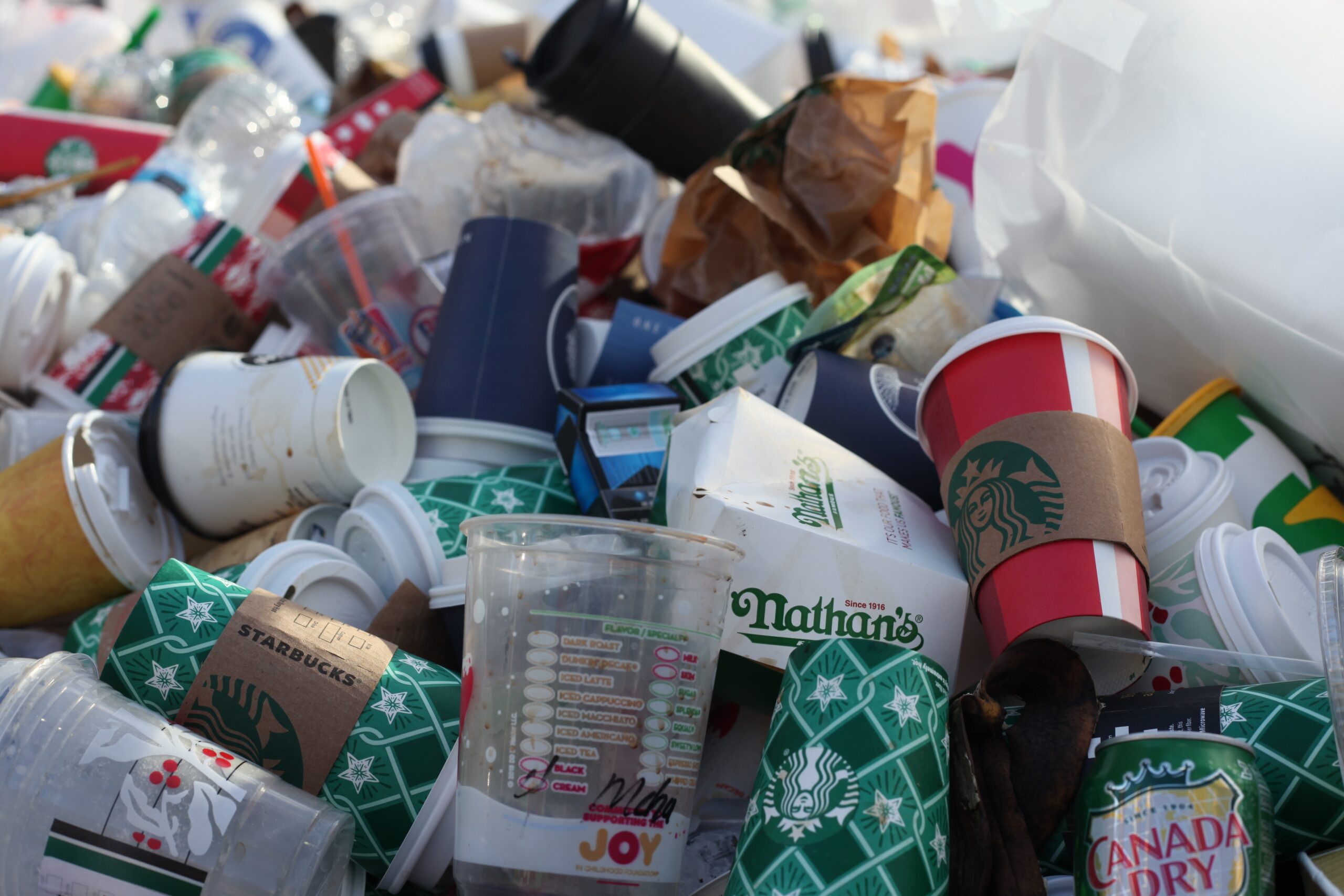
EPR is an environmental policy where the producer’s responsibility for a product extends to the post-consumer stage. In the UK, EPR refers to the new extended producer responsibility scheme for packaging waste. This means companies that produce, supply, and import packaging will be responsible for the costs of managing it once it becomes waste.
The new EPR scheme will move the cost to dispose of packaging waste from taxpayers to the producers. Organisations may need to:
The idea of EPR for packaging is that if the products created add to pollution, then the producer rather than the user should cover the costs of its impact on the environment and human health. EPR is set to build on and replace existing packaging waste regulations.
The UK produces more than 10 million tonnes of packaging waste every year. Around two-thirds of this are recyclable or reusable, yet vast amounts make their way to landfill sites across the country. By placing the responsibility and costs for packaging disposal on the producers, EPR aims to encourage businesses to develop more sustainable and recyclable packaging.
An increase in costs for packaging producers should kickstart an improvement in creating and using formats and materials that are recyclable. This should have a positive effect on the environment and reduce the associated costs for businesses, as recycling is more cost-effective than sending waste to landfill and other disposal methods.
Introducing EPR for packaging also helps the UK government make small steps towards its various environmental targets. This includes eliminating all avoidable waste by 2050 and reducing residual waste production per capita by 50% by 2042. The government is also following the example of other countries that have introduced EPR for packaging waste.
Research by The Recycling Partnership in the USA found a positive impact of EPR on packaging and paper when introduced in seven other regions. It found EPR increased the collection and recycling of target materials to more than 75% in British Columbia, Belgium, Spain, the Netherlands, and South Korea. In Portugal and Quebec, it was over 60%.
The EPR scheme applies to any organisation in the UK that supplies or imports packaging. Normally EPR applies to a brand owner or importer. This includes any business that:
If your business does any of the above then it will need to collect and report its packaging data. EPR regulations apply to any UK organisation that:
For example, imagine you run a food company with branded packaging for your goods. You supply supermarkets and other food retailers with your products that are sold to consumers in the UK. Here the food company must comply with EPR regulations. But if the food items were sold under the supermarket’s branded packaging then the supermarket would be responsible.
You do not have to act under EPR in the UK if you import goods in packaging that’s:
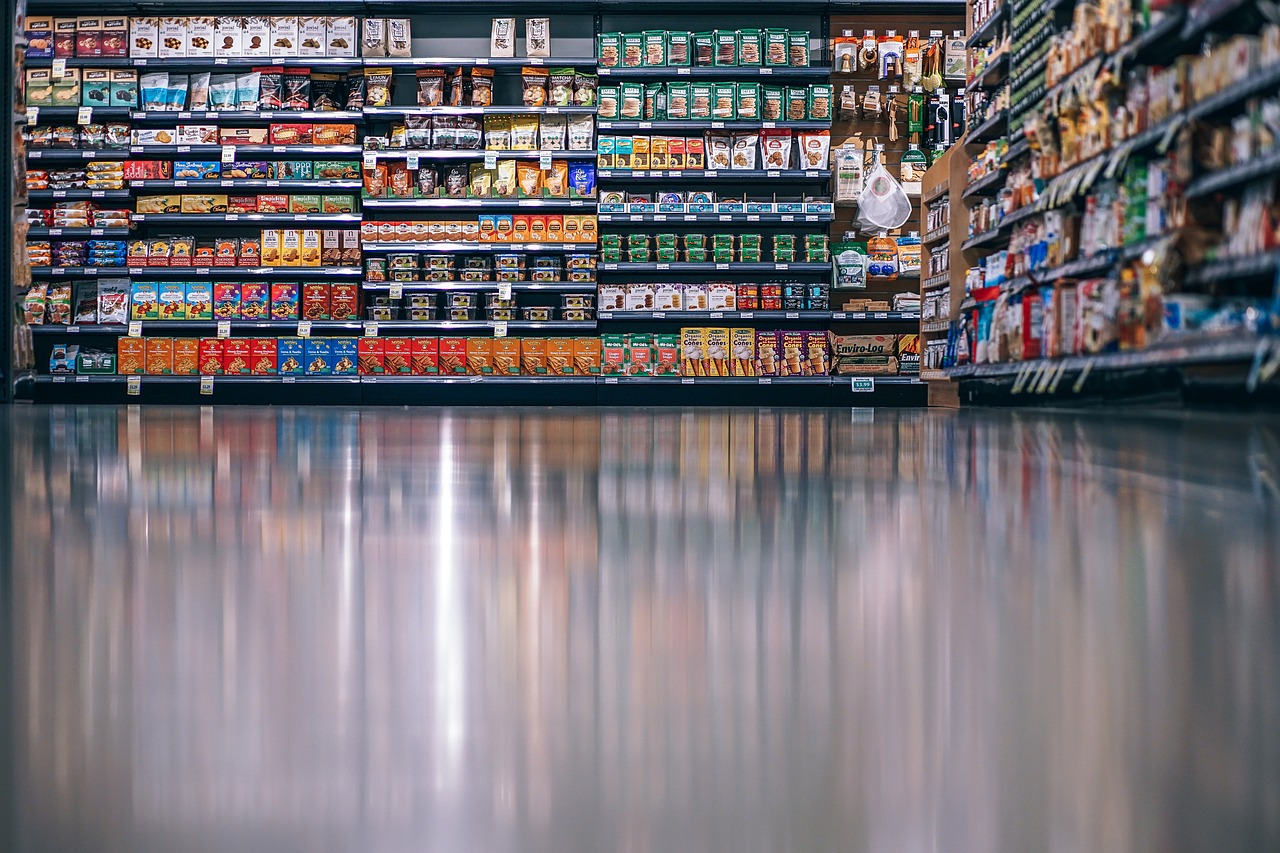
Extended producer responsibility requires all eligible companies to comply with the scheme. This involves submitting packaging data on time and covering the net cost of packaging waste management and disposal for their own products. Extended producer responsibility works by businesses following these general steps:
The Packaging Waste (Data Reporting) (England) Regulations 2023 came into effect on 28 February 2023. This means producers of packaging should already be collecting and reporting data about the amount and type of packaging they place on the market in England. Large organisations should have registered for the EPR packaging online service by April 2023, while for smaller companies it opens in 2024.
Large organisations in the UK must submit packaging data between 1 January 2024 and 1 April 2024 (this is to cover the period of 1 July 2023 to 31 December 2023). Small organisations should work to the same dates but for data from 1 March 2023 to 31 December 2023.
The introduction of EPR legislation is phased though. In July 2023 the Department for Environment Food and Rural Affairs (Defra) announced a delay for payments for extended producer responsibility (EPR) for packaging by a year, pushing it back to October 2025. Defra claims the delay is to help efforts to drive down inflation
From October 2025 onwards producers will pay fees based on the recyclability/sustainability of their packaging. The exact charges will depend on how widely recycled the material is and other factors. More detailed data on packaging materials will be necessary at this point compared to what’s reported in the current system.
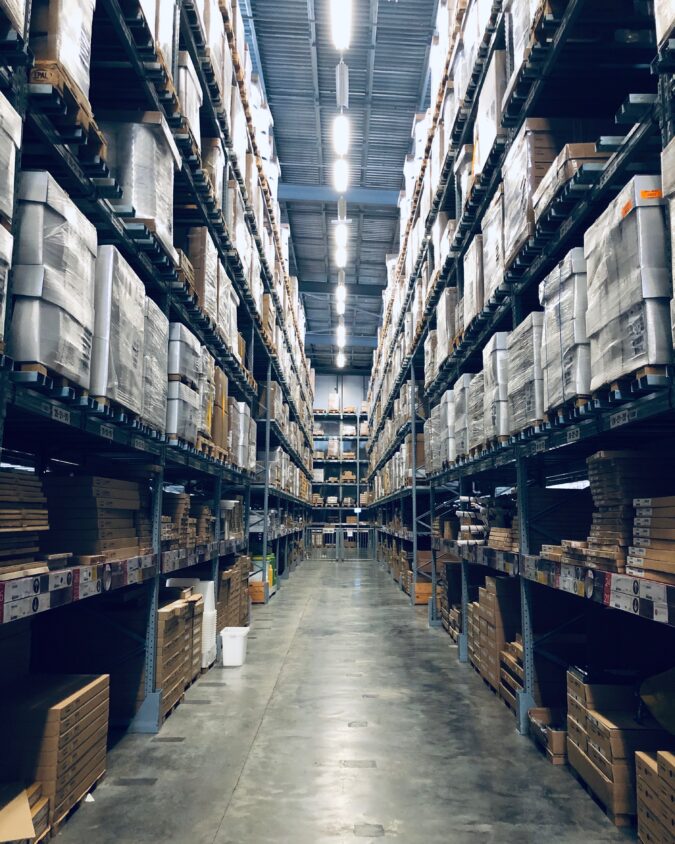
The exact cost of the new EPR tax is yet to be announced by the UK government. However, it will likely vary between businesses and depend on the amount and type of packaging supplied or imported. There may also be differences across nations and further measures and changes may apply to the EPR tax.
Under the new EPR scheme, 30% of plastic packaging must contain recycled content that’s placed on the UK market by a producer. A charge of £200 per tonne will apply to any plastic packaging with less than 30% recycled material.
One advantage of the delay to extended producer responsibility regulations is that businesses have an extra year to prepare for them. Understanding whether EPR legislation will affect your organisation and what you need to do is vital to comply with these new regulations. Important ways to prepare for EPR as a business include to:
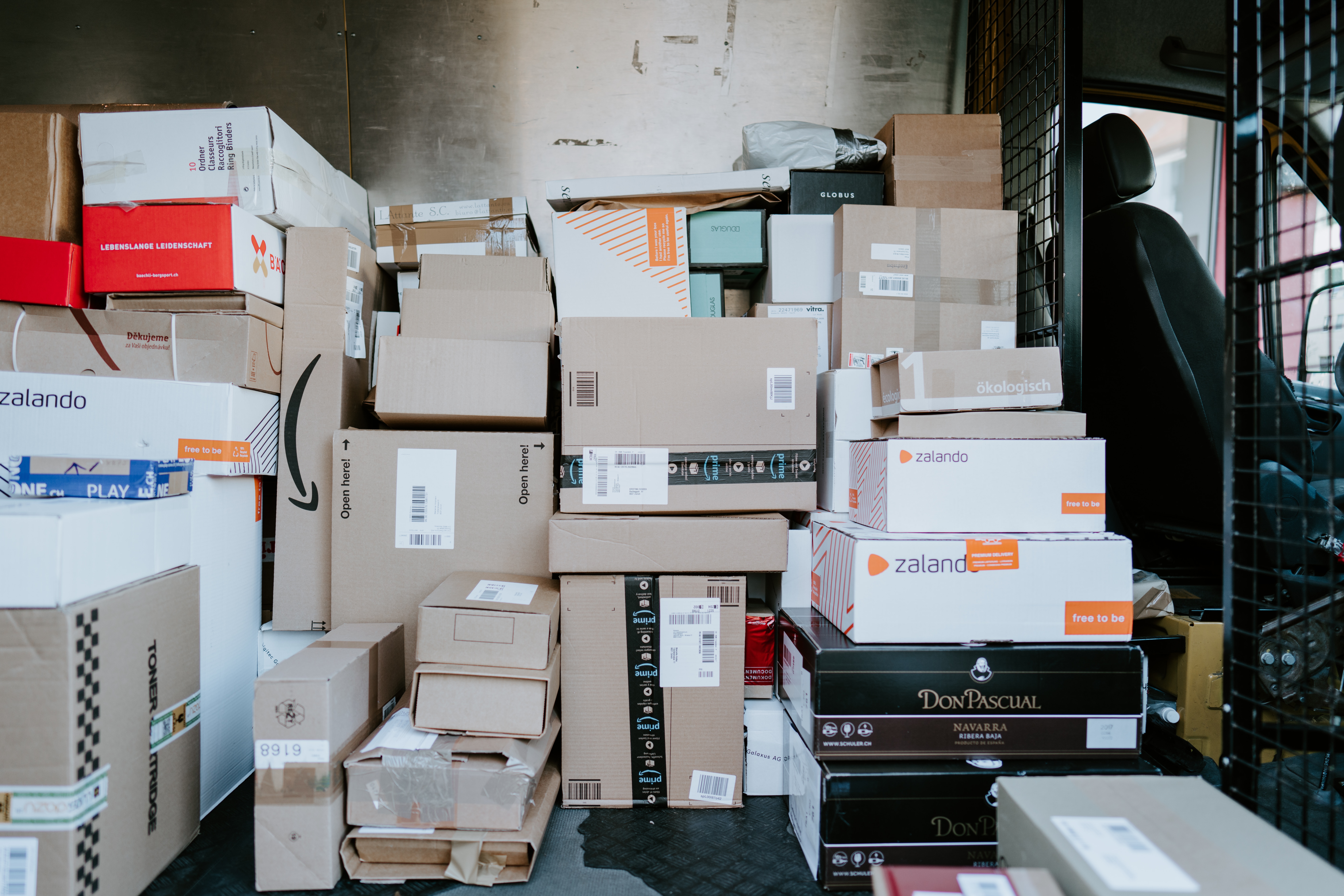
Extended producer responsibility (EPR) aims to have a positive environmental impact and transfer waste management costs to the producers. In the long run, it should benefit businesses, councils, and households, but there are still some concerns for the short term. There are various advantages and disadvantages of extended producer responsibility:
At Business Waste we have a team of experts who can help with any questions you’ve got about managing your packaging waste. We can provide free bins for all types and amounts of packaging waste with no delivery or hire fees – you only pay for collection. Regular and one-off removals are available.
Call 0800 211 8390 to speak to one of our experts about your packaging waste or contact us online with your query or to arrange a callback. We can also provide a free no obligation quote for packaging waste collection from your business anywhere in the UK.
Single use plastic cutlery, plates, and cups are cheap and convenient, but their disposal is problematic. They don’t break down and can leach chemicals, adding to pollution if they end up in landfill. Even though most single use plastics are recyclable only 10% of single use plastic items are recycled.
To reduce this negative environmental impact the UK government is introducing a single use plastic ban in England from October 2023. This follows on from the existing plastic ban on microbeads in 2018 and single use plastic straws in 2020. And there’s already a single use plastic ban in Scotland that came into force in June 2022.
If your business in England relies on single use plastic products in any form you should be adapting to comply with the ban. To help your organisation prepare for the ban on single use plastic we’ve answered the most important questions about it and provided some useful tips to remove single use plastics from your operations.

Single use plastics – also known as disposable plastics – are items made from plastic designed to be used once and then thrown away. They’re made from a variety of fossil fuel-based chemicals (petrochemicals) depending on the product. Common examples of single use plastics include disposable plastic cutlery, plates, and straws.
Up to 50% of plastic products are single use plastics around the world. This reflects the disposable lifestyle and culture that’s developed globally, and many industries rely on. While many single use plastics are recyclable lots end up in general waste, landfill, and as litter due to their throwaway nature.
Single use plastics aren’t biodegradable but will break down eventually. However, as they degrade it releases toxic chemicals from the additives used to create the plastic products. These can leach into the ground, water, and air, which adds to pollution levels and harms human health, wildlife, and the environment.
The single use plastics ban in England has the official legislative title of ‘The Environmental Protection (Plastic Plates etc. and Polystyrene Containers etc.) (England) Regulations 2023’. When it comes into force it will make it an offence for businesses to supply, sell, or offer specific single use plastic items and products in England.
The ban covers single use plastic:
There are a few exemptions to the England single use plastics ban for specific items:
There are no exemptions for supplying single use plastic cutlery and balloon sticks.
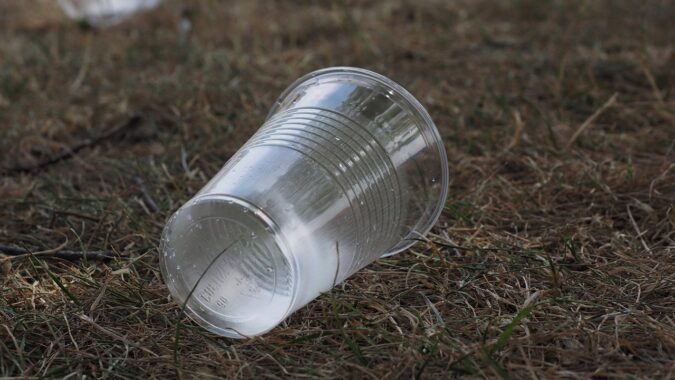
Local authorities will have the power to carry out inspections and ensure the new rules of the plastic ban are followed by all businesses. This includes the right to visit a shop or store, make test purchases, speak to staff, and ask to see records. Any business breaching the single use plastic ban may be issued with a fine.
The size of the fine may vary and cover the investigation costs. Complaints of breaking the law can be made to Trading Standards. The business should receive a letter detailing the offence and fine and the next steps, including the option to appeal within 28 days. Failure to comply with the notice may lead to criminal proceedings.
The single use plastic ban in the UK is being introduced across different dates for England, Scotland, and Wales:
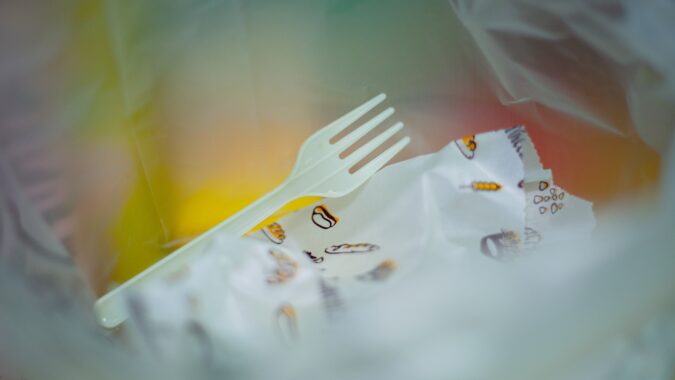
The main reason the UK government is banning single use plastics is to boost efforts to eliminate all avoidable plastic waste by 2042. Currently, in England, around 2.7 billion single-use cutlery items (mostly plastic) and 721 million single-use plates are thrown away every year. This ban aims to wipe out such waste.
Plastic cutlery was in the top 15 most littered items in the UK by count in 2020. And according to the European Commission, the 10 most common single-use plastic products found on European beaches account for 70% of all marine litter in the EU (alongside fishing gear).
Banning single use plastics means businesses will need to use and offer sustainable alternatives. Many single use plastics are tricky to recycle, so these alternatives should be reusable, compostable, or easier to recycle. The ban should hopefully reduce the amount of plastic waste disposed of improperly (such as in landfill and littering).
This may have a positive knock-on effect to help reduce pollution levels and carbon emissions related to such plastic waste disposal and recycling. The UK government has seen successes with previous bans and restrictions, like the carrier bag charge cutting sales by more than 97% in major supermarkets and hopes to replicate such results with this new plastic ban.
The single use plastic ban affects any business that sells or supplies disposable plastic items covered by the new ban. This includes selling and supplying any of the banned single use plastics online and over the counter (including items from new and existing stock). The food services, retail, and hospitality industries will be particularly impacted.
Some of the main businesses the government ban on single use plastic will affect include:
Such a big change and the potential penalties for breaching the plastic ban in the UK means businesses need to be ready for the new rules. Companies in every industry must be compliant with the rules, whether you only provide a few disposable plastic spoons to customers in an ice cream café or regularly use polystyrene food containers.
There are a few things your business should do to prepare for the ban on single use plastic properly:

The ban on single use plastic will benefit the environment, but many businesses and homes continue to create plastic waste. Your organisation must play its part with a strong plastic recycling program in place. At Business Waste we provide free plastic recycling bins – you only pay for collection.
This helps companies across all industries separate plastic waste from other rubbish to ensure as much as possible is recycled and reused. Bin deliveries and collections are available anywhere in the UK. Get your free quote for plastic waste collection today – call 0800 211 8390 or contact us online.
Buying a wheelie bin may seem like a sensible solution to store waste safely at your business or home. Working out the best price for a wheelie bin can be tricky though. There’s no single wheelie bin price and they vary greatly in cost across different suppliers and manufacturers.
How much a wheelie bin is usually depends on its size and quality (the material it’s manufactured from and any standards it meets). The price of wheelie bins for sale currently ranges from £30 to more than £200 based on the size and the seller. Buying a wheelie bin isn’t always the most cost-effective option though.
Avoid the cost and hassle of buying a wheelie bin with Business Waste. Get free wheelie bins delivered to your organisation anywhere in the UK – you only pay for collection. Call 0800 211 8390 or contact us online for a free no obligation quote tailored to the specific type, size, and number of wheelie bins you need.
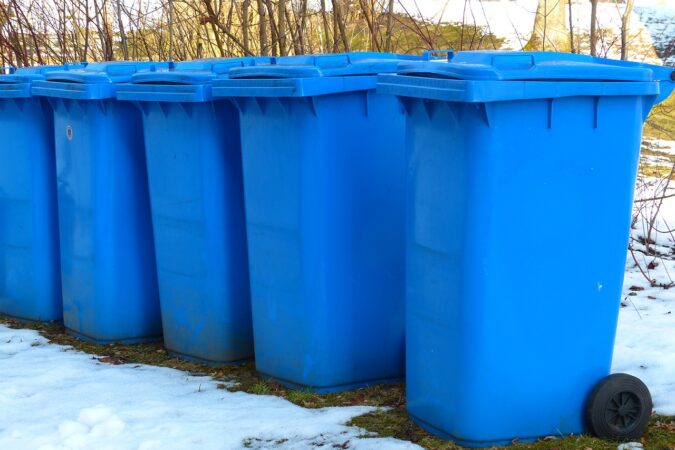
The cost of wheelie bins varies greatly. How much a wheelie bin costs mainly depends on the size, quality, seller, and number of bins you buy (as some places offer discounts for bulk buying). Generally, you can expect to pay anywhere from as little as £30 if you buy a few of the smallest bins together to upwards of £250 for a standalone four-wheel bin.
One of the main things that impact the price of wheelie bins is their size. The manufacturer, supplier, and seller may adapt the price, but the general costs of wheelie bins based on their size are:
This is just a rough pricing guide as the cost of wheelie bins can vary greatly across suppliers and depending on whether you buy in bulk or just purchase a single wheelie bin.
Some waste management companies may charge rental or hire fees to use their wheelie bins to store your commercial waste. Renting should be cheaper than buying a wheelie bin. Hire costs for wheelie bins often depend on their size, waste type, collection frequency, how long you need to use them, and where your business is based.
Rental prices for wheelie bins vary greatly from as little as £1 or £2 a day to £60 a week. The supplier and number of wheelie bins you rent at a time can all impact the price. It should still work out cheaper than renting a skip for your commercial waste.
At Business Waste we provide free wheelie bins for your company to use – you only pay for collection. There are no rental charges or costs to hire or purchase any wheelie bin, whatever the size, type, and number of wheelie bins you need and wherever your business is based in the UK.
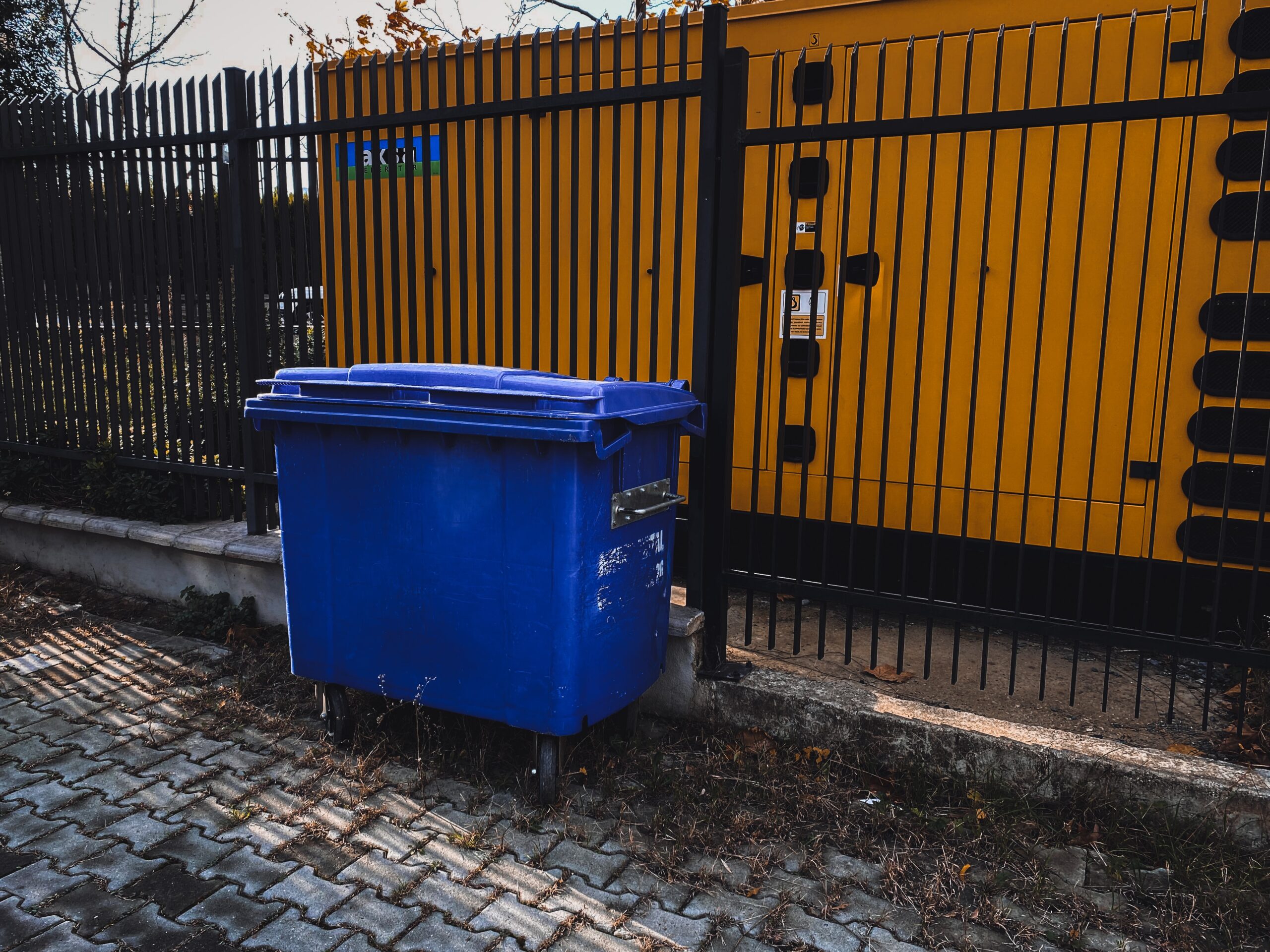
Buying a wheelie bin is unlikely to be the biggest purchase your business makes, but you still want to ensure every penny you spend returns some kind of value. It’s important to consider whether buying one or more wheelie bins is the most cost-effective way for your organisation to manage its commercial waste.
Before you start looking at buying a wheelie bin online and comparing prices from suppliers, ask yourself a few important questions:
Councils have a legal obligation to collect household waste but will only do so if it’s in an appropriate bin that they provide. This is because the bin must fit the mechanical lifting equipment of their waste trucks. If you buy your own domestic bin and it’s the wrong size or type they may not collect your waste.
In many cases, you can buy a wheelie bin from the council in your area. Often you’ll need to do this if your old bin was stolen or damaged, you move into a new home without a bin, or you want an extra bin for your home. Not all councils allow additional household bins though, so check with your local authority first.
The cost of a replacement wheelie bin from the council is normally free, but there’s often an admin and delivery fee. A wheelie bin replacement cost can vary depending on the size and type of bin and your specific local council and their fees. Generally, the cost of a replacement wheelie bin is anywhere from £40 to £50.
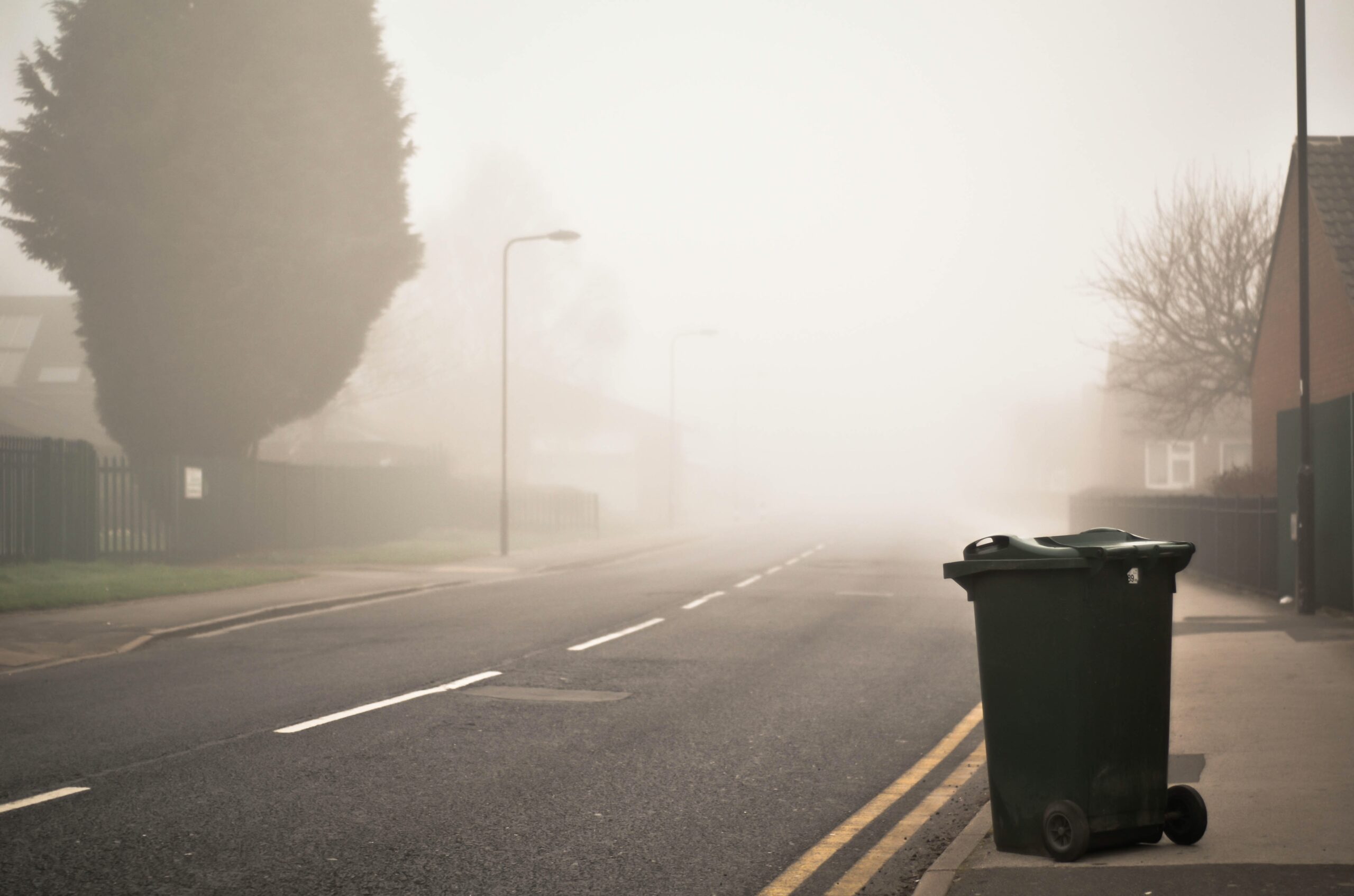
At Business Waste we’re proud to provide free wheelie bins to businesses anywhere in the UK across all sectors. There are no rental, hire, or purchase fees to help keep your waste management costs as competitive and affordable as possible. You only pay for the collection, which is the way we believe it should be.
A wide range of wheelie bins are available in various sizes to help you separate your waste types easily and increase the amount of waste you recycle. To get started we can offer a free no obligation quote tailored to your exact needs. This considers the number, sizes, and types of wheelie bins you need, how often you want them collected, and where from.
Get your free bespoke quote for wheelie bins today – call 0800 211 8390 or contact us online.
The vaping market is one of the UK’s largest growing consumer goods sectors, currently valued at around £1 billion. Vaping shops and the many varieties of e-cigarettes they sell are everywhere. However, there are still many unknowns and some growing concerns around vaping as it’s a relatively recent innovation.
These range from health effects to advertising rules and the environmental impact of old vapes. We’re not medical professionals or advertising gurus, but we are waste management experts who can advise on how to dispose of vapes. The materials they’re made from, how they’re made, and what people and businesses do with them can have a significant environmental effect.
Correct vape disposal depends on various factors, including the type, brand, and whether it’s a consumer or business getting rid of an old one. Discover how and where to dispose of vapes safely and in an eco-friendly way with this guide.

Responsible vape disposal is important to protect the environment, reduce waste going to landfill, and avoid contamination risks. Check out these vape disposal facts for an idea of how much waste old vapes create:
There were some earlier developments but the first type of e-cigarette (or vape) on the market arrived in 2004, according to the National Library of Medicine. Since then, the vaping market has boomed and there are a few different types of vapes available:
Many brands are bringing out new vapes all the time and should include proper disposal instructions with their products. Generally, the best way to dispose of a vape depends on whether it’s a reusable or disposable vape.
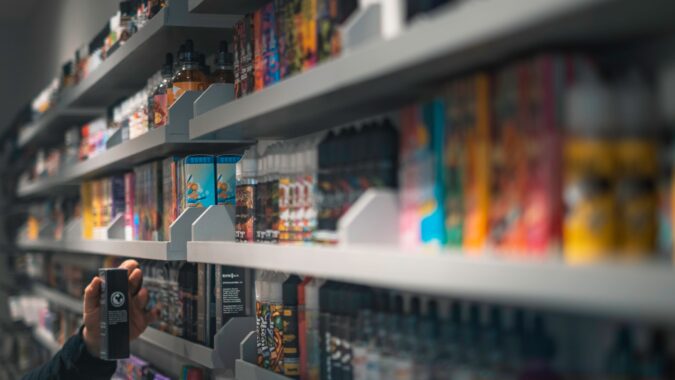
The easiest way to dispose of a single reusable vape is to return it to one of the thousands of shops that accept old electricals for recycling. Many have a legal responsibility to take back very small WEEE, which includes vapes. They’ll ensure your old vape is recycled responsibly to save you time, effort, and money.
Retailers and distributors have a responsibility to take back ‘waste electrical and electronic equipment that is less than 25cm on their longest side’ – such as vapes. This only applies to stores where the electrical and electronic equipment sales area is greater than 400 square metres (including aisle, display, and shelf space).
The likes of Totally Wicked have introduced vape disposal bins in 150 of their stores across the UK. Customers can return any brand of vape bought from any retailer in these bins for free. They’re then stored responsibly before being taken away for recycling.
Another responsible way to dispose of a reusable vape is to dismantle it and recycle its parts separately.
Vape recycling is possible for reusable and refillable devices. The most sustainable option is to keep refilling and reusing the same vape where possible. However, if the vape becomes badly damaged, the battery completely dies, or you need to upgrade then recycling the vape is your next best option.
You can recycle vapes by dismantling them and separating their parts to recycle them alongside the same materials:
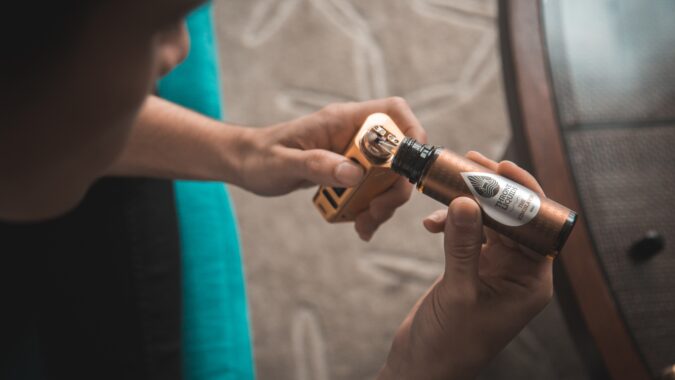
Disposable vapes are single-use, so once they’re empty they need to be disposed of responsibly. You should never throw away a disposable vape with your general waste. Any vapes in landfill can leach battery acid, nicotine, and chemicals from the plastic into the environment. Plus, the lithium-ion batteries pose a fire risk.
The safest and easiest way to dispose of a disposable vape is to put it in a vape disposal bin or return it to a retailer. Many electrical and electronic shops accept used disposable vapes and will ensure they’re recycled. You can also dispose of disposable vapes at most HWRCs with other WEEE items.
If you can easily remove the battery then you could separate it and take it to a local battery recycling point (found in many supermarkets). However, the way disposable vapes are made means it’s difficult to separate the battery and materials in many single-use vapes. Disposing of them through the proper channels is advised.
Businesses that sell vapes must legally provide an option for customers to dispose of them in line with the WEEE (Waste Electrical and Electronic Equipment) regulations. Any shop or other business that sells more than £100,000 of vapes must provide an in-store solution where vape customers can dispose of products on a one-for-one basis.
Signing up to a compliance scheme is a safe way to ensure this. Contact us at Business Waste for more information. Failure to comply could lead to a fine of up to £5,000. To ensure you’re compliant you must also:
For any shops or companies that sell less than £100,000 of vapes you should sign up to the Distributor Takeback Scheme (DTS). A charge applies for this based on your shop’s size and your sales. The DTS provides an exemption from the in store take back requirement of WEEE (including vapes) when a new equivalent EEE item (a vape) is bought.
Disposable vapes contain the same components and materials as reusable vapes. They often have a smaller tank and battery, a cheaper plastic exterior, and parts that aren’t normally removable. What’s in a disposable vape is a:
You can recycle disposable vapes. Place them in a vape disposal bin, return them to an electrical retailer, or recycle them with WEEE items at your local HWRC. They’ll be transported to a recycling facility where the vapes are dismantled and separated into their components.
These components are checked, sorted, cleaned, and recycled alongside the same materials. The only element of a vape that can’t be recycled is the cotton wick, as it will be heavily contaminated and may even be burnt. Learn more about how each part of a vape is recycled based on its material in our comprehensive guides:

There are three main places where you can dispose of disposable vapes responsibly:
Businesses must arrange commercial waste collection of any old vapes they produce. This could be through customer returns, staff getting rid of old vapes, or any other means. Removal by licensed waste carriers and recycling is vital and a legal requirement. The easiest way to do this is with WEEE bins and collections.
At Business Waste, we can provide free WEEE bins in a range of sizes to store old vapes safely on your premises. Then arrange collection on a schedule that suits you – either a one-off removal or regular collections. Licensed waste carriers remove your WEEE bins and ensure it’s recycled and disposed of responsibly.
Call 0800 211 8390 or contact us online for a free quote for WEEE collections anywhere in the UK.
Easter egg packaging recycling is essential to ensure no trace is left behind from the 80 million Easter eggs we buy in the UK every year. Most of us eat all the chocolate (often faster than we’d like to admit). But what we do with the card, plastic, and foil packaging affects the environment.
Chocolatiers and brands focus on bright and colourful Easter egg packaging to attract the attention of both young and older chocoholics. And it works. Who doesn’t associate that purple, red, and yellow splash with a Cadbury Crème Egg? But how easy is recycling Easter egg packaging once you’ve scoffed the chocolate?
Eggsplore some facts about Easter waste, ways to recycle Easter egg packaging, and how to reduce the amount of Easter packaging your household or business uses in this guide.

The good news is that today, most Easter egg packaging is recyclable. Only the plastic windows and some wrappers for sweets, chocolates, and treats that certain Easter eggs include are trickier or impossible to recycle. Most packaging can be recycled in your household or workplace recycling bins but check with your local authority or waste service first.
Separate the individual materials and follow these tips for recycling Easter egg packaging:

Most Easter egg packaging recycling happens at home. Wherever you live in the UK your local authority or council should provide at least one free recycling bin or box. You can recycle clean and dry cardboard, paper, and foil from Easter egg packaging in these mixed recycling bins.
In 99% of cases, you can also recycle clean and dry plastic Easter egg shells in your household recycling bin. However, check the plastic type first and that it’s recycled by the authority that collects your household recycling bins. If not, you can take some plastic types to supermarkets that have drop-off points for recycling – including plastic bags and wrappers.
Businesses can recycle Easter egg packaging in separate cardboard and plastic waste bins. A convenient choice for many companies is to use dry mixed recycling bins, where you can recycle a combination of materials – including cardboard, paper, plastic, and metals – which covers most Easter egg packaging.
Once you’ve separated the Easter egg packaging waste, put it in the right recycling bins, and they’ve been collected, what happens next? The recycling process is different for each type of material. Generally, Easter egg packaging is recycled in these ways:

The easiest (and tastiest) way to reduce Easter egg waste is to eat all the chocolate and recycle every bit of packaging. Alternatively, you could just avoid buying Easter eggs to prevent producing any waste. But where’s the fun in that? These are a few things you can do to reduce Easter egg waste:
Looking for more ways to have a sustainable spring celebration? Check out our detailed guide and learn how to have a low waste Easter.
Table of contents
Overview
The UK’s situation
Hazardous wastes and their regulation
Recycling and energy conversion
Landfilling
Following the waste flow
Future perspectives
References
Overview
Nowadays, our consumeristic culture has led to rates of purchasing that have not been seen before and this has led to an increased turnover of items being thrown away. Public awareness of the importance of waste management has emerged although relatively late. Thanks to the growing sensitivity to environmental and climate issues, a common thread linking these issues have become apparent.
The UK’s current waste management situation
England has made huge steps under this perspective to face a waste pile increasing year after year. The latest report from the government indeed states that this country passed from the 168 million tonnes of total waste produced in 2010 to the 187.3 million tonnes of 2018. England accounts for 84% of the UK’s yield, whose 63% is constituted by the categories ‘mineral wastes’ (e.g., stones, bricks, road surface’s components) and ‘soils’ (earthen materials). Such a high value reflects the predominant impact of demolition, construction, excavation, and other industrial activities. In the UK, waste collection is supported by an efficient (made up of mostly private companies) service system. This is evident in England at county and town levels. Local government authorities benefit from a certain degree of independence in this respect and can administer solutions to specific local needs in the form of services or new installations to aid the recycling and processing of waste. Private companies often manage these public utilities.
Hazardous wastes and their regulation
Despite representing a minimal proportion of the waste produced (between 4 to 5 million tonnes in England), hazardous wastes must be handled consciously. All have industrial origins and are subdivided into six classes: general industry, water treatments, construction and demolition, oils, and chemicals. In England, these rejects are rigidly regulated according to the Government’s Strategy for Hazardous Waste Management. At the international level, the legislation on this subject originates from the Basel Convention on the Control of Transboundary Movements of Hazardous Wastes and their disposal and an Organisation of Economic Cooperation and Development (OECD) Council Decision on the Control of Transfrontier Movements of Wastes Destined for Recovery Operations. OECD protects countries external to the European Free Trade Area from the indiscriminate transfer of wastes. Besides, this organization regulates the transport of rejects across its area following environmentally-driven principles.
Recycling and energy conversion
To cope with this surging problem, the UK is progressively replacing a linear dead-end approach with a circular strategy for waste management. As of 2018, recycling or other forms of recovery involved over 50% of the total waste production. To bring this matter closer to the general audience, it is noteworthy that one third of recycling concerns typical household materials. These have been categorized in the following classes: residual waste, 55%; dry recycling, 27%; unspecified organics, 16%; and separately collected food waste, 2%. Additionally, leftovers directed to energy-recovery treatments have surpassed incineration facilities without R1 accreditation in 2018. In this regard, domestic wastes appear to be suitable for energy conversion, constituting 80% of the total amount transiting through recovery facilities. Moreover, energy conversion commonly referred to as waste to energy ‘kills two birds with one stone’ since it offers a profitable outlet option to materials that are not available for reuse or recycling and require dismantling. In parallel, the average consumer shall be content to know that his/her household rejects represent ‘only’ 34% of what becomes incinerated. As a remarkable example of the possibility to efficiently dispose of household rejects, 44.7% of England’s domestic wastes have been reused, composted, or recycled in 2018. Overall, this corresponds to make 176 kg out of 394 kg of rejects produced per capita available again.
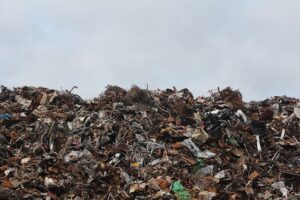
Landfill 2021
On the other hand, landfilling is placed at the second position in the list of waste processings, accounting for 23.6% of the entire waste production in 2018. ‘Soils’ and ‘mineral wastes’ play a dominant role here (58% and 6%), while household materials are present with a minor fraction (10%). Therefore, wastes other than leftovers are unfortunately subjected to this destiny. Also, ‘soils’ materials make up 90% of the backfilling materials. Regardless, newly stipulated policies are intended to decrease the relevance of landfills as waste outputs. As a result, energy recovery facilities with R1 accreditation have increased from 37 to 40 in two years (2016-2018), and the waste tonnages treated have followed a proportional positive trend.
Following and understanding the flow of waste in the UK
Understandably, not all waste types can be tracked according to the Waste from Households (WfH) protocol, which thus is considered to yield only indicative estimates. For instance, this method cannot register wastes derived from healthcare, street filth, and gully drainages. Asbestos, plasterboard, and rubble are not assessed as well. Moreover, individual UK countries can apply distinct protocols and measure different parameters. For example, certain packaging rejects may be over- or under-represented depending on the step of the manufacturing chain at which they are evaluated. Ambiguity might also exist regarding the precise definition of ‘recovery’ versus ‘recycling’, like in the case of metal wastes subjected to incineration. Shifting the focus locally, commercial companies can voluntarily register in the national electronic duty of care (EDOC) system, which enables tracking rejects along the production sequence. To date, more than 11’000 firms adhere to this system.
Future perspectives and goals
Despite the commendable efforts carried out by the UK, much remains to be done. However, at least on paper, some good news is on the horizon. The UK promulgated the 25 Year Environment Plan to preserve the natural landscape’s quality and biodiversity over an intergenerational period. This plan stands on top of the hierarchy formed by the other policies related to such issues (e.g., Resources and Waste Strategy, Waste Prevention Programme for England, Waste Management Plan for England). It has ambitious goals, such as a drastic reduction of carbon emission and international agreements. On a smaller scale, the whole policy system proposes to enhance domestic recycling in different ways. For example, it promotes the door-to-door collection of dry leftovers, the separation of garden wastes, and the weekly gathering of alimentary wastes. Ultimately, these measures are expected to substantially raise the fraction of household recycling, reaching up to 65% before 2035.
References
– HM Government (2018) A Green Future: Our 25 Year Plan to Improve the Environment. Available at: www.gov.uk/government/publications (Accessed: 27/09/2021).
– Department for Environment Food & Rural Affairs, Government Statistical Service (2021) UK Statistics on Waste. Available at: https://www.gov.uk/government/statistics/uk-waste-data (Accessed: 27/09/2021).
– Department for Environment Food & Rural Affairs (2021) Waste Management Plan for England. Available at: https://www.gov.uk/government/publications/waste-management-plan-for-england-2021 (Accessed: 27/09/2021).
If you’re an established business, start-up or otherwise new to looking after your companies waste, chances are the commercial waste industry is causing you some confusion. Not only does it go by various names (including waste management, trade waste, waste disposal and business waste), but there are different types of waste to consider, too. Paper waste, general waste, recycling, dry mixed recycling, clinical waste, plastic waste and cardboard are all processed differently. As such, there can be different disposal costs for each separate waste type, and in certain circumstances, you may need more than one commercial waste solution, depending on the type of waste your organisation generates.
This guide is here to explain everything and you can always call the business waste team for any advice.
It is estimated that businesses in the UK are responsible for the generation of 27.5 million tonnes of commercial waste and 13.6 million tonnes of “industrial” waste every year – a whopping total of 41.1 million tonnes.
Commercial organisations create almost twice as much waste as households, which means there’s much greater demand for commercial waste disposal. If you’re running a business then you will have to arrange for commercial waste collections and do some research into what this costs. The processing of waste can be a significant cost for businesses of all sizes.
Naturally, these sorts of administrative tasks can feel like a bit of a distraction, particularly when there’s a company to run and money to be made – but nevertheless, correct disposal of your commercial waste is incredibly important. Whether you’re getting rid of rubble from a construction site, food waste from a restaurant or documents from an office, it all needs to go somewhere.
Before signing a contract with a commercial waste disposal company, you and the other decision-makers in your organisation should familiarise yourselves with what you can expect your waste disposal solution to cover, what the must-haves from a disposal company are, and if there are any hidden costs you should be wary of.
A Waste Carrier Licence is a legal document, which allows a business to buy, sell, dispose and/or transport waste, or arrange for others to do so on their behalf. It essentially covers the carrying of waste in a commercial vehicle. If you legally require a WCL and do not have one, you could face a fine of up to £5,000. Business Waste LTD has a higher tier waste carriers licence.
There are two tiers of Waste Carrier Licence. The type of waste carried will determine which licence is required. Vehicles which carry construction waste (everything from rubble to empty silicone tubes) require an Upper Tier licence. Other forms of waste (such as office documentation) are covered under a Lower Tier licence.
Lower Tier waste producers can usually apply for a free licence. Upper Tier licences cost £154 in England and Wales. Costs may vary in Scotland and Northern Ireland.
The UK government is responsible for the issuing of the Waste Carrier Licence.
If your waste management solution is processing waste without the requisite documentation, and you are aware of this, your company could fall foul of the law and face a fine of up to £5,000. Before agreeing to a contract with a waste disposal company, you should always request to see their WCL.
Here is a copy of Business Waste LTD higher tier waste carriers licence registration number CBDU49243
All businesses have a duty of care to keep waste to a minimum by doing everything to prevent the creation of waste. Businesses must also make a reasonable effort to reuse, recycle and recover waste.
When searching for a waste disposal solution, chances are you will come across many lead generation websites. These websites will simply sell your data – usually to unscrupulous businesses who are unable to generate their own custom, due to poor reviews.
Lead generation sites often masquerade as genuine businesses or price comparison companies. Be wary though – these firms only want your data so they can sell it to the highest bidder with no regard to the quality of service you receive. Such companies certainly do not compare thousands of prices on your behalf. There are only a handful of local waste companies in each area and a small number of national waste disposal operators – don’t get tricked into giving your data away.
Taking the time to read online reviews of the services provided by prospective waste management companies will save you lots of future wasted time, energy, stress and money. Remember that each company will give you the “sell” and make the same promises. Search the internet for reviews on a waste company before going ahead with them and ask for references or testimonials from their existing customers if you can.
In all industries, there are those who look to exploit. The waste management trade is no exception. Here are some of the tricks you should be aware of that unscrupulous companies will try to pull. Although these practices are not strictly illegal, they are however unethical.
Bin weight limitsWeight limits are in place to encourage companies to develop more pragmatic approaches to how they deal with waste. By placing limits on the amount of waste a company can send to landfill, it encourages recycling, reusing of materials and the prevention of excess waste generation.
Waste limits are currently as follows:
You will be charged at up to 18p per additional kg over this allowance. If you are being charged more than this, you are paying too much.
Some bad companies will charge you ongoing fees for renting out wheelie bins to your company.
Note – Business waste provides customers with FREE bins so a wheelie bin should costs you £0.
Under UK law, your organisation has a legal obligation and duty of care to get and keep a waste transfer note which documents every load of waste that leaves your business premises. Your waste management company should provide you with this FREE OF CHARGE. Be very wary of any company which wants to charge you for the provision of a waste transfer note. These have to be provided by law.
Read more on waste transfer notes and see an example.
Some companies include a statutory fee for bin insurance. This is rarely an actual insurance policy and is simply a means of increasing your overall fees. If your waste management company includes bin insurance on your invoice, don’t be afraid to query them over this and ask for the actual insurance policy documents, odds are it is a completely made up and fake charge – or better still, switch to a company like BusinessWaste.co.uk who have no hidden extras.
Any reputable company will have a price guarantee in place. When searching for quotes, it’s often the case that some companies take more time than others to respond, and a situation may arise where you’ve agreed on a price with one waste management contractor, only to be offered a better deal by another a day later.
Your commercial waste disposal company should be willing to foster a good working relationship with your organisation – which means price-matching their competitors. BusinessWaste.co.uk has a 14 day written price match guarantee.
There are two common types of commercial waste collection –
One-off collections – such as the removal of waste after moving offices or renovating
Contractual ongoing collections – removal of the regular collection of commercial waste generated by your business. Collections can take place on a weekly/fortnightly/monthly basis.
There are no set-in-stone prices for waste collection as there are so many factors to consider. These include the following:
Landfill tax – to encourage recycling, the government imposes a tax on all waste disposed of at a landfill site.
Gate fees – waste processing facilities, such as recycling plants and landfill sites, charge a gate fee. The average UK gate fee weighs in at approximately £6 per tonne.
Rebates – certain types of waste like glass, cardboard, metal and alloy has scrap value and can be potentially be sold for a small profit for this you would need very large volumes measured in multiple tons in order to get a rebate.
The main waste types are;
Food waste
Pharmaceutical waste
Clinical waste management
Confidential waste disposal
Hazardous waste disposal
Paper recycling
Glass recycling
Plastic recycling
Cardboard recycling
Sanitary waste
Liquid waste
Packaging waste recycling
WEE recycling
Hospital waste management
Shredding
Waste oil collectionTOP TIP – look for a supplier who can look after all your waste, this way you don’t have endless invoices, collection schedules and contracts to deal with.
There are different types of bin sizes, and the size of the bin collected, along with the waste inside, will dictate the collection price. The most popular commercial bin sizes (in litres) are as follows:
• 1100
• 660
• 360
• 240To view, all available bins visit our bins page please note business waste provides free wheelie bins for all business customers or learn more about balers and compactors
Certain waste types have scrap and recycling value and these can sometimes generate a small profit. Glass, cardboard, metals, alloys and recyclable computer components are the most common form of rebate-generating waste, but please note your waste volumes must be significant in the multiple tons for a rebate.
Tips on saving money on your waste collections
Waste audit – by determining the amount of waste and the types of waste generated by your organisation, you may be in a position to further understand how to reduce the amount of waste you send to landfill. A waste audit is a process of figuring out ways in which you can reduce, re-use and recycle.
Recycle – as part of its commitment to the environment, the government is encouraging businesses to recycle as many materials as they can. Recycling costs less than sending waste to landfill and is not subject to the landfill tax, which could help save your business some serious money.
Improve your buying practices – get in the habit of only buying items you need, and only buying items that can be recycled.Reuse – do you need to recycle the bottled water from the staff room when you could replace it with tap water from a filtered container? Try to foster a culture of sustainability within your organisation – think no more plastic bottles, ditching disposable coffee cups and reusing items where possible.
We use plastic every day, in both our personal and professional lives. For example, a large majority of packaging is made from plastic – and it can be difficult to avoid using it altogether. However, as a Business Owner, you have a personal responsibility to ensure that you reduce the amount of plastic you use, and responsibly dispose of the materials wherever possible.
Plastic waste is a byproduct of many businesses. As a result, it is produced in many industries. This includes:
Shops
Factories
Laboratories
Schools, colleges, and educational facilities.
Takeaways
Restaurants
Garages and auto repair shops
Offices
The construction industry
There are many different types of plastic waste. They can be divided into seven categories, depending upon the type of plastic they are made from.
Polyethylene Terephthalate (PET)
Water bottles
Plastic jars
Frozen food packaging
Carpet fibre
Clothing
Rope
High-Density Polyethylene (HDPE)
Milk containers
Detergent & bleach containers
Motor oil containers
Polyvinyl Chloride (PVC)
Pipes
Tiles
Internal and external cladding
Low-Density Polyethylene(LDPE)
Shopping bags
Clingfilm
Squeezable bottles
Polypropylene (PP)
Bottle lids
Thicker plastic items
Polystyrene (P)
Polystyrene film
Polystyrene foam
Code 7
Baby’s bottles
CDs.
For a full guide on the different types of plastic click here.
Various different bins and containers are used to store plastic waste before disposal. This includes:
Wheelie Bins (240L – 1100L)
Prepaid Waste Bags
However, if you are producing large amounts of plastic waste, you could benefit from using a waste baler or compactor. Compactors work by compressing large amounts of waste into smaller cubes, which can then be recycled. You can find out more about them here.
Commercial plastic disposal refers to the safe storage and collection of any plastic waste produced in or by your business. For example, if your work with Business Waste, we will:

Plastic is one of the most widely used materials in the world – and its popularity only continues to grow. As a result of this increased demand, we produce a vast amount of plastic (and by extension, plastic waste) every year. For example, in the UK alone, we produce around 5 million tonnes of plastic waste in a single year.
391 million tonnes of plastic are produced globally each year – a statistic that is expected to double within the next decade, despite efforts from numerous environmental agencies.
There are several steps you can take to recycle your commercial plastic waste.
There are various laws and regulations placed on the disposal of plastic waste. This includes:
The Environmental Protection Act (1990)
EU Landfill directive. The Landfill directive was introduced to reduce the amount of waste that is mistakenly sent to landfills each year, which could otherwise be recycled.
Producer Responsibility Legislations. This legislation focuses on packaging waste and ensures that businesses who manufacture, import, and sell those materials are responsible for how they are disposed of.
The above list is by no means exhaustive, and you must get to grips with the various government legislation relating to business waste. Failure to comply could mean that you face a hefty fine and even a prison sentence.
There are various different methods used to dispose of plastic.
Closed-loop recycling
Closed-loop recycling
This process is sometimes referred to as mechanical recycling, or ‘chop and wash’ recycling.
Thermal Decomposition.
Certain plastics can also be recycled through a depolymerisation process, to produce oils such as petroleum. This is a form of thermal decomposition, through which heat and pressure cause hydrogen, oxygen, and carbon polymers to decompose and form petroleum. The method is similar to how fossil fuels are naturally produced over time.
Heat Compression.
The process of using heat compression to recycle plastic is continuing to grow in popularity over time. Heat compression works by mixing plastic waste in large, rotating drums and applying large amounts of heat to the waste. Heat Compression is beneficial as nearly all types of plastics can be recycled in this way.
Chemical Recycling.
Certain types of plastics, such as PET, can be disposed of through chemical recycling. This process uses a variety of chemicals to reduce a polymer to its original form. This means that it can be used again to create new plastic materials.
There are many reasons why your business needs to recycle plastic waste – and there are many benefits attached to this. For example, when you take the appropriate steps to safely and securely dispose of all waste (including plastics), you minimise the impact your business has upon the environment. This means that you are complying with all government regulations, whilst simultaneously playing an important role in securing our planet for future generations.
Furthermore, by operating with the environment in mind, you can increase your brand’s reputation – as customers tend to favour brands with strong environmental policies and practices.
Whether you have a separate waste container for your plastics or store them in dry mixed recycling bins, they will need to be sorted accordingly when they arrive at a recycling facility. In some cases, sorting is performed manually. Otherwise, the materials will be run through a machine that picks up on different polymers and can therefore separate (and sort) them much quicker.
You mustn’t underestimate the negative impact that plastic waste can have upon the environment if it is not handled correctly and recycled. This is because most plastics can take thousands of years to decompose, and can cause a great deal of harm during this time. Here are some startling facts.
Around 8 million tonnes of plastic enter the ocean each year. This causes significant damage to marine life. For example, 100% of baby sea turtles have some form of plastic in their stomachs.
In the UK alone, we throw away 15 million single-use plastic bottles a day, even though they can be easily recycled. When sent to a landfill, the average plastic bottle will take around 450 years to decompose.
Plastic production and incineration produce harmful greenhouse gasses. In 2019 alone, plastic was responsible for the emission of 850 million tonnes of CO2 (Carbon Dioxide) into the atmosphere. These figures are set to rise in coming years.
Chlorinated plastics, such as those made from PVC, can release dangerous chemicals during the decomposition process. If this soaks into the surrounding soil, it could lead to water pollution.
Most plastics can be recycled, but certain products, such as polystyrene and plastic bags, are nearly impossible to recycle. However, this does not mean that the products cannot be repurposed. For example, plastic bags can be used numerous times instead of throwing them straight in the bin. This minimises their environmental impact as they aren’t taking up space in landfills.
As mentioned previously, the most effective way of managing your plastic waste disposal and collection is by working closely with a waste management company. At Business Waste, we know that you don’t want to spend valuable time sorting through your waste, or dropping it off at different recycling facilities – and that’s where we come in. We will arrange for the safe and secure collection of your waste and take all the necessary steps to ensure that its environmental impact is kept to the minimum.
If you have any further questions or would like to arrange a site visit, please do not hesitate to get in touch. We have a team of experts on hand to answer any questions you might have, just give us a call at 0800 211 83 90
.
Stringing up Christmas lights creates a warm and festive atmosphere in any office, shop, restaurant, home, or garden. But it’s always a bit sad when the holiday season’s over and you’ve got to take them down without getting too tangled up. The best, most sustainable thing to do is keep them for next year.
Fairy and Christmas tree lights can break, stop working, or you just might not need them anymore. When this happens it’s important you don’t throw them away. Instead, there are many more eco-friendly options to recycle Christmas lights that have been in your tree, decorating the office walls or hotel lobby.
Here we run through all your options whether you’ve got old Christmas lights that don’t work, haven’t got enough storage space to keep them until next year, or simply fancy some new lights for your tree.

Old Christmas lights are a type of Waste Electrical and Electronic Equipment (WEEE waste). This means you can and should recycle Christmas lights and not throw them away with general waste that sends them to landfill. They class as small electrical items and can be recycled alongside similar waste.
You can recycle old Christmas lights in a commercial WEEE bin at your business or visit your local household waste recycling centre to recycle domestic fairy lights. The process to recycle Christmas lights is similar to other electrical items. The lights are broken down into their component parts and recycled with the relevant waste streams – such as the glass bulb, metal wiring, and plastic coating.
Recycling Christmas lights is fairly straightforward, but it depends on the type of bulbs they have. If you have old Christmas lights with incandescent bulbs, then you should remove these from the light string first and recycle the light bulbs separately. For fairy lights with LED bulbs, you can recycle the light string as one electrical item.
Arrange delivery and collection of WEEE bins to your premises with Business Waste. We can provide free bins of many sizes for you to fill with electrical waste including old Christmas lights. Our licensed waste carriers will collect and transport the bins to a nearby waste management facility, where the lights will be recycled.
To recycle Christmas lights at home the easiest way is to visit your local household waste recycling centre. There should be a section for electrical items where you can recycle them. You should not throw Christmas lights away in your general waste or household recycling bin.

If your old Christmas lights still work, then there’s no point throwing them away. Instead, extend their life by giving them to a friend or family member who can use them, or donate to a charity shop. Consider local schools, community centres, or anywhere else that could put them to good use and offer them for free.
Should you want to make a bit of money, you can always try and sell your old Christmas lights online. eBay, Gumtree, and Facebook Marketplace are common sites where you can set your own price to sell locally. This should ensure they continue to be used rather than end up in landfill.
You can recycle old Christmas lights that don’t work either by arranging delivery and collection of WEEE bins to your workplace or at a local household recycling centre. Recycling Christmas tree lights still uses energy, so there are other options to prolong the life of any old festive fairy lights, such as:

Where to recycle old Christmas lights depends on whether you’re getting rid of them from your business or home. Recycling Christmas tree lights and other illuminations from your workplace means it classes as commercial waste and must be removed by licensed waste carriers. At Business Waste we can arrange delivery of free bins to store your lights for recycling.
You just pay for collection and our licensed waste carriers will remove the bins at an agreed time and take them to a relevant facility for recycling. For homes, you can check your local council’s recycling collection services or visit your nearest household recycling centre to recycle Christmas lights.
As well as Christmas tree lights recycling, the festive season can create lots more different types of waste. We’ve got extensive guides to inform you of how best to reduce, reuse, and recycle all your Christmas waste.
The good old days of traditional card advent calendars are pretty much over. Pulling back a little paper door and seeing an image of a donkey in a stable just doesn’t cut it for kids these days. They need advent calendars packed with chocolate, sweets, and toys. The problem is the extra plastic waste modern advent calendars creates.
And in recent years there’s been a growing trend for more outlandish advent calendars aimed at big kids (adults) as well. Advent calendars for beer, gin, coffee capsules, beauty products, chili sauce, even pork scratchings, all exist. These also introduce extra packaging and materials that make recycling advent calendars tricky.
There are solutions with many sustainable and plastic free advent calendars available, as well as ways to reduce the waste leftover from any advent calendar you or your children have this year. Learn how to recycle and reuse advent calendars this festive season.

There are plenty of advent calendar facts out there about how it came to be a thing and where the biggest or smallest ever novelty advent calendar was made. But what about the waste they create? It’s not just a modern concern – during World War Two the production of advent calendars was stopped to save paper.
You might think their production should be stopped again (or at least changes made to advent calendar packaging) when you read these facts about the advent calendar and the waste it creates:
Traditional advent calendars are made from a combination of different materials. Separate the advent calendar and you can recycle the outer cardboard box in your domestic recycling bin. Check the plastic tray for a number and see if that type of plastic is accepted in your household recycling bin.
If the plastic tray is made from PET (1), HDPE (2), or PP (5) then there’s more chance of it being recyclable. This needs to be clean and dry to recycle though. Plastic trays from advent calendars made from other plastic types are less likely to be recyclable and should be disposed of with general waste.
The foil from advent calendars is also recyclable but it must be clean too. If there are bits of chocolate stuck to it this could contaminate the load. So, while you might not be able to recycle a complete advent calendar whole, breaking it down into recyclable parts offers the next best solution.
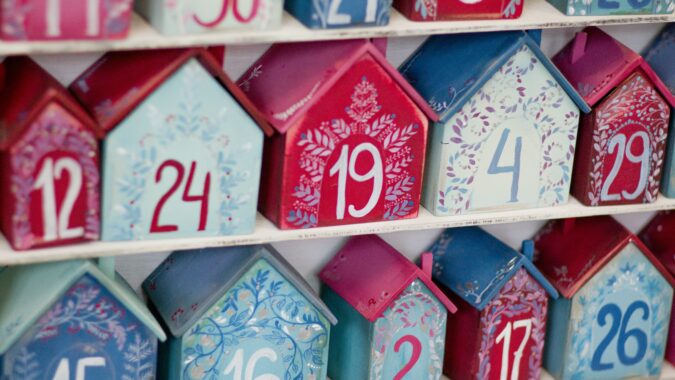
Once you’ve scoffed the last chocolate, built the last LEGO toy, or necked the final mini gin from your advent calendar (we won’t judge that it’s 9am on Christmas Day), you’ll want to throw away the box. But don’t just chuck it in with your general waste or recycling bin. There are three simple steps to recycle your advent calendar:
If you find some of the materials in your empty advent calendar aren’t recyclable, don’t despair. There are many things you can do with the materials to reuse them and ensure it ends up being a more sustainable advent calendar anyway. Try the following things to do with an empty advent calendar:

An easy way to reduce the waste you create over the holiday season is with alternative ideas for sustainable and plastic-free advent calendars, instead of the traditional varieties. This avoids ending up with plastic and other waste that can’t be recycled on Christmas Day. Consider these sustainable advent calendar ideas:
Interested in more ways to reduce your waste over the festive season? Our detailed waste guides include hints, tricks, and tips for everything from Christmas dinner to gift wrapping and Christmas trees.
Recycling Christmas cards is incredibly easy for both businesses and households. As January arrives, it’s time to take down all those cards with nativity scenes, cartoon reindeers, and dirty Santa jokes (thanks Uncle John), whether they’re from clients, friends, or family. But don’t just chuck them in your general waste bin!
Instead, recycling old Christmas cards should be your first action. The good news is that almost all Christmas cards are recyclable. When it comes to disposing of Christmas cards it’s easy to ensure your home or business is as green as the Christmas tree was when you first put it up (the less said about its browning leaves now, the better).
Discover everything you need to know about recycling Christmas cards and do your bit for the planet in this guide.
For all things relating to Christmas waste including statistics visit our Christmas waste hub.

Every year millions of Brits get sore hands from writing Christmas cards to workmates we see every day and long-lost university friends we haven’t spoken to in years. And millions of us also get annoyed receiving millions of cards containing mundane round robins and more glitter than you see on a dress from Strictly.
They do add a festive feel to any home or business, but recycling is vital once the holiday season is over. To instill the importance of Christmas card recycling, a few fascinating facts and stats about Christmas card waste are:
You can recycle paper-based Christmas and envelopes. Therefore, most traditional Christmas cards are recyclable, and you can put them in your household recycling bin or take them to local recycling points (such as a nearby household waste recycling centre or some supermarkets). However, you must remove any non-paper or card-based additions, such as glitter and foil, to recycle Christmas cards.
You cannot recycle Christmas cards that contain:

Christmas cards can be recycled in either a paper or cardboard recycling bin. As the fibres in paper and cardboard are similar (sharing similar characteristics of wood pulp when broken down), they can be recycled together. Christmas cards are paper based, so you can recycle them with paper, cardboard, or dry mixed recycling.
At home, simply put any Christmas cards in your domestic recycling bin alongside plastic bottles, metal drinks cans, cardboard boxes, and other recyclables. You can also remove and recycle many embellishments some Christmas cards contain, including:
There are a few places you can take old Christmas cards in January for recycling:
I’ve already got general waste bins, can’t I just chuck them in there? No – Christmas cards are one of the easiest types of waste to recycle, so you should always put them in your domestic recycling bin or a cardboard or dry mixed recycling bin at work.
It’s the sustainable and responsible option, as the cards can be turned into new paper and card products. This saves on the materials and energy required to create new Christmas cards for next year, reducing carbon emissions that affect global warming.
Plus, for businesses, recycling old Christmas cards saves you money on landfill tax. Throw them away with general waste and they’ll be sent to landfill or for incineration, increasing how much landfill tax you pay. Recycle them with cardboard and dry mixed recycling and you avoid these costs.
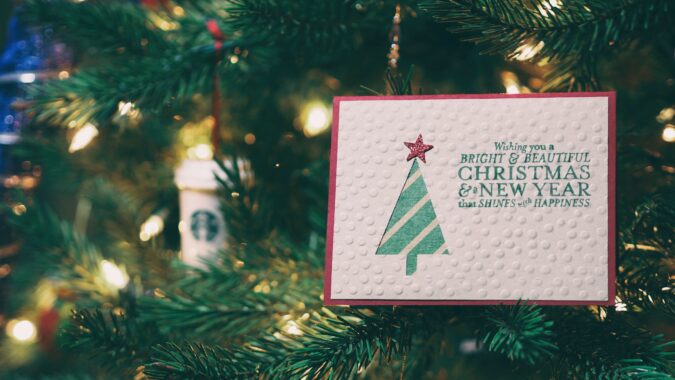
An old Christmas card still has plenty of life left in it. Aside from recycling it there are many other things you can do with any old Christmas cards you find yourself with in January. A few alternative Christmas card recycling ideas include to:
These Christmas card recycling ideas are a great way to reduce the waste you or your business makes over the holiday season. You can find out more ways to minimise the Christmas waste you create in our extensive guides to Christmas waste.
The Christmas tree’s up in the office, the party playlist’s finalised, and the winter wind down at work has well and truly begun. But what’s happening with your business waste collections in December and early January? It might not be at the forefront of your mind, but most companies produce lots more rubbish heading into the year end.
It’s easy to forget about the increases and changes to your waste production and collection needs over the festive period when you get into the seasonal spirit (quite literally at the work Christmas party). Reducing how much commercial waste you create in the run-up to the winter holidays makes managing it much easier – which you can learn about in our guides to Christmas waste.
However, we realise you’ll still produce some amount of rubbish, so it’s important you put in place a plan to deal with it effectively. Use the following tips to tackle your business waste at Christmas with ease.

Preparing for a busy period often means businesses overorder goods and end up with leftover waste in the new year. Do an audit of your orders and waste from previous years for an accurate estimate of how much food, packaging, products, or other items you should order. This can avoid overspending and creating unnecessary waste.
If you’re ordering lots of products or items from the same supplier, do it all in one go to minimise the packaging and fuel used for deliveries. It’s important you consider best before dates for food and have a back-up plan of what to do with any leftovers, so they don’t take up valuable space in your general waste bins.
For companies that don’t rely on ordering goods to operate, you can still reduce waste when it comes to the Christmas party and decorating the office. Everyone likes to overindulge when it comes to festive food and drinks but take a headcount for any event and consider donating leftovers to charity.
Will your business be closed for a few days over the Christmas holidays? Then consider moving your waste collection dates earlier to account for this. It’s especially important when you produce more rubbish during this period to avoid it all piling up and sitting there rotting away on the cold dark days and nights.
Dry waste such as cardboard, paper, and metal is fine to leave in secure bins. Other rubbish like food and general waste is best removed and disposed of before your business shuts. If left in your bins for just a few days they’ll start to smell, creating an unpleasant environment for your staff and customers.
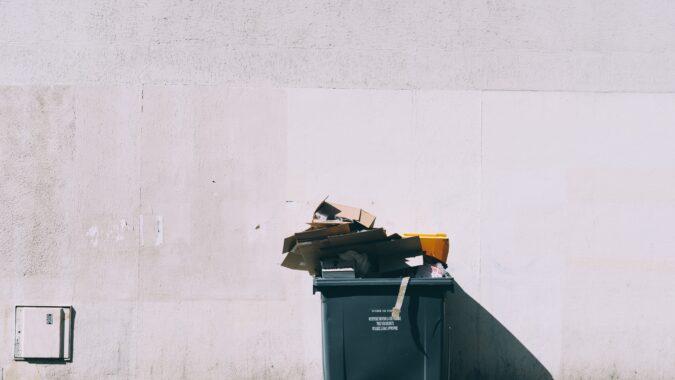
More merriment makes more waste! It might just be extra wrappers in the office bin from all the festive food being indulged or additional cardboard from Santa (well, Amazon) gift deliveries at work. The amount of waste you produce increases due to greater demand, especially for restaurants, pubs, bars, hotels, and shops.
Good planning is vital to deal with any waste increases in an efficient and cost-effective way. This avoids being hit with overweight charges for putting too much rubbish in your commercial bins or facing expensive last-minute removal costs to clear the extra waste created.
Check any data you have about your bin collections from the festive period last year for an accurate estimate of how much extra waste you’ll likely produce. Then use this and any other relevant information to order more bins, bigger bins, or increase your collection frequencies for a few weeks.
Some of the common waste types that increase for businesses around Christmas that you might need to order extra or bigger bins for include:
It may be easy to just throw any extra rubbish in your general waste bin or slip paper plates covered with Christmas cake crumbs into your paper recycling and hope they go unnoticed. However, this can cause contamination that may mean the entire load is rejected or sent to landfill instead.
Try and recycle or reuse as many seasonal items as possible that your business finds itself with in early January. Check what’s recyclable and arrange delivery of the relevant bins to separate into appropriate streams. This helps the environment and saves you money, by reducing how much landfill tax you’ll pay to get rid of your festive waste.
Many businesses go fully festive and decorate offices, restaurants, and shops with a Christmas tree or three. It creates a wonderful wintery atmosphere but come early January, what do you do with them?
The best thing to do if you’ve put up an artificial Christmas tree is keep it for next year, providing you’ve got enough storage space. Otherwise, donate it to a charity shop and they should sell it in time for next Christmas. For any broken trees, you might be able to get rid of it sustainably with your commercial plastic recycling – just check the type of plastic.
Replanting or recycling is advised when you’ve had real trees decorating your business. You can find out what to do with an old Christmas tree that’s real in our detailed guide. Just remember to remove all baubles, tinsel, and decorations before you recycle any Christmas tree!
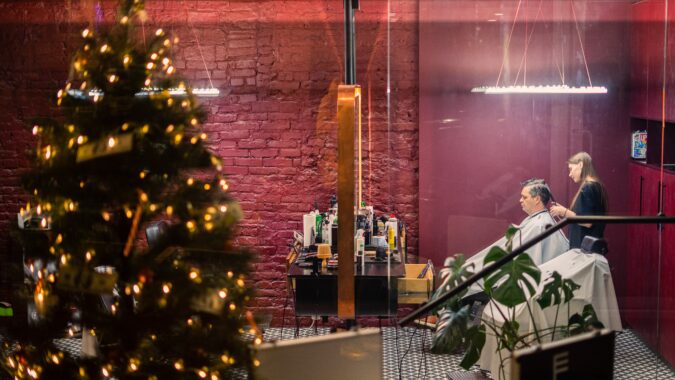
A major source of extra commercial waste at winter can be caused by the Christmas party if you host it on your own premises. However carefully you plan it’s likely there’ll be some leftover food, half-drunk bottles of beer and wine, and all the packaging that goes with it.
Prepare by increasing the number and types of bins you need and arrange collection the day after the party to get rid of all waste quickly. Glass recycling bins for all the bottles, extra food waste bins, and general waste collections for all the other rubbish created are some of the main priorities.
Santa may be generous and deliver plenty of presents over Christmas, but he won’t clear up the waste from your work party, decorations, or festive food. That’s where we come in. At Business Waste, we’re experts at arranging waste collections suited to your specific needs, whatever industry you work in and rubbish type you need disposing.
We provide free bins to businesses anywhere in the country – you just pay for collection. Plus, we work on a zero landfill policy, so aim to recycle as much waste as possible to save you money and help you operate in a way that’s as green as the holly wreath on your door.
Find out how we can help and how much you could save on your Christmas commercial waste collections with a free no obligation quote today. Call 0800 211 8390 or contact us online for a free quote tailored to your waste needs at any time of the year.
Millions of pumpkins are grown, harvested, bought, carved, and thrown away at Halloween every year in the UK. It adds to the scary amount of food waste we already create. But there are all sorts of things to do with pumpkins after Halloween to avoid creating more food waste and adding to landfill levels.
Understanding how to dispose of pumpkins after Halloween helps households and businesses use carved and old pumpkins in a more sustainable way. Simply using the innards of a pumpkin in recipes when carving a pumpkin is a good start – yet more than half of all Brits aren’t aware that pumpkins are edible!
Scooping out the insides of a pumpkin and using them to cook up a soup is one of the best things to do before you start carving your jack-o’-lantern. There are other options for making the most of pumpkins in October before they start to rot. Discover what to do with old pumpkins after Halloween with these ideas.

A few frightening facts and stats about pumpkin waste at Halloween are that:
Carved Halloween pumpkins may last for up to five days. In particularly cold areas they might last for up to two weeks before they start to wilt. If you leave an uncarved pumpkin on your porch out of the sun and avoid freezing conditions, it can last for two to three months.
You can extend the life of a pumpkin at Halloween by decorating it with a black marker pen, googly eyes, paper or cardboard – rather than carving into it. If you want to carve it, avoid cutting off the top, as removing the stem shortens the life of any fruit or vegetable. Cut into the back or bottom instead.
Yes, all varieties of pumpkins are edible. You can eat carving pumpkins in the UK, but they’re often a bit waterier and stringier than the types grown for eating. Still, you can eat them – just keep the pumpkin cool, check for any bugs, and ideally use it within 24 hours of carving it.
One of the best things to do with pumpkins after Halloween is using the innards and flesh in seasonal recipes. After carving out the insides of a pumpkin, use this bit of the fruit soon after in your baking or store in the fridge for later. A few pumpkin recipe ideas to use as much of the fruit as possible include:

Most people buy pumpkins to transform into jack-o’-lanterns by carving into its orange flesh. This creates a creepy effect but does mean it won’t last very long and you’re left with an awkward shape and amount of pumpkin. Whatever you do though, don’t throw it in your household or business’ general waste bin to prevent it going to landfill.
As mentioned, one of the best things to do with pumpkins after Halloween is to eat as much as possible. However, if you carved into it a few days ago or have already used the edible parts in a few recipes, you might wonder how to dispose of the rest of it. Here are some ideas for what you can do with old carved pumpkins:
It’s not just humans who can eat waste Halloween pumpkins, they’re also safe and healthy to eat for all sorts of animals. Before feeding one to Fido (or any other wildlife), make sure you remove any paint, ink, or other decorations that could cause illness. Otherwise, there are a few things you can do with pumpkins after Halloween for animals:

When it’s time to throw your old pumpkin away, don’t put it in the same bin as your household rubbish or general waste at work. This will likely result in it making its way to landfill and adding to increasing greenhouse gas emissions. Instead, to dispose of pumpkins after Halloween use a food waste bin.
Putting old pumpkins in a food waste bin ensures they’re disposed of properly alongside other types of food waste. Often, it’ll go for anaerobic digestion, which uses pumpkins and other food waste to generate energy – a much greener option.
Looking for more tips to reduce your waste around spooky season?
Transforming your home or office into a haunted house means putting up terrifying decorations to get into the spooky spirit. Every year in the UK we spend more than £600 million celebrating Halloween – covering the cost of costumes, décor, food, and drinks. Halloween decorations make up a significant chunk of this amount.
While figures for the UK are currently scarce, trends from the other side of the pond are slowly creeping into our culture. In the USA, 67% of people put up Halloween decorations inside their home, while 61% decorate their gardens and yards. That’s a huge amount of Halloween decorations on display, but what happens to them come November?
A scary amount are thrown away and end up in landfill, but this shouldn’t be the case. Discover what to do with your Halloween decorations to cut down on waste.

Many of the Halloween decorations sold in supermarkets are made from plastic or include a type of plastic in their materials. There’s nothing wrong with hanging up plastic lanterns in your home, blowing up an inflatable giant skeleton or putting up fake plastic gravestones in your garden. It’s what you do after taking them down that can cause problems.
Throwing away your old Halloween decorations in your household or general waste bin means it’ll end up in landfill or be sent for incineration. Any plastic waste that ends up in landfill takes tens, hundreds, or thousands of years to decompose. Halloween decorations made from metal, wood, and other materials take longer than normal to break down.
As the decorations sit in landfill the chemicals contained in the plastic can leach potentially toxic substances into the ground, water, and air. This has a negative effect on the ecosystem and adds to pollution levels – as landfills release large amounts of greenhouse gases that contribute to global warming.
Some plastic waste, including your old Halloween decorations, may be processed in incinerators to generate energy, rather than heading to landfill. While this avoids contributing to landfill levels, burning plastic releases toxic gases, heavy metals, and particles into the air – still adding to air pollution and having a negative environmental effect.
Where possible avoid throwing your old Halloween decorations away with your general waste. Rather than sending them to landfill or for incineration, there are more sustainable options once October is over. These are three main things you can do whatever materials your old Halloween decorations are made from:

If your Halloween decorations get broken or damaged beyond repair, you might have no option but to throw them out. Thankfully, many can be recycled rather than sent to landfill. Find out how to recycle different Halloween decorations based on their materials.
Any frightening fairy lights or plastic lanterns hung up in your garden or home can be recycled in two parts if they’ve stopped working. Remove the bulbs and recycle these alongside other energy-saving light bulbs – with a dedicated bin or at a recycling centre. You cannot recycle the bulbs with glass recycling as they contain wires.
The wires, casing, and other parts of your Halloween light strings and lanterns should be recycled with any WEEE waste. This ensures the electrical parts are removed and different materials separated and recycled in their individual streams.
Inflatable pumpkins, skeletons, and spiders provide an eerie effect in or outside your home or business. What’s even scarier is trying to recycle them. Most of these inflatables are made from nylon or vinyl and coated with polyvinyl chloride (PVC). These are all hard to recycle by themselves, let alone when combined.
Check the materials your inflatables are made from though, as some types of plastic are recyclable – so you might be able to recycle it in a plastic waste bin. Otherwise, donate or keep your inflatables. If it’s damaged, see if any local artists or schools can use the materials in their projects.
Check the type of plastic your Halloween decorations are made from to see if it’s recyclable. Many plastic types can now be recycled and if your decorations are made from just one type of plastic this should be possible. Ensure the decorations are clean and dry with no contaminants before you put them in a plastic recycling bin or your household recycling bin.
If your decorations light up or include other materials, then they’ll be harder to recycle. Anything with electrical parts should be recycled with WEEE waste. Otherwise, try and separate the plastic from other materials and place in the relevant bin for the likes of glass or metal recycling.
The good news is that glass is one of the easiest materials to recycle. You can normally recycle glass jars, bottles, and ornaments used to decorate your home or office for Halloween. Try and remove any paper or paint added to them if possible.
If you’ve put up wooden signs inside or outside, you might be able to recycle these with any other wood waste. However, any paint or varnish could mean they’ll be rejected, so it’s worth trying to remove this first. Unfortunately, ceramic isn’t recyclable. If you’ve got any broken ceramic Halloween figures or ornaments these need disposing of with general waste.
Rather than buying new Halloween decorations every year, why not create your own from materials around your home or workplace? A few ideas to make recycled Halloween decorations include:
The amount of extra food, plastic, and packaging waste households produce celebrating Halloween every year is well known. But businesses across the UK are just as responsible for generating lots more rubbish as spooky season starts. Having a sustainable plan in place to deal with and recycle commercial Halloween waste is vital for any organisation.
Think about how many shops, pubs, and offices are decorated in October – almost all of them. Businesses are a big contributor to the thousands of tons of excess waste Halloween generates every year in the UK. It means business owners are in a good position to help reduce and recycle Halloween waste though.
Explore ways to effectively manage and reduce the amount of waste your company produces this Halloween to save money and the environment with these tips.
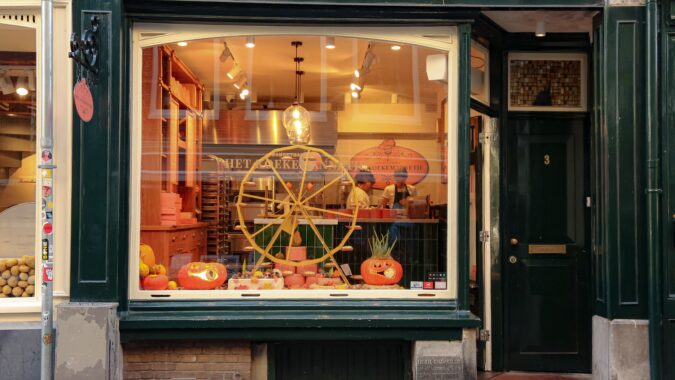
Workplace Halloween parties are a great socialising and teambuilding opportunity – at a good midpoint between summer and Christmas parties. Plenty of preparation will go into the venue, decorations, food, and entertainment. The more carefully you plan things, the easier it is to limit the waste your company’s Halloween party generates.
Order any food based on the number of attendees to minimise how much might be leftover and cut down on food waste. Use glasses for drinks and any plates and cutlery from your workplace kitchen, rather than disposable plastic cups and plates, to cut down on plastic waste.
Check if you or any employees already own Halloween decorations you can use rather than buying new ones. If not, consider making decorations from materials like paper and cardboard, which can be recycled easily afterwards. You could use such an activity as another teambuilding exercise.

Hopefully your business already uses a variety of different bins to separate its waste types and send as much as possible for recycling. If you only run a small operation though, you might just have a dry mixed recycling bin that meets your daily recycling needs.
When it’s Halloween you may produce more and a wider variety of recyclable waste. Instead of chucking this in with your mixed recycling or general waste bin, using specific recycling bins for each waste stream should ensure as much as possible is recycled. Common items for your business to recycle around Halloween include:
As your business may generate more waste celebrating Halloween, it only makes sense that you’ll need to get your bins collected more often. In preparation for producing more rubbish means you can order bigger bins to store it or arrange more frequent collections in October and early November to manage your waste effectively.
Work out what waste types and how much extra rubbish you might produce to avoid overfilling bins and being hit with overweight charges. Aside from recycling, your general waste output may increase and need managing too. Planning extra bin collections in advance avoids waste stacking up on your premises, which may cause safety, hygiene, and unsightly issues.
If you’re just having a Halloween party at work, you might only need to add an extra one-off collection to cover the excess waste created. Should you have a whole month of celebrations planned – including decorations, parties, and dress-up days – you may need to increase your bin collections for a few weeks.
Contact us to adapt your business waste collections for Halloween.
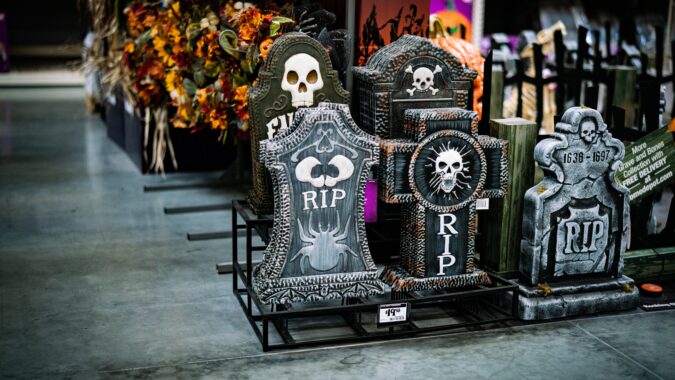
Alongside producing more general waste and recycling, your commercial Halloween celebrations can create specialist waste with which you don’t normally deal. You can use specialist bins that ensure such rubbish is disposed of safely, sustainably, and recycled where possible – rather than going to landfill.
Consider using specialist bins to store and dispose of other waste your business produces at Halloween for:
The easiest way for your business to go green this Halloween and significantly reduce how much waste you produce is to keep as much as possible. Store any Halloween decorations, costumes, tablecloths, themed plates, cutlery, and anything else for next year. This saves money as well as reducing waste.
Where cost cutting isn’t essential, consider letting your employees take home any Halloween decorations to use in their own homes. You could also donate any to local charity shops if your business doesn’t have space to store them for 12 months.
You can easily repurpose some decorations, such as using Halloween light strings to decorate your business at Christmas – as they’re essentially the same as fairy lights. Just remove any specific spooky references if there are any. Other ideas include transforming sheets, paper, and other white decorations into snowy décor. And there are ways to recycle Halloween decorations.
Halloween plastic waste could be the scariest thing about the spooky holiday. Forget the creepy costumes, darker days, and petrifying pumpkins – the increased amount of plastic thrown into landfill around Halloween and its environmental effects are truly terrifying. Decomposing for hundreds of years, leaching chemicals, and releasing greenhouse gases is like something out of a Halloween horror film.
So, what can we do? The rise of plastic use and waste hasn’t gone unnoticed, and many businesses and individual are seeking plastic-free alternatives for their Halloween costumes, decorations, treat, and parties. Find out how much plastic waste we produce at Halloween and ways to cut down this year.

Halloween produces lots of plastic waste from costumes, decorations, and sweet wrappers. Some frightening facts include:
To help bring these numbers down there are various things you can do to reduce the plastic waste Halloween produces.
Buying almost any type of Halloween costume from a supermarket or fancy dress shop will contain some level of plastic that’s tricky or hard to recycle – even when sent for textile recycling. This includes everything from accessories such as plastic Halloween masks to complete costumes. The packaging they’re sold in is also often made from plastic.
Simply avoid buying a new costume every year to cut back on your plastic use and waste.
A few alternatives include:
Wander round your neighbourhood in October and you’ll likely see gardens full of gravestones, skeletons, bats, and more. What do they all have in common (aside from transforming suburban semi-detached homes into haunted houses)? They’re mostly made from plastic, used once, then chucked in the bin.
Thankfully, there are plenty of non-plastic Halloween decorations you can put up in and outside your home instead. These materials and decorations can then be reused, recycled, or kept for next year. A few ideas for plastic free Halloween decorations include:
Throwing a Halloween party at home or work? This can create lots of plastic waste without careful planning. Choosing plastic free Halloween decorations and costumes is a good start, but you’ll also need to focus on the catering. A few considerations for a plastic free Halloween party are:
Sweet and treat wrappers are a real problem at Halloween as most of them are made from a combination of plastic and aluminium. These need separating to recycle each stream individually as plastic and metal waste. However, it’s often either impossible to separate the two or the costs and energy involved are so high that they end up in landfill.
Even Halloween sweet wrappers made from pure plastic might not be recycled if they’re too small to provide value or simply pass through the machines. Those coated in sticky substances and bits of food waste may also be diverted away from recycling to landfill.
The easiest thing to do is provide non-plastic Halloween treats to any trick-or-treaters. Buy sweets in bulk that come in cardboard boxes or glass jars with zero packaging to hand out loose sweets. Other ideas for plastic free Halloween treats include offering home baking, fruit, or paper, foil, or boxed sweets.
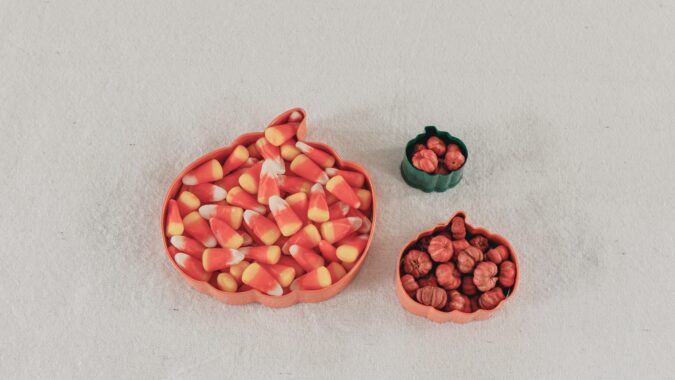
If your own kids are going trick-or-treating, don’t buy cheap plastic Halloween buckets for them to use. These often get used once then thrown away (or left in a cupboard and forgotten about until after you’ve bought another plastic Halloween bucket next year). Instead, use a bucket you already own and decorate with stickers or paint to add a creative pumpkin or skeleton design.
You could also add a Halloween theme to any plain fabric bags you own with a few black and orange pens. If your kids are more bothered about what’s in their bucket/bag than the container itself, simply send them out with a plastic carrier bag.
Going completely plastic free at Halloween can be tricky. For any plastic you use, try and make sure it’s recyclable first. Place a few plastic recycling bins around your workplace or office for easy access and encourage guests to recycle as much as possible. It might not completely eliminate plastic but at least it should divert lots from landfill.
It’s estimated that around 33 million people dress up for Halloween in the UK every year. That’s 33 million Halloween costumes worn by children and adults to get into the spooky spirit – from witches and vampires to superheroes and the latest pop culture characters. But what happens to those costumes once November 1st arrives?
Unfortunately, lots are binned and end up in landfill. Buying a brand-new Halloween costume might be quick, convenient, and ensure you get a high-quality outfit that taps into any topical trends, but it’s another type of fast fashion. Many people wear a costume once then throw it away – and its environmental impact can be scarier than the costumes itself.
Learn all about Halloween costume waste, what happens to it, and ways to reduce it with our ideas for low waste costumes and sustainable disposal.

Dressing up for Halloween is all part of the frightening fun. The costs and amount of waste it produces are truly terrifying though. To highlight the effect spooky season has on the waste industry, here are some stats, facts, and numbers about Halloween costumes:
Most Halloween costumes thrown away in the UK contain non-recyclable, oil-based plastics – meaning when they’re thrown away, they go to landfill or for incineration. In total this adds up to around 2,000 tons of plastic waste – similar to 83 million plastic bottles being dumped in a landfill site.
The plastic materials of Halloween costumes can take tens to hundreds of years to break down when they sit in landfill – often between 50 and 600 years. For example, 63% of Halloween costumes contain polyester. This is a type of plastic derived from petroleum, which takes between 20 and 200 years to decompose.
As these costumes sit in landfill for many years, the chemicals in the plastics can leach and spread into the surrounding groundwater, soil, and air – contaminating nearby water sources. While the costumes decompose, they contribute to the methane gas landfills release. This is a potent greenhouse gas that contributes massively to global warming.
Some Halloween costumes disposed of with your general waste may be incinerated. This can generate heat and energy, and avoids taking up space in landfill. However, burning plastics still releases toxic gases including dioxins, furans, mercury, and BCPs that threaten human, animal, and environmental health.
To cut down on Halloween costume waste, there are other ways to get a petrifying outfit rather than buying brand new. Consider these methods to source a low or zero waste Halloween costume:

As long as you don’t throw away anything after wearing your spooky outfit, you’ve got a zero waste Halloween costume. The easiest way to create one is using items you already own that you can clean down after making your costume and reuse. Find inspiration for zero waste Halloween costumes with these ideas:
Eventually the life of your Halloween costume may come to an end if it gets damaged, worn out, or you simply have no space for it. The best thing to do is give it to a friend or family member. Or you could donate to a charity shop or sell/give it away for free online through eBay or Facebook Marketplace.
Whatever you do, don’t throw away a Halloween costume with general waste, as it’ll end up in landfill or incineration. Another more environmentally friendly option is to send your old costume for textile recycling. Here the fabrics can be stripped down and reused, while any other materials will be sent for recycling and proper disposal.
Contact us if you have old Halloween costumes you want to recycle or have any questions about the process.
As Halloween creeps closer once again, the excess waste we create celebrating spooky season starts to increase. Every year in the UK we spend a scary £300 million on Halloween – for costumes, decorations, food and drink. A terrifying amount of these items are thrown away and end up in landfill.
Cutting down on waste by recycling and making small changes means you can still have a fun and frightful Halloween while protecting the environment. There are all sorts of low and zero waste Halloween ideas available whether you’re decorating your home, throwing a party, or just taking the kids trick-or-treating.
Use these tips and tricks for a waste free Halloween this year.

According to The Fairyland Trust, 79% of kids dress up for Halloween every year in the UK (as do plenty of adults). Frighteningly though, about seven million Halloween costumes are binned each year and four in ten costumes are only worn once. Sadly, most of these creepy costumes end up in landfill.
Rather than joining in with the fast fashion trend and buying a brand-new costume, consider these zero waste Halloween ideas for you or your children’s costumes:
Just over 2,000 tonnes of extra plastic waste are created every Halloween in the UK. While costumes are the main cause, the other main culprit is Halloween decorations – from lights to plastic and inflatable characters around your garden and home. Most of these are put up once, then binned when November rolls around.
Zero waste Halloween décor helps cut the amount of rubbish produced. Reusing any plastic Halloween decorations you already have and keeping them for future years is ideal. Most of them last for ages, which means you don’t need to buy any more, reducing the demand and avoiding creating extra plastic waste.
Other ideas for zero waste Halloween décor include:
Sweets and treats are Halloween staples, whether you’re handing them out to trick-or-treaters or have them in a bowl at your party. However, most Halloween sweet wrappers are made from types of plastic that aren’t recyclable. These include metallised plastic film (that looks like foil), combinations of plastic and foil (that can’t be separated) or plastics that are too low quality to recycle.
Choose sweets that come in recyclable packaging when preparing for trick-or-treaters. Waste free Halloween treats can include chocolate and sweets wrapped in paper or cardboard, as these are more likely to be recyclable. Most will say on the side whether the packaging can be recycled or not.
Other ideas for waste free Halloween treats include:
Every Halloween party needs some ghoulish games, whether it’s for kids or adults. Most traditional Halloween tricks and games are low or zero waste anyway, such as apple bobbing and scary scavenger hunts. There are plenty more waste-free Halloween tricks you can add to spice up any party, such as:
A petrifying 14.5 million pumpkins are thrown away in the UK around Halloween every year. They’re often carved up and discarded in a few days, leaving waste companies to deal with a big influx at once. But there are various ways you can cook and eat them to avoid adding to food waste.
Roast pumpkin seeds as a healthy snack, make pumpkin soup, or bake a sweet pumpkin cake (a terrifying take on traditional carrot cake). These all make great options when preparing party food for Halloween or Bonfire night just a few days later.
Try and buy sweet and savoury food in recyclable packaging when planning your Halloween party. Cooking yourself or asking friends to bring a dish or two also reduces packaging. Avoid using plastic disposable cups, cutlery, and plates too – as these can be tricky to recycle – even if the spooky designs fit the theme.

Waste is unavoidable in some cases at Halloween but recycling as much as possible can minimise the environmental impact of your frightening fun. Having recycling bins for paper, cardboard, and dry mixed recycling in high traffic areas that are easily accessible should encourage staff and guests to recycle as much rubbish as possible.
Whether you’re having a Halloween party at work, home, or just decorating the office for spooky season, we can sort you out with the right recycling bins. Contact us today for a free quote for your waste collections.
We all love Xmas day, everyone but the environment. Below we have probably the world’s largest collection of shocking and disgusting Xmas waste facts and figures, how many of them do you contribute to them?
For all things relating to Christmas waste including statistics, visit our Christmas waste hub.
Learn about commercial waste collection and waste disposal.

Visit our Christmas waste hub to find out more about all the waste we create around Christmas and how we can reduce it as households and businesses. Explore some further information and facts about Christmas waste on the following pages:
To help the environment:
Composting your organic waste at home is a great way to help reduce the amount we are throwing in landfill sites every year.
Using homemade compost will help to protect natural rare peat bogs that are being destroyed, by reducing the need for natural peat based compost products.
To Improve Your Garden:
By digging compost into the soil it improves soil texture and nutritional quality.
Through using compost as mulch around plants to help retain moisture.
The organic matter in garden compost helps to break up heavy clay soils, making them lighter and much easier to work.
To Save Money:
Buying less peat and fertilisers.
By helping the County Councils cut disposal costs for household waste.
Compost bins are also available from outlets such as garden centres, DIY stores and online. They can be made of various materials and come in all sorts of shapes and sizes so you are sure to find one that suits your garden.
COMPOSTING QUESTIONS AND ANSWERS
A: Firstly ensure your composter, whether it is homemade or bought, is in a good spot in the garden. The best place for a composter is on soil or grass, to allow drainage and to let the worms get in. Also you should put the composter in a nice warm place in the garden to maintain the best temperature for the process.
A: To make good compost add a variety of compostable materials and create loose layers. Avoid heavy layers of grass cuttings or leaves.
A: Keep your materials damp but not wet. Add small quantities of water, or moist grass clippings or leafy materials if the compost is drying out. Or add drier material such as shredded newspaper if the mixture is too wet.
A: This is because your compost is too wet and is breaking down anaerobically, meaning without air. To help reduce the wetness try leaving the lid off in dry weather, removing some grass clippings or adding some shredded paper. Turn regularly with a garden fork to mix dry and wet materials together to improve air circulation.
A: Composting can take weeks or months, depending on how much air and moisture the material receives. By turning the compost regularly to help add air you should make compost in 3-6 months. In winter it will take longer because cold weather slows the process down.
A: Compost can take a while to make. A slow turn over may be because the material is not reaching high enough temperatures. Try moving the composter into sunlight and keep the lid on. It could also be that its too dry so try to keep the pile moist. Try adding an activator; ready made activators can be bought from most Gardening Centres. Young nettles help to speed the process up too.
A: Usually because you have put in too much soft material, grass clippings and vegetable peelings etc. Make sure you get a good mixture of materials, try adding chopped up dry twigs and wood chips and some shredded newspaper you will give the compost a better texture. Try turning the mixture with a garden fork more often.
A: You can compost green garden waste. This includes fallen leaves and prunings from hedges. Try to ensure that you get a good mixture of materials in your compost pile as well as the hedge clippings. Any woody stems and branches will take longer to decompose and you may want to take those to your local Community Recycling Centre and add them to the green garden waste collections for larger scale composting.
A: Compost heaps may highlight the fact that vermin are in your local area. You need to remove any unsuitable material and remember what can and can’t be composted. Try placing chicken wire round the base of the compost heap.
WORMERIES
Not got the space for a compost bin? Then try a Wormery!!
Having a wormery is an easy & efficient way of converting ordinary organic kitchen waste into top quality compost and concentrated liquid feed therefore reducing the need for chemical fertilisers. Naturally worms ‘recycle’ the organic material, therefore reducing the waste dumped in landfill sites.
GETTING A WORMERY
Contact your Local Council to find out if they sell wormeries at a discounted price. Alternatively try your local garden centres or please click here to go to our links page.
Wormeries are easy to maintain and don’t cause nasty smells if used properly. Have a look at our top tips:
TOP TIPS:
When you put new worms in a wormery, they like to explore their new home. If you don’t ensure the lid is firmly closed, they might escape! We suggest you keep the wormery outside in a sheltered shady place.
Add a touch of water now and then if your worm bin is getting too dry.
After about six months you’ll probably have too many worms for your bin. Empty half of the mix onto the garden, or split it into two and make a second worm bin.
YES! What to feed your worms
Fruit and vegetable peelings
Tea bags
Small amounts of newspaper and cardboard
Leaves from houseplants
NO! Don’t feed these to your worms
Garden waste such as cuttings, grass etc these materials are better on a compost heap
Too much strong food such as onion, chilli, garlic and citrus peel
Dairy products
Meat
Fish
Fat / oil
Animal droppings
How to save money on the most expensive outfit you’ll only wear once
Your big day can be one of the most expensive events you’ll ever throw in your life, especially with the UK couples spending on average an eye-watering £27,000 on their nuptials.

This has prompted a new wave of savvy brides on a budget to turn to renting their wedding dresses instead of forking out on a frock they will wear only once.
In fact, UK waste prevention company BusinessWaste.co.uk found that after speaking to 2100 brides to be, 4 out of 10 brides would be willing to hire a dress for the day, with many saying that they would rather put the money towards their future as a married couple.
“It’s crazy how much the cost of weddings has sky-rocketed in the last decade, but there are plenty of ways you can save some money and keep within a smaller budget,” says BusinessWaste.co.uk spokesman Mark Hall.
“Renting a wedding dress is a great way to still look the part but save some precious pennies that could be put to much better use in future married life!”
Bargain bridal ballgowns
Currently, the average UK bride will spend around £1,300 on her wedding dress, which is likely to be the most expensive piece of clothing most brides will ever purchase in their lives.
Hall: “The expectations for couples to throw a lavish event for their friends and family has really put the pressure on them to spend more to thrill and excite guests.
“Years ago it used to be a cheap shindig down the local social club, but now couples are spending a small fortune on venues and dresses to rival what they see on social media and in magazines.”
However, nearly half of brides surveyed by BusinessWaste.co.uk said they would be open to the idea of renting a dress instead of buying it outright, giving reasons such as not wanting to overspend on an outfit they would only wear once, and preferring to save the money for more long-term goals such as travelling or a house deposit.
There’s also the factor that wedding dresses take up a lot of valuable wardrobe space!
Sarah from Doncaster is getting married next year, and says she is happy to rent her dress so she and her partner can spend more on their honeymoon – “I’d rather we made some memories just for the two of us rather than being selfish with the cash and spending it on my dress for the day.”
“Plus we’re trying to save for a mortgage, so financially it really doesn’t make sense to me.”
Myriam is currently looking for her dream dress to rent, “I just think you get more choice, rather than what’s in ‘fashion’ at the moment, so I can get something really unique that will suit my personality.”
“Plus I don’t have to worry about getting it professionally cleaned afterwards or figure out where to store it – I can just hand it back!”
Saving the planet – one dress at a time
Renting clothes is not a new concept, with many online platforms being created so you can hire an outfit for any occasion with ease. Most grooms and best men routinely rent their morning suits, after all.
As well as being easy on the bank balance, renting clothes also has the added benefit of being much more sustainable and ensures fewer garments end up in landfill.
Instead of buying a new item that has used new, raw materials and consumed energy to produce and ship to you, eco-conscious shoppers and brides-to-be are keen to make the most of existing garments in a fight against fast fashion.
With 2 million tonnes of textiles being thrown away each year in Europe, it’s no wonder that there has been a huge rise in people looking to reuse as much clothing as possible to stop perfectly good items from being needlessly thrown away.
But can renting a wedding dress really have a big impact on reducing waste and be better for the environment?
Second-hand wedding dress website Still White believes it can, especially since they have resold over 20,000 dresses – saving over 200,000 kg of carbon emissions and 180 million litres of water being used in producing new garments.
And even the PM’s new wife Carrie Symonds is getting in on the act, with reports that she recently hired her frock for their low-key wedding this year.
Hall: “Hiring your wedding dress can not only save you money, but it can also free up more of your time to enjoy your wedding planning and enjoy your big day, whilst being sustainable and helping to reduce waste at the same time.
“It’s a win-win really, so why not hire your dress and do your bit of the planet – one giant white frock at a time?”
The greenest cities in the world (and the least) – which international cities top the list for recycling and which don’t make the grade
The need for recycling has, by now, been fairly well cemented into the minds of the general public. Citizens the world over are aware of what can and cannot be given a new lease of life through the recycling process, and – in countries where there are recycling schemes available – generally act accordingly.
But alongside individual action is what happens at a bigger scale – in neighbourhoods, cities or countries. The decisions made by policymakers, city planners and governments also affects the recycling rates of our towns and cities; and some cities worldwide are topping the list for recycling with interesting or innovative ways to ensure they waste as little as possible.
Waste collection experts BusinessWaste.co.uk have compiled a list of the fifteen best cities across the world for recycling – including some hidden gems which you may not have heard of – and five which still have some way to go…
The top 15 greenest cities in the world
1. Vancouver – Canada’s shining jewel when it comes to recycling, the city of Vancouver has increased its rate from 40% to over 60% in just over a decade, with a goal of 80%. The city does this by making recycling part of the circular economy and innovative schemes that reward businesses who upcycle or reuse materials.
2. Singapore City – Singapore generates an impressively small amount of landfill waste per person each year – just 307kg, compared with the average of 380kg across the rest of Asia, according to the Siemens Green City Index. It has a goal to recycle 70% of its waste by 2030, and has increased business participation by introducing laws which make companies responsible for the waste they use.
3. Copenhagen – Aiming for an impressive 70% recycling rate, Copenhagen benefits from the Danes’ enthusiastic support for waste reduction (Circular Copenhagen). Door-to-door collections make it as easy as possible for citizens, and Copenhagen is working towards becoming a zero waste municipality by 2050.
4. Helsinki – Despite struggling with waste collections during the frozen winter months, Helsinki recycles a respectable 58% of its waste. The city has been improving its eco credentials – including green taxis – in recent years, introducing schemes to recycle construction waste and adding a much-needed plastics recycling scheme.
5. Curitiba – Awarded the title of Sustainable City in 2010, Brazil’s Curitiba is environmentally focused by design. A piece in Smart Cities Connect has explored how it prioritises pedestrians over cars, has interconnected green spaces, and – most impressively – has a ‘green exchange’ which allows the city’s poor to exchange collected rubbish (two thirds of which are recycled) for fresh food.
6. Delhi – Despite limited resources, the city of Delhi has achieved an enormous amount when it comes to reducing waste. It has created ‘eco-clubs’ in over a thousand schools, impressing the importance of protecting the environment on young citizens and bolstering the city’s existing culture of ‘careful consumption’ and waste reduction policies (delhi.gov).
7. Los Angeles – Famous the world over, this West Coast city is more than just film stars. Los Angeles recycles almost 80% of its waste according to Columbia Climate School – more than most cities in Europe. Led by a city-wide education drive and company tax concessions for recycling, LA remains fully committed to a zero waste initiative.
8. Leeds – the UK’s own Leeds is impressive when it comes to recycling – around 40% of its waste is diverted from landfill. Its impressive approach to recycling includes the ‘Leeds by Example’ scheme which has placed over 180 on-street recycling points across the city, which have almost tripled recycling rates in the city centre to 49%. The scheme represents the UK’s biggest effort to improve the level of food and drink packaging recycling rates and sets an example which other UK cities hope to emulate.
9. Vienna – Innovative Vienna is unusual for keeping its waste management entirely within city bounds rather than shipping it elsewhere (Bloomberg) – and since the introduction of recycling plants in the 1980s, recycling containers for metals, plastics and glass are found all over the city. While Austria has some way to go when it comes to recycling on the whole, Vienna is improving each year.
10. Stockholm – Still in the Scandiavian region, Stockholm is an exceptional example of recycling in Europe, having undergone something of a revolution. According to Sweden.se, 50% of its waste was turned into energy in 2019 and 84% of cans and bottles were recycled. Clothing recycling is also a huge part of Stockholm’s economy, with homegrown fashion giant H&M offering garment recycling in the city’s stores.
11. Seattle – One city using tech to tackle waste problems is Seattle, in Washington State. The city’s use of an app called Recycle-It allows citizens to check waste removal dates and set handy reminders, and has helped increase Seattle’s engagement with its compulsory recycling scheme.
12. Songdo – You may not have heard of this South Korean “smart city”, but it’s doing something truly revolutionary with its waste disposal system. As reported in Bloomberg City Labs, a series of underground pipes automatically collect waste and take them to a processing facility nearby, meaning its citizens can have no excuse not to help Songdo meet its recycling goals.
13. Kamikatsu – Okay – so this one isn’t a city, but Japan’s Kamikatsu, a village isolated on the side of a mountain, is widely known as the ‘waste free town’ Due to its remote location, locals separate their waste into a staggering 34 categories to ensure its waste reduction can be optimised without the need for costly (and environmentally-unfriendly) transportation of waste.
14. Ekilstuna – Another little-heard name, but Sweden’s Ekilstuna is one of the most environmentally friendly cities in the world overall. Biofuel public transport and low-carbon power plants earn it this title – but the city’s 100% recycled shopping mall, Retuna, where all goods are donated by citizens and resold on, creating a truly circular economy.
15. San Francisco – Of course, the crown of the most recycling-friendly city must go to one which makes mass recycling work on a huge scale. Landfill disposal in the USA’s San Francisco is at its lowest rate ever, reporting that over 80% of its waste is diverted via reduction, reuse, and recycling schemes every year. This makes it one of the most successful cities in the world for reducing waste sent to landfill, using a mix of incentives for citizens and businesses, educational programmes and cleverly-designed recycling systems to top our list.
But what of the cities where recycling is low on the priority list? Despite global efforts to reduce, reuse and recycling, there remain many cities where recycling is yet to become truly embedded in the culture.
The top 5 least green cities in the world
1. Mexico City – While recycling initiatives have been launched in Mexico City, it has yet to run a smooth system and relies on private waste management. The city closed its largest landfill site, where over 70 million tonnes of waste are already buried and causing environmental problems, almost a decade ago, leading to illegal dumping grounds forming and streets piled high with waste. Just 15% of the city’s waste was recycling, leaving much room for improvement.
2. Beijing – In 2017, Beijing, with a population of 21 million, incinerated or sent to landfill almost all (95%) of its waste according to China’s National Bureau of Statistics – a shocking number for a city which has so many citizens. Despite historically poor recycling rates, China’s ban on importing landfill waste from other countries in 2017 has led to improved efforts to responsibly process its own waste, and the only way is up for Beijing’s figures.
3. Kolkata – India’s Kolkata has recycling rates well below the international average. While India recycles approximately 60% of its plastic waste, the city of Kolkata is growing so quickly that it struggles to implement effective recycling collection and processing, leading to a growing problem with landfill in the area. It’s a problem which faces many fast-developing cities, who are under both ethical and legal pressure to meet increasingly important global targets.
4. New York – It isn’t only developing cities which are wasteful, however. The Big Apple, despite aggressive recycling drives across the city, fail at the most important hurdle – producing less waste in the first place. According to Grow NYC, in 2019 the city’s residents produced 12,000 tonnes of waste per day, which it farms out largely to nearby landfills.
5. Kuwait – Indeed, being an incredibly wealthy city doesn’t mean having a robust recycling programme – despite being in one of the richest countries in the world in terms of GDP, Kuwait City’s citizens generate twice the global average of waste per day and less than 10% of it is recycled. Grassroots movements to improve recycling in the city have been introduced, but it has a long way to go.
Mark Hall, spokesperson for BusinessWaste.co.uk, said:
“Countries the world over are tackling waste in innovative and interesting ways, but many lag behind. The challenge over the next decade will be bringing all cities to a standard where waste reduction is made part of policy, not merely a target to let slide by – and in the meantime technology and science continue to innovate to make our collective impact on the planet less harmful.
“Some of the best approaches covered in this list are ones which take local requirements and considerations into account – cities and towns working with their specific geography or economic status to improve their approach to recycling. This is something that is key for cities, towns or regions to incorporate into their own waste disposal policies in future, to ensure the best possible uptake and to minimise impact on the local environment.”
The one that was only worn once…
Pampering your pet rotten? That’s great, but those oh-so-funny novelty dog outfits are a huge waste of money and resources.
While most dog owners treat their pets with snacks and toys, many owners will follow the trend of buying their dogs clothing, as experts predict that the UK pet industry could be worth £2billion by 2023.
Waste Management Company BusinessWaste.co.uk is concerned about how many of these canine costumes are being thrown away, as pet owners splash the cash treating their pups and dressing them up.
“Many of these outfits are one-hit wonders, whether it’s just for a quick snap on Instagram or a family photo,” says BusinessWaste.co.uk spokesperson Mark Hall, “odds are the dog hates wearing it, and you’ll never bother with the struggle of getting that pirate outfit back on them again.”

A glimpse inside the ‘paw-drobe’
With hundreds of dog outfits available on the market, BusinessWaste.co.uk asked pet owners about their most memorable pet dressing up experience.
Sarah, Poole: “I’ve spent £100s on clothes for my westie Harry, he looks cute and he loves it. Once the outfit is on, he’s such a diva, especially in his cowboy booties. And he can’t go for a walk without his coat on, he’ll catch a chill.”
Holly, London: “My partner and I have four pugs, and we love dressing them up as the superheroes we named them after. We might have taken it a bit too far when we tried to put a mask on Spider-man and he tried to bite us.”
Nick, Luton: “I buy my dog Wesley a new reindeer costume every Christmas for the family photo. I’d reuse the one from the year before, but he always manages to poo in them. We even put him in a nappy one year to try and stop him ruining another outfit, but history found a way to repeat itself.”
Andrew, Blackpool: “My five stone rottweiler Rover ran away once, and it took us two hours to get him back. One look at the cat costume my wife had bought him, and he bolted. If she really wants a cat she should just go and get one.”
Tracey, Wolverhampton: “By dressing up our staffy Buzz, our family isn’t limited to just enjoying a regular dog. The kids get to play with a spaceman, a dinosaur or even Pikachu. It’s so hard keeping them interested in things, but they’re never bored when they get to dress up the dog!”
It’s not just dressing up dogs in fancy dress that owners enjoy says spokesman Mark Hall, there’s a growing trend in people buying outfits to match with their dog.
In 2019, clothing company Missguided launched a ‘twinning’ pet clothing collection to match outfits to owners, which saw 20,000 visitors visit the range online in the first 48 hours.
“People buy these outfits for the perfect Instagram moment, but it’s not something that the dog wants to be plausibly running around in for much more than a photo,” Says Hall, “with such a focus on sustainable fashion, we need to make sure this extends to four-legged fashion too.”
A new lease of life
While many pet owners think dressing their dogs up is cute, BusinessWaste.co.uk are concerned by the many canine clothes that are being thrown in the bin after just a single wear.
“Seeing as most owners admit to only putting their pup into the outfit once, I’m surprised that a dog outfit rental business hasn’t taken off,” Says Mark Hall, “There would be no waste as clothes can be washed and reused.”
There are plenty of ways dog clothes can be repurposed, as unwanted outfits can be donated to charity shops or to a local dog shelter as long as they are clean and in good repair.
“We use the warmer clothes such as jumpers for pups who need them, but we also have a lot of fun using the fancy dress outfits for online campaigns and adoption adverts,” says Jo, a volunteer at a dog rescue centre.
“We recently had a family come in to adopt a terrier we put up a picture of dressed up as Elvis. They found the photo hilarious and wanted to take him home.”
Hall says BusinessWaste.co.uk encourages swapping outfits with other pet owners, to reduce the amount of clothing is being needlessly bought, therefore you can get more use out of the outfits with the added bonus of keeping your dog’s Instagram content fresh.
“And if your dog runs out of outfits for Instagram, why not consider dressing yourself up as your dog? You could start a new trend.”
Anything to stop the outfits taking a ‘walkies’ to landfill, we say.
We crumple them, shove them in coat pockets and find them forgotten in shopping bags every day – the humble receipt may not seem like a big problem, but waste collection company BusineseWaste.co.uk says paper receipts should be banned to stop them heading to landfill.
Over 11.2 billion paper till receipts are printed each year by retailers in the UK – a staggering number that generates enough paper to reach to the moon and back. Shoppers are increasingly conscientious about their recycling habits, meaning that a large number of these pieces of paper are thoughtfully discarded into paper recycling. But BusinessWaste.co.uk say this is not quite as helpful as it seems – concerningly, till receipts are not only non-recyclable in most cases, they’re also potentially harmful.
Despite this, UK shoppers are overwhelmingly unaware, with 95% saying they believed receipts were recyclable in a study undertaken by BusinessWaste.co.uk. Just 1% of the 2000 people surveyed knew they were non-recyclable, with 4% unsure either way.
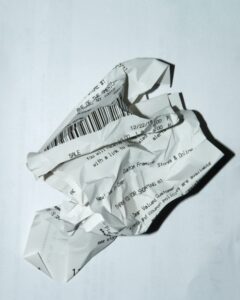
Common responses from survey takers included:
“Yes – it’s paper!”
“If I remember to take them out of my wallet, they go straight in the recycling.”
“I usually chuck them in the on-street recycling bins as soon as I leave the shop.”
Although well-meaning, these shoppers could be adding to a bigger problem – and one which BusinessWaste.co.uk says requires a receipt ban altogether.
About half of receipts are printed of a special type of paper which reacts to heat. The till ‘printer’ contains no ink, but rather heats the paper in the pattern needed to make the text appear: a clever trick, but one which hides a more worrying fact.
This thermal paper contains two chemicals, known as BPA and BPS, which are classed as toxic to people and the environment – so much so, that plastic water bottles are no longer allowed to contain these harmful chemicals, which can cause hormonal changes and have been linked with a risk of cancer. Yet millions of pieces of paper containing both BPA and BPS find their way to both landfill and recycling centres each year – contaminating the other waste or releasing the dangerous chemicals into the air.
Mark Hall, spokesperson for BusinessWaste.co.uk, said the solution is simple.
“We simply need to ban receipts altogether. Most people find them annoying as it is – how often do we throw them in the nearest bin as soon as we exit a shop or, equally wastefully, decline them after they’ve been printed, leaving till staff to throw them away?
“Some retailers have introduced electronic receipts, sent by email, and we think this is a great alternative, particularly as it makes it easier for consumers to find if they did need to return or check the warranty on a product. It could also be done by text or QR code, giving consumers the option to decline the receipt altogether or enter their details to get it sent to their phone or emails.
“For those who need to collect receipts for expense or tax purposes, having digital receipts would save bulging files with scraps of paper for long-suffering accountants to sift through at the end of the year – it’s a win-win. For those who don’t need to save each one, more retailers need to give customers the option to say no to pointless pieces of paper – or offer environmentally friendly alternatives.
“We’re aware that some retailers have shifted towards using a different type of paper in their receipts which is recyclable, but we think this is just creating another form of waste that enters the recycling process: it’s usually entirely unnecessary.”
For when you want to sesh with the squad but still respect the environment
Want to have a drink AND do something good for the environment? While celebrating the hideous goo you find at the bottom of bins?
Boy, have you come to the right place, because two of the UK’s leading waste collection experts have gone into the brewery business together to raise awareness of the impact rubbish has on the planet while delivering tasty, tasty beer.
BusinessWaste.co.uk and Divert.co.uk’s new joint venture, ‘Bin Juice’, contains a range of flavours that aims to get people talking about Mother Nature and being an ethical choice for conscientious consumers by using recycled cans.
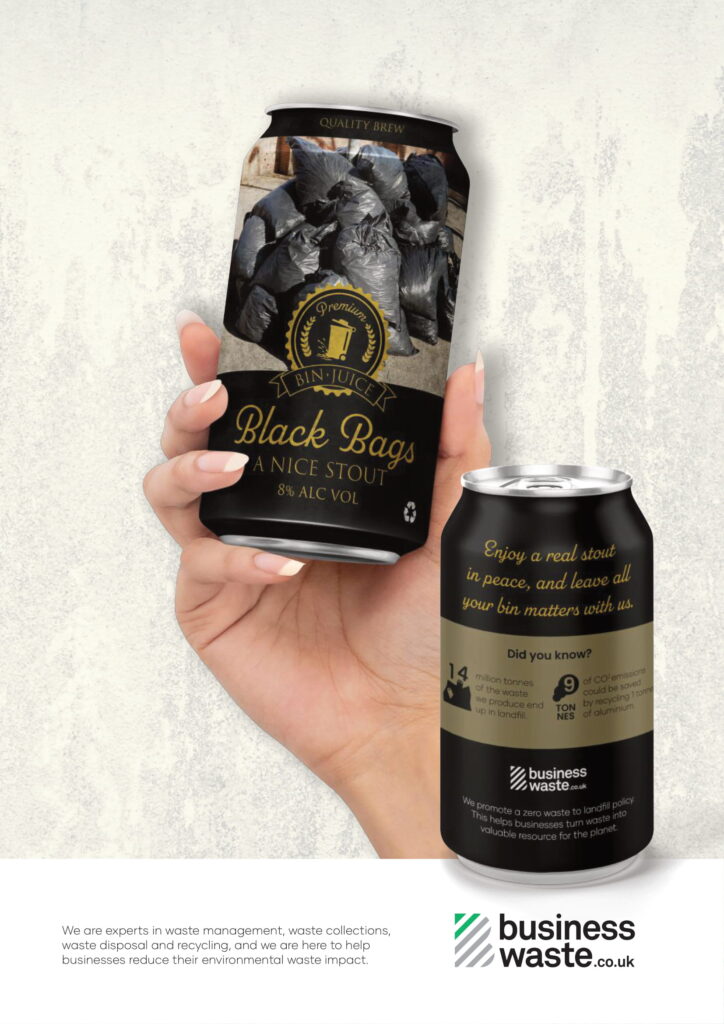
BusinessWaste.co.uk company spokesman Mark Hall says, “We’re always looking for new ways to get our eco-friendly message across, and who doesn’t need a drink after the year we’ve all had?”
“So kick back, relax, and get a Bin Juice down you – we’ve got the rubbish side of things covered.”
You’d better beer-lieve it!
The boozy new business venture between BusinessWaste.co.uk and Divert.co.uk has been brewing for a while and aims to get Britain talking about the environment while enjoying a refreshing can of ale.
“I’ve always wanted to make my own beer and this was the perfect opportunity,” says Hall.
“Once we drafted up the name for Bin Juice we knew we were onto a winner – who doesn’t want to drink something with a silly name?”
There’s something for everyone in the Bin Juice range, including the following flavours:
‘The Brown Bin’ – A nice earthy-toned brown ale
‘Hot Summer’s Day’ – A fruity sour beer
‘Black Bags’ – A nice stout
‘The Old Chair’ – A lemon and marshmallow premium flavoured beer
Hall: “All of our booze is completely rubbish-free, there is no bitter aftertaste and you won’t find any bin bags or bits of old chairs in your tinnie.
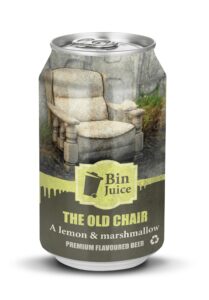
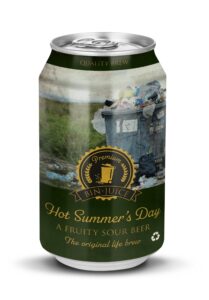
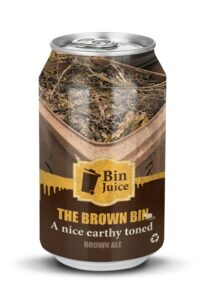
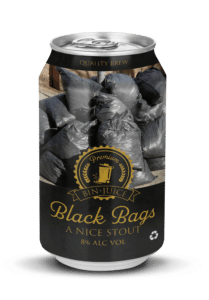
“The only thing rubbish about this ale is the name.”
The good news keeps flowing, as following Bin Juice’s success, a wine range using recycled glass bottles may be added to the collection.
Hall: “We know beer is not for everybody, so if you prefer wine glasses over beer goggles we’ve got you sorted.
“We’re thinking of calling it Chateau Binbag.
“Who knows, if the wine is a success maybe after lockdown we’ll keep going and open a pub called ‘The Dump’.”
Drinking at home? Yes, you can!
Bin Juice is the perfect beverage for drinkers who want to positively impact the environment, as each drink comes in a recycled can.
80 million aluminium and steel cans are sent to UK landfills every day, creating a mountain of waste that is doing nothing good for the planet.
Divert.co.uk and BusinessWaste.co.uk have tackled this growing problem head-on by recycling old cans for their Bin Juice range, reducing the amount that ends up rotting away in landfill.
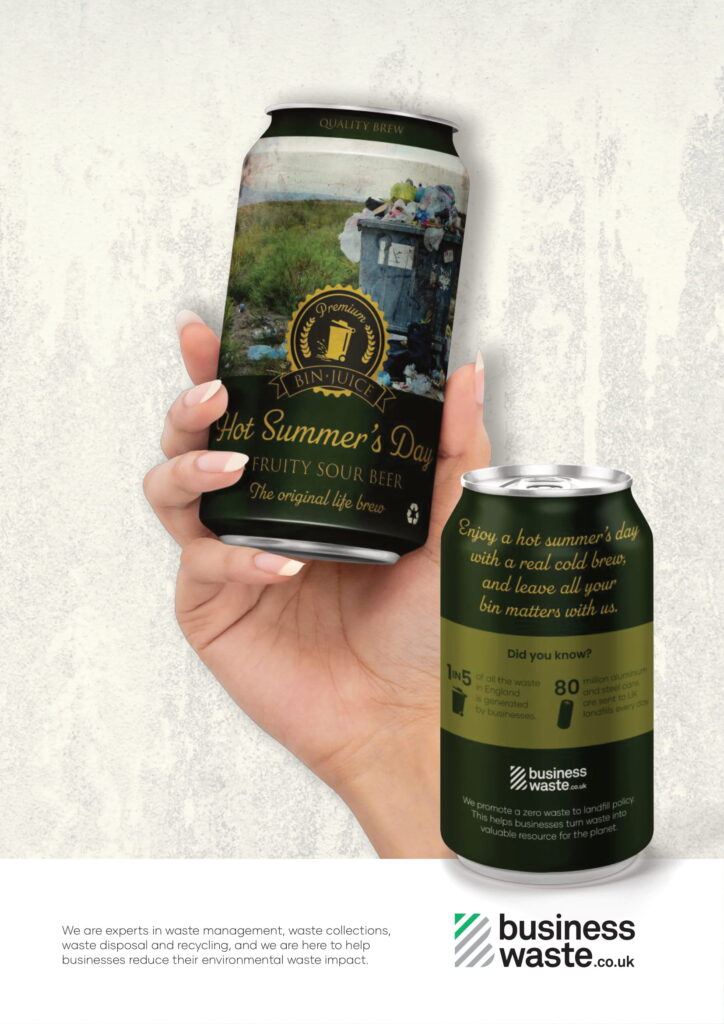
Hall: “Each can will be thoroughly sterilised before being repurposed for Bin Juice, so you’ll be happy to know there are no actual bin dregs in your drink.
“All the packaging can easily be recycled again, so the only thing getting wasted is you.”
And if you’ve found yourself drinking more than usual in the last 12 months at home then you’re not alone, as it’s estimated that a quarter of UK adults have reporting drinking more while the pubs have been closed.
UK pub gardens aren’t set to reopen until the 12th of April, with indoor seating not allowed until the 17th of May under the current government roadmap out of Covid-19 restrictions.
And those itching to throw some shapes on the dancefloor in a nightclub will have to wait even longer until the 21st of June when all restrictions are lifted.
“Look, the pubs are shut and you’ve been stuck inside drinking for a year, so why not mix it up and crack open a Bin Juice instead of your usual tipple of choice,” says spokesman Mark Hall.
“Forget about the sticky floors of your local pub during this lockdown, grab a Bin Juice and let the good times flow.”
Why not switch to a plastic-free alternative?
Enough plastic waste to circle the globe twice is the annual result of us cleaning our teeth with toothpaste from tubes that can’t be recycled.
With the global toothpaste industry worth tens of billions per year, one waste and recycling company thinks it’s high time its house was put in order.
The UK’s waste management company BusinessWaste.co.uk is concerned about the volume of plastic waste being thrown away due to toothpaste tubes and are calling for plastic free alternatives.
“Toothpaste is an essential hygiene item that people will always buy” says Mark Hall, company spokesman, “however the problem is the packaging; does it really need to come in a plastic tube?”
Brushing up on the facts
We use 300 million tubes of toothpaste every year. Spread end-to-end that’s about 75,000 kilometres of plastic, almost twice around the world. And that’s just users in the UK.
The problem is that they are usually made of different types of plastics, and many brands contain a metal layer inside the tube which isn’t easy to separate.
“A lot of toothpaste tubes have that layer of aluminium in to keep them fresh, but this makes it a recycling nightmare,” says spokesman Mark Hall, “so unfortunately most tubes will end up at a landfill.”
This worries BusinessWaste.co.uk, as on average, it takes 500 years for a toothpaste tube to fully biodegrade in landfill, meaning that every tube you have used in your lifetime could still be out there in a big hole in the ground.
Fortunately, pump-action toothpaste tubes can be easier to recycle, says Hall, but you will still need to check with your local council to see if they can be collected.
Not only are plastic toothpaste tubes bad for the environment, there’s a high chance you might not be getting your money’s worth with up to 10% of the product remaining when you think it’s empty.
“Manufacturers do this on purpose,” says spokesman Mark Hall, “it’s all designed to make you buy a replacement tube sooner.”
“Plastic toothpaste tubes aren’t beneficial for the earth or your value for money.”
Plastic-free solutions
With people growing more concerned about their plastic footprint, many companies are inventing clever solutions to reduce the amount of plastic we throw away, and this includes dental hygiene.
We’ve compiled a list of some of the best plastic-free toothpaste alternatives for you to sink your teeth into.
Glass Jars of toothpaste – Many zero waste shops now stock variants on this, either in a powder, or as regular toothpaste in glass jars. The jars can then be reused or recycled.
Toothpaste tablets – These can often just be popped in your mouth and crunched up like a sweet and then continue to brush like normal for pearly white teeth.
Solid toothpaste – You can buy solid toothpaste either on a stick that you apply to your teeth, or as a bar, then brush as usual.
Make your own at home – many websites offer recipes for making your own toothpaste, often including baking soda and coconut oil.
“While you’re at it, why not invest in a bamboo toothbrush or recyclable heads for your electric toothbrush?” says BusinessWaste.co.uk spokesman Mark Hall.
But if making the change to a plastic-free alternative is a bit much, one toothpaste brand is going the extra mile to reduce the amount of plastic tubes heading to landfill.
Leading brand Colgate have launched plastic-free initiatives, including a new vegan friendly toothpaste that comes in recyclable packaging which is made from the same material as milk bottles.
Colgate have also become part of the Terracycle scheme, where you can take your empty toothpaste tubes and plastic brushes to collection points for specialised recycling, and they can be turned into new items such as park benches.
“As Colgate brush up the competition, one thing’s for sure,” says Hall, “we all need to step up and do our bit to reduce toothpaste tubes going to landfill.”
“Let’s stop filling the earth’s cavities with dental plastic waste.”
To make recycling and disposing of waste easier, many manufacturers now include specific labels on their packaging. This means that whenever a consumer picks up a product, they know exactly what to do with it when they’re finished. In fact, there are several rules and regulations in place that mean these materials must be included in the packaging.
However, while some symbols are very clear in their instructions, others are used less frequently and may be a little harder to understand. That’s where this handy guide comes in!
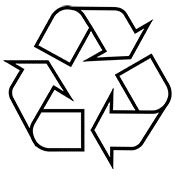
The triangle on its own means the product can be recycled. Typically, this means that the item can be disposed of with your general recycling. Sometimes, a variation of this logo exists with a percentage featured in the middle of the loop. This gives you an indication about how much of the product can be recycled.
As this is the most common logo displayed on recyclable products, you will likely come across it several times in a single day. This could include:
We produce large volumes of recyclable waste on a daily basis. In the UK alone, we produce around 12 million tonnes of recycling waste each year – which is just under 50% of our overall waste output. However, too often recyclable waste finds its way into general waste collections, meaning it’s disposed of incorrectly. In fact, a recent report by National Geographic found that 91% of plastic waste is not sent to a recycling facility.
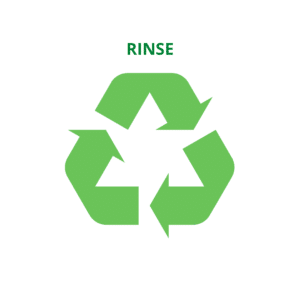
This symbol means that the item can be recycled, but it must be rinsed/cleaned before you throw it away. This is often used on food packaging and reduces the chance of your waste being contaminated or attracting vermin.
There are various types of products that feature this symbol. This includes:
Failure to rinse products before recycling them could mean that your waste is classified as contaminated. This means it may be impossible to recycle. Around 15% of dry mixed recycling bins are contaminated in this manner, which significantly reduces the material that can be recycled.
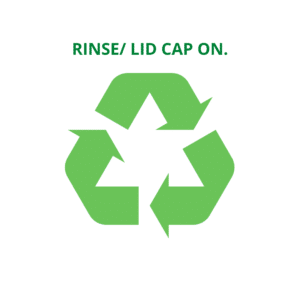
Products with this symbol can be recycled. However, you must ensure that they are rinsed and that their lid/cap is tightly secured. This is because small bottle caps can interfere with the recycling process. Furthermore, if they are thrown away in general waste, they could serve as a choking hazard.
A variation of this symbol will appear on any products with small caps/lids. This could include:
As this kind of waste mainly includes bottles and drinks containers, thousands upon thousands of them are thrown away every day. For example, in the UK alone, around 35 million plastic bottles are used every 24 hours- but the vast majority of them are not properly recycled.
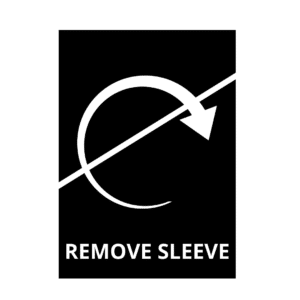
Unfortunately, not all packaging waste can be recycled. When you see this product, it may be that everything but the sleeve can be recycled – so ensure you take the time to remove it fully.
There are various products that feature this symbol. This includes:
Product packaging, such as sleeves, are used to help promote brand and inform as to what the products we buy are made from – whether they be food items or commercial products. However, they are often difficult to recycle, and as a result, packaging waste is a key contributor to crowded landfills. In fact, plastic packaging makes up for 70% of the UK packaging waste.
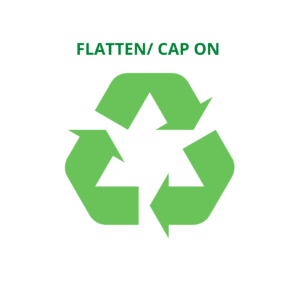
When this symbol is featured on a product, it means that before it is stored in the recycling bin you must flatten the item and ensure the cap is still on. This can help you maximise the space in your bins.
Numerous products will feature this symbol. This could include:
Keeping the cap on your bottles when recycling reduces the chance of the lid getting lost during the recycling process. For example, sometimes, the lids will fall through holes in machinery. Taking the proper steps to recycle this kind of product can reduce the damage that single-use plastics have on the environment. Currently, less than 10% of single-use products are recycled – despite millions of them being used daily.
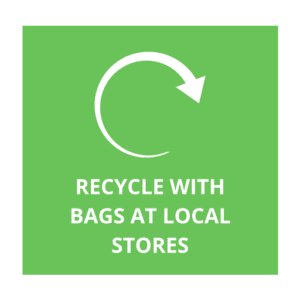
This symbol mainly relates to your household waste, and it means that the materials cannot be recycled through kerbside pick up. This is because the items may be slightly harder to recycle.
Various items can be recycled at your local supermarket. This includes:
It is hard to monitor the amount of waste produced in this category, as it covers a wide range of products. However, since their implementation, supermarket recycling points have had a positive impact on the environment by ensuring products that would otherwise be thrown away are now taken to the appropriate treatment facilities.

Whenever a green dot appears on packaging, it means that the company that produces the product contributes money to recycling schemes. Though it appears to suggest that a product is recyclable, this is not always the case.
This symbol features prominently on a variety of different products, namely in relation to packaging. This could include:
A large proportion of the waste we produce is non-recyclable. For example, in 2018 the UK produced around 37 million tonnes of waste, of which a very small fraction was sent to the appropriate recycling centres. Failing to source recyclable products, or disposing of them correctly, has an increasingly negative impact upon the environment.
There are various steps you can take to reduce the amount of waste you produce – both within your business and household.
Perhaps the most important step you can take to achieve this goal is to quite simply educate yourself. Before purchasing a product, do your research so that you know about the potential implications it can have on the environment.
Following this, you need to be prepared to implement real change. For example, you can change the way in which you shop. The most straightforward way to reduce this kind of waste is by making smarter, more environmentally friendly decisions when it comes to sourcing products and materials for your company or your home. For example, this could mean that you stop purchasing single use plastics in favor of materials that last longer and don’t need to be disposed of right away. In addition, you should also ensure that you buy the right amount of materials and supplies you need – so that nothing is going to waste.
You can also reduce the amount of waste you produce as a business by reusing or repurposing materials as much as possible. Put together a company recycling policy – and ensure that employees stick to it. Finally, you can reduce the amount of waste you use or dispose of incorrectly by working with a licensed waste disposal company – who can ensure that all waste is safely and securely disposed of.
There are several different types of plastic, and some facilities will require the plastic to be separated prior to collection. This is due to the fact that each type of plastic will need to be disposed of in a slightly different way.
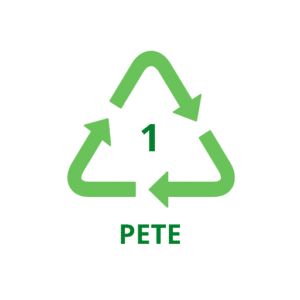
PETE plastic (or PET). is the most widely used form of plastic. In fact, around 70% of all plastic bottles and containers in the United Kingdom are made from PETE. Thankfully, it is widely recycled.
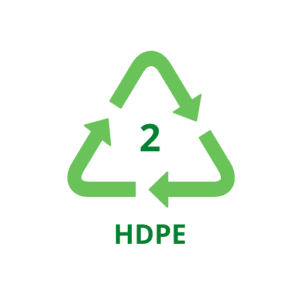
HDPE was typically used by those who work within the construction industry, as it was used to manufacture pipes. However, it is now also used to create containers such as milk cartons and cleaning product bottles. It is widely recycled.
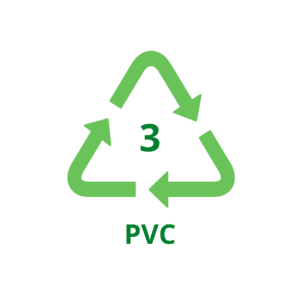
PVC, like HDPE, is typically used within the construction industry – to create products such as door and window frames. It is widely recycled.
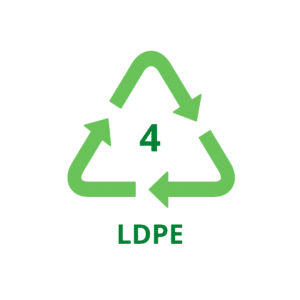
LDPE is often used to create plastic carrier bags and bin bags. Unfortunately, it is the most typically discarded form of plastic – with the world using around 500 million plastic bags each year – of which a small portion are recycled. Thankfully, there are now initiatives in place to recycle the products.
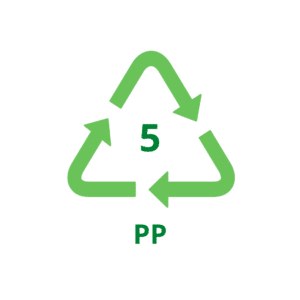
PP plastics are often used to create packaging, such as plastic tubs and containers, or drinks cartons. It can also be used to create furniture. This type of plastic can be recycled.
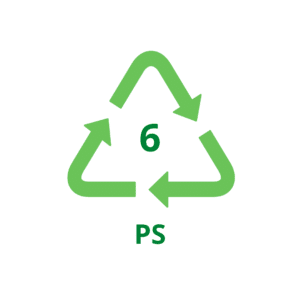
Polystyrene is sometimes referred to as styrofoam and is used predominantly within packaging, to protect fragile items from getting damaged. Polystyrene is not widely recycled and can pose a real threat to the environment.
Learn about polystyrene recycling
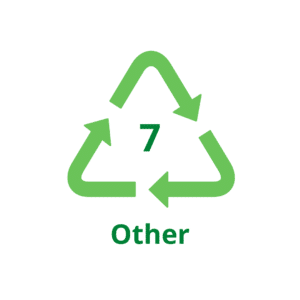
This section holds any type of plastic that does not fall within any of the above categories. It includes items such as fibreglass and acrylic plastic. Whether or not the items can be recycled varies.
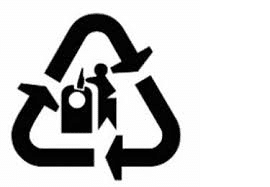
This symbol is added to packaging to remind consumers that the glass can be recycled after use. It is recyclable, even if the materials contained within it aren’t.

This symbol informs the user that the product is made from recyclable aluminium. For example, this is typically featured on tinfoil packaging.

This symbol means that the product is made from steel, which can be recycled. This could for example be found on steel cans.
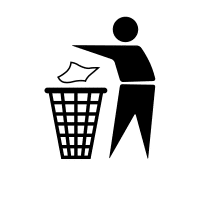
This symbol was introduced as part of a UK initiative to remove waste from the streets. It is known as the ‘Keep Britain Tidy’ scheme, and the inclusion of the Tidy Man on packaging encourages users to safely dispose of the product after use.

This symbol features prominently on electrical products, such as WEEE Waste – and signifies that they cannot be thrown away alongside your commercial waste.

This symbol means that the products or packaging can be composted. This could include food waste or garden waste, but also certain types of packaging – which you can dispose of via composting. On some occasions, a slight variation of this logo will inform you whether or not this can be composted at home or at a specialist facility.
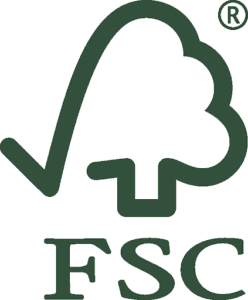
This symbol means that the product has been approved by the Forest Stewardship Council, meaning that it is produced in a way that is deemed environmentally friendly. It typically features on products made from paper, cardboard and wood.
It is important, as a business owner and consumer – that you take the time to fully understand what each of these symbols means. This can help you improve your recycling habits, working towards a better and brighter future.
In fact, there are many benefits of recycling at work. It means that you are cooperating with government-mandated regulations and can demonstrate to your customers that you are committed to protecting the planet. By implementing a strong recycling scheme at work you can also save your company a great deal of money while helping to reduce pollution.
If you’re looking for help with your waste management and disposal, please do not hesitate to get in touch. At Business Waste, we have years of industry experience, which means we are in a prime position to tackle any of your waste management and disposal needs; working to put together a plan that suits you.
To put it simply, commercial waste bins are bins or containers used to store commercial waste before collection. When used effectively, they can help business owners keep on top of their waste, working towards a more sustainable future.
Wheelie bins have lots of different names including;
Many commercial waste bins are referred to as Biffa Bins. This name can easily be attributed to the waste management company Biffa, who used to provide the vast majority of commercial storage solutions in the UK. Over time, many business owners began referring to this kind of bin as a ‘Biffa Bin’.
Much like Biffa Bins, the name Veolia Bin grew in popularity due to its association with the brand Veolia.
Many business owners also refer to Euro bins in relation to commercial waste bins. This kind of bin was typically used as an industrial stacking container but was quickly developed for waste disposal.
There are several differences between a domestic and commercial waste bin. For example:
Domestic waste bins are designed for personal or household use. As a result, they tend to be smaller in size than commercial waste bins used by businesses.
Some commercial waste bins can store potentially hazardous waste that cannot be disposed of in a domestic waste bin.
Domestic waste bins are typically provided to homeowners by the local council, who also arrange for their collection. Business owners are responsible for sourcing commercial waste bins for their property and ensuring that all waste is safely and securely disposed of.
As there are hundreds of different kinds of waste, there are numerous bins you can choose from – and it is essential that you chose the right option for your needs. That’s where we can help. We have the following options available:
Wheelie Bins are the most common type of waste disposal unit and are available in various sizes.
Weight limits: 10kg.
Dimensions and sizes: 1070mm (L) x 585mm (W) x 740mm (D)
Wheels: 2 Castors.
Lockable: Available as lockable.
How many bags of waste can be stored inside: This bin holds the equivalent of 3 bags of waste.
Weight limits: 15kg
Dimensions and sizes: 1090mm x 600 x 880
Wheels: 2 Castors.
Lockable: Available as lockable.
How many bags of waste can be stored inside: This bin holds the equivalent of 4 bags of waste.
Weight limits: 35kg
Dimensions and sizes: 1190mm x 1360 x 1070 (
Wheels: 4 Castors.
Lockable: Available as lockable.
How many bags of waste can be stored inside: This bin holds the equivalent of 10 bags of waste.
Weight limits: 65kg
Dimensions and sizes: 1300mm x 1360 x 1070
Wheels: 4 Castors.
Lockable: Available as lockable.
How many bags of waste can be stored inside: This bin holds the equivalent of 15 bags of waste.
Wheelie Bins can be used to store a wide variety of waste. This includes:
General waste
Paper
Cardboard
Mixed Recycling
Food Waste
Wheelie bin collection details:
The frequency at which your waste is collected depends on the volume of waste you are producing. This could result in daily, weekly or fortnightly collection.
No matter how complex your waste collection requirements are, we will take care of it, reduce your costs, and stop waste going to landfill.
Still searching for further questions and answers about wheelie bins?
Dimensions and sizes: 2.12m x 20.2m
Wheels: Loaders do not use wheels.
Lockable: Locks can be added for increased security.
Dimensions and sizes:2.00m x 1.68m
Wheels: Loaders do not use wheels.
Lockable: Locks can be added for increased security.
How many bags of waste can be stored inside: The volume of waste stored within the FEL depends on the size of the loader that you chose.
Loaders are often used to store large amounts of compactable waste. This could include:
Delivery and collection details:
As FEL and REL bins deal with compactable waste, you may not need to arrange for frequent collections, particularly if you are not producing a large volume of waste on a daily basis. We’ll work closely with you to develop a cost-effective plan that meets your needs.
Balers
Dimensions and sizes: There are various sizes of balers available, depending upon the amount of recyclable waste you produce. This includes portable balers, mini balers, and mill/large balers.
Lockable: Locks can be added for heightened security.
Balers work by compressing waste into smaller blocks. This means they can handle large volumes of waste.
What kind of waste can be compacted inside a Baler?
Balers are used to simplify the process of recycling by compressing recyclables into blocks. You can use them to dispose of the following waste safely:
Plastic
Metal (Aluminium) Delivery and collection details:
As Balers deal with compressed waste, you may find that you do not require regular collection services. At BusinessWaste, we’ll work closely with you to arrange for the timely collection of waste, developing a schedule that works for you.
Dimensions and sizes: 4 x 3 x 3 ft.
Wheels: n/a
Lockable: Open-topped
How many bags of waste can be stored inside: Mini Skips can hold up to 20 bags of waste.
Dimensions and sizes: 6 x 4 x 3 ft.
Wheels: n/a
Lockable: Open-topped.
How many bags of waste can be stored inside: Midi Skips can hold between 25-30 bags of waste.
Dimensions and sizes: 10 x 4 x 4 ft.
Wheels: n/a
Lockable: Open-topped.
How many bags of waste can be stored inside: Small Builders’ Skips can hold between 40-55 bags of waste.
Dimensions and sizes: 12 x 6 x 4 ft.
Wheels: n/a
Lockable: Open-topped.
How many bags of waste can be stored inside: Large Builders’ Skips can hold between 60-75 bags of waste.
Dimensions and sizes: 13 x 6 x 6 ft.
Wheels: n/a
Lockable: Open-topped.
How many bags of waste can be stored inside: Large Maxi Skips can hold between 90-110 bags of waste.
Skips are designed to store bulky, large waste. This could include:
If you are unsure which skip is best suited to your needs, check out our handy skip hire guide.
Skip delivery and collection details:
At BusinessWaste, we offer a range of skip drop-off and collection services. All you have to do is let us know what kind of skip you need when you need it and for how long. After that, we will provide you with a comprehensive waste collection plan and an affordable quote.
Certain waste, such as pharmaceutical waste, needs to be disposed of in separate bins or containers. This is to minimise the chance of cross-contamination and spillages and helps to ensure that waste is stored securely. There are many different types of specialist waste disposal bags and bins. This includes:
Yellow and Black Clinical Waste Bags
Size: Normal domestic waste bag size.
What kind of waste can be stored inside: Yellow and Black bags can be used to store non-hazardous Clinical Waste. This includes:
Yellow Clinical Waste Bags
Size: Normal domestic waste bag size.
What kind of waste can be stored inside: Yellow bags are used to store waste that is classified as highly infectious. This includes:
Orange Clinical Waste Bags
Size: Normal domestic waste bag size.
What kind of waste can be stored inside: Orange waste bags are used for waste that is labelled hazardous. This includes:
Medicinal Waste Bin
Size: Available in 11L, 22L and 50L.
What kind of waste can be stored inside: As indicated by the name, these bins are designed for storing medicinal waste. This includes:
Size: Available in 20-205L.
What kind of waste can be stored inside: Oil drums are used to store various oils before collection. This includes:
Intermediate Bulk Containers
Size: 1000L
What kind of waste can be stored inside: IBC’s are built to store large amounts of liquid waste. This could include:
If you have any further questions about our waste bins, bags, or collection services – do not hesitate to get in touch. We are always on hand to answer any questions you might have, or provide you with an affordable quote!
01 | Hazardous Waste.
By definition, hazardous waste is any waste that can cause harm to humans or the environment. Hazardous waste is produced in various industries and facilities. This includes:
The agricultural industry.
The construction Industry.
Production companies and factories.
Laboratories
Hazardous waste must be managed with caution due to the threat to both humans and the environment. Therefore, you must ensure that it is stored safely and securely before collection. We provide the following storage solutions for hazardous waste:
Orange chemical waste bags
Sharps Bins (Yellow lid)
Sharps Bins (Orange lid)
Sharps Bins (Purple lid)
Bulk containers
Once full, all bags should be tied securely to prevent any products from spilling out. They should then be left in an appropriate bin or container, depending upon the volume of waste you produce.
The Strategy for Hazardous Waste Management In England (2010). This legislation enforces a ‘duty of care’ on businesses, which means they must manage, store and dispose of hazardous waste safely and appropriately.
The Hazardous Waste Regulations (2005). This legislation was an expansion of the Hazardous Waste Directive (1991) and focused on tracking hazardous waste in England and Wales (i.e. how the waste is collected from premises).
There are various different ways that you can reduce the amount of hazardous waste you produce. For example, you should carefully research the materials you use to see if you can find a non-hazardous (or less hazardous) alternative. You should also focus on developing your business plan, to ensure that you purchase the right amount of products, thus effectively reducing the amount of waste you produce as a whole.
For an immediate quote call 0800 211 83 90
02| Landfill waste
Landfill waste refers to any waste that is taken to a landfill site after disposal. Each year, around 14 million tonnes of waste are sent to landfills in the UK alone. Therefore, it is unsurprising that various industries contribute to the rapidly overflowing landfill waste.
Examples of landfill waste:
Food waste
General waste
Packaging waste
Plastic waste
Wherever possible, you must reduce the amount of landfill waste you produce. For example, plastic can be separated from general waste and sent to a recycling facility. Despite this, you should use the following solutions to store your landfill waste:
Prepaid Waste Bags
Wheelie bins
Environmental Permitting (England and Wales) Regulations 2010. This legislation was put in place in line with the EU Landfill directive. Both work to control the products that are brought into Landfills. For example, you can no longer dispose of chemical or liquid waste at a landfill site.
The Environment Protection Act 1990. This legislation encourages business owners and companies to be mindful about the waste they produce, whilst also ensuring that it is safely and securely disposed of.
Proper education can significantly reduce the amount of waste sent to landfills each year. For example, you should ensure that all employees know which waste can and cannot be recycled, thus limiting the amount of waste sent to landfill sites. Wherever possible, you should also alter your purchasing habits to limit the use of single-use, non-recyclable products that can only be disposed of via landfills.
The cost of your landfill waste disposal will depend upon the amount of waste you produce. However, it is also subject to landfill tax. Landfill tax is an environmental tax, designed to minimise the amount of waste mistakenly sent to landfills that could be sent elsewhere.
03| Inert Waste
Inert waste does not pose any threat to the environment or human life. However, it takes a long time to decompose. In many cases, it does not decompose at all. This is because it is not biologically or chemically reactive. It is used in a lot of industries, including:
The construction industry
The agricultural industry
Inert waste examples:
Typically, you will be dealing with inert waste in large bulk quantities. This means that you need to ensure that you have the appropriate containers and storage solutions on hand. This could include:
Wheelie Bins. Our bins are available in a wide range of sizes, from 240L to 1100L.
The Landfill (England and Wales) Regulations 2002. Following this legislation, inert waste must be disposed of at specialist landfill sites, though precautions should be put in place to limit the amount of waste you produce.
The most straightforward way to reduce the amount of inert waste produced by your company or business is by managing your stock more efficiently. For example, you should ensure you buy the correct amount of materials you need each year, to reduce the risk of certain products going to waste.
For costs for inert waste collection please contact 0800 211 83 90
04| Scrap Metal Waste
Scrap waste refers to waste that is leftover when a product is being manufactured or consumed. This could include surplus supplies or building materials. Many industries produce scrap waste; this includes:
Scrap waste examples:
The large majority of scrap waste are metals. This includes:
The large majority of scrap metal can be recycled or repurposed. You may also be able to sell your scrap metal to earn a small profit. However, to achieve this, you need to ensure that your scrap waste is kept separate from other products, to allow for easy collection. To do this, you may need to use a variety of storage solutions. This could include:
Scrap Metal Dealers Act (2013) If you are planning on selling your scrap metal, you need to ensure that you work in accordance with the Scrap Metal Dealers Act. This law dictates that it must be sold to a licensed dealer.
There are numerous ways in which you can reduce the amount of scrap metal waste you produce. This begins with more efficient management to ensure that you reduce the amount of waste you produce overall. Following this, you can focus on improving employee efficiency, minimising the amount of scrap produced.
For local metal waste collection and disposal prices please call 0800 211 83 90
05 | Bulky Waste Items
Bulky waste is any waste that is too large to be collected with your regulation waste collection. This is produced by a variety of industries, including:
Bulky waste examples:
Due to its size, bulky waste cannot be stored in traditional wheelie bins or containers. However, larger storage solutions are available, including:
Front-end loaders
Rear-end loaders
Skips
Man and van rubbish removalYou need to arrange ‘one of’ collections for bulky items, and may not need such a permanent storage solution.
The Environment Protection Act (1990). Bulky waste must be stored safely and securely before collection. This is particularly true if you are dealing with WEEE products, which may contain harmful chemicals or materials.
For a immediate price for a one off collection call 0800 211 83 90
06| Builders’ Waste
To safely and securely store your builders’ waste, you will first need to separate the waste into different sections. For example, some items, such as asbestos are considered hazardous and must be disposed of accordingly. Here are some of the storage solutions we offer for builders’ waste.
The Waste (England and Wales) Regulations 2011. This legislation applies to various fields outside of construction waste but places a duty of care on companies to ensure they minimise the amount of waste they produce.
Builders’ waste can be reduced by effective management and training. For example, employees should be taught how to make the most of the resources available to them, thus reducing the amount of waste they produce daily. Wherever possible, you should also ensure you have a variety of recycling facilities on site, that allow you to better manage the waste you produce.
How much does it cost to dispose of builders’ waste?
For local skip prices or one off waste clearance call 0800 211 83 90
07| Green Waste
Green waste is sometimes referred to as biological waste and can be fully composted. Green waste is produced by a variety of industries, including:
Green waste examples:
Various storage solutions can be used to store green waste. This includes:
The storage solution you use will depend largely upon the amount of green waste you are producing. We are also on hand to arrange regular collections to meet your needs.
The Waste (England and Wales) Regulations 2011. There are no specific regulations relating to green waste, though companies must ensure that they work to meet general waste regulations, as dictated in the Waste Regulations (2011).
You can reduce the amount of green waste you produce by setting up a space for composting on-site. This could prove particularly useful if you work within the agriculture industry, as it proves to be beneficial in the growing of plants and crops.
For local green waste disposal costs please call 0800 211 83 90
08 | Recyclable Waste
Recyclable waste refers to any waste products that can be recycled. This means that it can be reused, repurposed or sent to a specialist recycling facility and given a new life. Many industries produce recyclable waste, including:
Recyclable waste examples.
Depending on the type of recycling waste you produce, you may need to separate each product prior to collection. However, you can also store dry mixed recyclables in one container. There are various different storage options available, including:
Wheelie bins
Skips
Recycling balers
UK Waste Regulations (2015). This legislation dictates that businesses must separate their recyclable waste from their general waste. This was put in place to reduce pressure on overcrowded landfill sites.
The Environmental Protection Act (1990). This legislation was established to ensure that companies, businesses and individuals take responsibility for the waste they are producing, and operate with the environment in mind.
Thankfully, there are various steps you can take to reduce the amount of recycling waste you produce. For example, the vast majority of waste produced within office or administration settings is paper waste. You can reduce this initially, by going paperless and digitising your files. This means you will no longer need to purchase paper products. Another way to reduce recycling waste across your business is by providing your employees with easy access to recycling bins. This means that you reduce the chances of recyclable waste ending up in your general waste bins.
How can business waste help?
At BusinessWaste, we provide a range of waste collection and disposal services on your behalf. This means you will not have to hire multiple waste companies to manage your company’s waste – we’ve got you covered.
Our services include:
Arranging waste collections through BusinessWaste.co.uk could not be easier. To begin, get in touch via our website, or call on 0800 211 8390. Our expert team will be on hand to answer any questions you might have and can provide you with a quote in 7-10 days.
Following this, we’ll work closely with you to put together a waste collection plan that works for you and your business. We can arrange for daily, weekly or monthly collection of waste and provide you with the appropriate storage solutions, including FREE bins to install on your premises.
You can find out more about our commercial waste disposal services here. To learn about business recycling click here.
Why are you still sending Christmas cards?
It’s time to ban this outdated, wasteful festive pastime
It’s the most wonderful time of the year, trim the tree, stuff the turkey, and reach out to loved ones, but you’re unwittingly wasting literally tonnes of paper through wasteful Christmas cards.
According to Britain’s fastest growing waste collection company, it’s time to ban the old tradition of sending cards, as they are terrible news for the environment.
Christmas grinches BusinessWaste.co.uk say we need a ban on unrecyclable glittery Christmas cards, to go with the self-imposed ban some stores have on Christmas decorations that use glitter.
“We know most people will see us as The Grinch trying to ruin Christmas, but unfortunately for our environment, the season creates a waste problem that lasts all year long,” says company spokesperson Mark Hall.
“The Christmas card tradition has had its day, and now it’s time to make eco-friendly choices during the jolly holidays.”
READ – ALL THE CHRISTMAS WASTE FACTS
To send, or not to send
The sending and receiving of Christmas cards can be traced back as far as 1843, the same year that Charles Dickens published A Christmas Carol, and it’s estimated that now around a billion cards are sent every year in the UK.
But unfortunately, the vast majority of these cards end up in landfill, as the widely recyclable cardboard is often contaminated with shiny and glittery decorations.
“People seem to think that sending Christmas cards doesn’t do much harm to the environment because of the perception that all cardboard is easily recycled,” says BusinessWaste.co.uk’s Mark Hall.
“However, this couldn’t be further from the truth. People chuck their cards into the recycling bin, which causes havoc at recycling centres causing whole loads of paper to be dumped because it’s contaminated with glitter.”
This problem is why leading retailers Waitrose, Morrisons, and John Lewis have banned glitter this year across their own-brand Christmas products, including cards and wrapping paper, as glitter can take hundreds of years to biodegrade.
But not only are Christmas cards awful for the environment, they cost you a small fortune too as the Christmas card industry in the UK worth £1.7 billion, higher than anywhere else in the world.
“By the time you’ve gone out and bought enough to send to everyone and painstakingly handwritten them out, you’re then stung with postage costs,” says Hall.
Hall: “I bet you’ve never considered how much CO2 delivery trucks use to get card up to beloved Aunt Edith 400 miles away, while getting the billion other cards to the right addresses in the same month too!”
Five great alternatives to Christmas cards
For most of us this year, sending a Christmas card is the closest contact we can offer – which is why BusinessWaste.co.uk have come up with some sustainable ideas of how to send Christmas messages to your nearest and dearest.
Make your own cards – Ditch the glitter and get creative using items you might already have laying around your house from last Christmas.
Pick up the phone – Reach out to those you haven’t been able to see this year with a phone call, people will appreciate your time for a catch up much more than a card in the post.
Send an E-card – For the more tech-savvy, why not send a personalised e-card to your friends and family, plus you can send these all around the world at no cost at all.
Use eco-friendly cards – There are plenty of companies offering eco-alternatives to Christmas cards, just make sure they are from a sustainable source, and free from glitter, glue, and foil. And try to hand deliver as much as possible, socially distanced of course!
Donate to charity – Take all of the money you would have normally spent on cards and postage and donate to a charity of your choice on the behalf of your recipients. The money will go much further for a charity than sending a one-off card to your sister.
There is plenty you can do with the cards you might receive this year too, such as reusing the images as gift tags for presents or use them to make your own cards for next year so that they don’t end up in landfill.
Hall: “We need to start viewing Christmas cards as a single-use waste product, because that’s essentially what they are.
“And once we start phasing them out and using alternatives like we have with plastic bottles and straws; it’ll be much cheaper for us and far better for the planet too.”
The disposable spooky season is only scary for the environment
For a year that’s already been quite scary for a lot of people, the spookiest time of year is creeping up on us, and frankly we’re not looking forward to it.
The scary truth about Halloween is that there is plastic hidden in pretty much every aspect of celebration, from shabby costumes to the cheap plastic decorations and sweet wrappers.
All of this plastic pollution has left a sour taste for UK based waste collection specialists BusinessWaste.co.uk, who are calling for a ban on Halloween if it doesn’t become a plastic-free festivity.
“Halloween is one of the biggest events of the year, but the amount of waste it generates is disgusting,” says company spokesperson Mark Hall.
“It’s your choice, either ditch the waste or we will have no choice but to ban Halloween.”
Monstrous materials
One of the most popular ways people celebrate Halloween is by dressing up in ghoulish fancy dress, but how damaging can this be for the environment?
In 2019, it was estimated that 2,000 tonnes of plastic waste would be created by Halloween clothing, which was the equivalent of 83 million plastic bottles.*
As a nation we already throw away 7.7 billion bottles a year**, so the amount of plastic generated from creepy clothing adds an extra layer to an already huge problem.
Not only is buying a new Halloween costume every year bad for the environment, but over the years it starts to add up, so Business Waste are asking the nation to seek other options for fancy dress.
Some alternative ideas for dressing up are:
· Make your own costumes from charity shop finds – See what creative costume ideas you can make using preloved items in charity shops, plus the money goes to a good cause.
· Swap costumes with friends and family – Try switching outfits with friends or family to wear something new.
· Make your own with household materials – Fed up with generic shop bought costumes? Get creative with household items and think outside the box to be really unique.
Hall: “This all goes for decorations as well as costumes, there are plenty of ways you can set the spooky vibe without covering it in a layer of plastic.”
Petrifying plastics
To be able to throw a zero-waste Halloween means finding an alternative way to give out trick or treat sweets, as most come in plastic wrappers.
Hall: Plastic wrappers have to go, and if you can provide an alternative that’s great, especially as giving away so many sweets is only encouraging obesity anyway.
The most eco-friendly way would be to make the switch from wrapped sweets, and there are plenty of alternatives available.
The healthier option is to give away fresh fruit and vegetables, such as carrots or apples, to trick or treaters, but for those with a little bit more time on their hands, why not bake some cookies or brownies to hand out.
“Treat or treat is just awful for the environment, people go out and buy a big plastic bag full of smaller plastic bags of sweets – it’s an environmentalists’ worst nightmare,” says company spokesman Mark Hall.
“All the extra plastic will end up in landfill, that’s if it’s not already been littered somewhere by those who cannot wait to get home before tucking in.”
Carving up a nightmare
After all that, you might think that the most eco-friendly way to celebrate Halloween is to carve a pumpkin, but new research shows that more than half of pumpkins that will be bought for Halloween this year will not be eaten.***
“Pumpkin carving at Halloween is promoting food waste, nothing gets eaten and it gets thrown in the bin,” says Hall.
“There are people starving while people are wasting food as decorations. This behaviour needs to be stamped out.”
Only 42% of those intending to celebrate Halloween this year know that the inside of a pumpkin is edible***, meaning that a mountain of gourds will be heading to landfill.
Hall: “Major changes need to be made, or we will have to ban Halloween to help save our planet.
“The amount of waste just one day creates quite honestly scares the hell out of me.”
It goes without saying that there are numerous benefits to recycling. Firstly, it allows products to be reused as opposed to being improperly disposed of in a landfill. Landfills emit dangerous pollutants into the air, causing damage to the planet and the ozone layer. Secondly, recycling helps to protect the environment from further harm. Additionally, by opting to only purchase products that can be recycled, we are reducing the demand for single-use plastics and are, therefore, moving towards a more eco-friendly and sustainable future which will allow us to minimise our impact on the environment.
There are three main types of recycling.
Primary recycling refers to a product that can be reused without altering its current state or purpose at all. This means that once recycled, it will serve the same function again. An example of this is when you reuse a single-use plastic water bottle several times to avoid throwing it away after one use.
2) Secondary recycling
Secondary recycling is when we repurpose a product for alternative use, without it being processed or altered at all. For example, you may use leftover materials for a DIY or arts and craft project. One way in which you can do this is by using newspaper to create papier-mâché art.
3) Tertiary recycling
Tertiary recycling is when recyclable materials are collected and altered (often chemically) in order for them to be reused as something else. This is typically what happens when our recyclable waste is collected and sent to a centre.
There are a large variety of products that can be recycled, and although the below list is by no means comprehensive, it should give you an idea of what items you can recycle.
– Mixed paper
– Magazines
– Plastic bottles
– Cardboard
– Cans (tin, aluminium, steel)
– Glass containers/jars
– Glass bottles (wine etc.)
Natural recycling refers to adapting our practices to ensure that our products can always be reused – if not, they should be broken down in a way that doesn’t harm the planet. It aims to replicate the way in which the earth naturally makes use of its waste. For example, plant and animal decay become part of our soil.
In order to practice natural recycling, we should attempt to reuse everything we purchase, where possible. We can also begin the practice of composting, as this allows us to reuse non-recyclable materials such as food waste to benefit the environment.
Unfortunately, there are some materials that cannot currently be recycled. It is important, where possible, to cease using these products or at least minimise our consumption of them. They include:
For more information on recycling click here to learn about waste disposal click here and for waste collections click here.
Learn how to set up a recycling scheme at work
What are the advantages of recycling?
With charity shops closed, people have found other ways to get rid of unwanted items.
The great ‘Covid-19 clear-out’ across the UK saw many people who were furloughed or working from home having an almighty sort out of their homes – leaving charity shops bereft of donations.
Now that charity shops are beginning to reopen, UK waste and recycling company BusinessWaste.co.uk has learned that donations have more than halved on previous years, as people are too impatient to wait for them to reopen and have thrown away their potential donations.
“The natural cycle of throwing things out has been shaken up with the Coronavirus lockdown,” says company spokesman Mark Hall.
“Because it’s taken so long to reopen charity shops, three months’ worth of items have ended up in local landfills, or wrapped up as gifts for the poor individuals who’ve had lockdown birthdays.”
The joys of regifting
People have been waiting impatiently for charity shops to return, and it has driven many to throw their unwanted items away at local recycling centres.
In fact, tips were so busy when they reopened in some parts of the UK, local councils have been asking people to book a tip run appointment in advance.
But ultimately this has had a knock-on effect, as charity shop volunteer Wendy tells us: “it’s a shame for us because the government allowed the local tip to be opened before us, so naturally people took all of their stuff there.”
But some of the lucky items that weren’t slung into a giant bin at the tip have found themselves in the reluctant hands of family and friends.
UK based waste specialists BusinessWaste.co.uk asked people online about regifting during the lockdown, and it turns out some have absolutely no shame in offloading their junk onto their loved ones:
• “I had the worst birthday ever in lockdown, all of my family just gave me their old junk. My grandad gave me a dictionary that was printed in 1983, and all the pages with naughty words on them were ripped out so I couldn’t even get a laugh out of it.” – Chris, Leicester
• “I sent my niece some bits for her birthday through the post, including a toiletry set I got for Christmas. But because I’d opened it and used a little of the moisturiser before I decided to give it away, it leaked all over the place and ruined everything in the box.” – Jill, Weymouth
• “My brother gave me some DVDs, and to be honest I was looking forward to watching Fight Club until I opened the case and found the disc for The Sound of Music instead. To be fair, there were a few fight scenes towards the end, so it wasn’t a complete loss.”- Jack, Taunton
• “Bath salts? No thanks” – Vic, Basingstoke
When the doors do not reopen
For some charity shops in the UK, their donation days may be over.
Charity shops have only recently reopened on 15th June after almost three months of being closed, meaning that a lot of charities have lost out on a quarter of the year’s potential takings.
Charities such as Cancer Research are predicting a decline in fundraising income by 25%, and Oxfam has been losing £5million a month in revenue with all their shops closed.
Age UK have announced that they will have to make some staff redundant as they prepare to close stores, and one branch of The Wessex Cancer Trust in Cosham is only reopening its doors for a large clearance sale before shutting up shop for good.
Mark Hall: “It’s such a shame for these shops to be closing, but without donations, fundraising and sales, they cannot afford to continue.”
But the shops that are reopening will gladly take any donations, and to reassure customers that they are safe from contamination, all donations will be quarantined for three days and disinfected before going on the shelves.
If you’re unsure if your local charity shop is accepting donations, BusinessWaste.co.uk recommend calling ahead to ask them instead of assuming they don’t want your stuff and dumping it.
Hall: “You never know, someone out there might be desperately searching for your unwanted copy of Robbie Williams Greatest Hits.
“OK, perhaps not.”
Also, please don’t use someone’s garden as a toilet
With public toilets as well as loos in pubs and shops being closed during the Covid-19 outbreak, there’s been an outbreak of what can only be described as “fly peeing”.
In the true nature of ‘if you got to go, you got to go’, waste management company BusinessWaste.co.uk are hearing reports of people turning local beauty spots into public bathrooms, and increasing numbers of bottles of urine appearing along main UK roads.
“Easing of lockdown measures means that people are venturing out for day trips, but unfortunately many councils haven’t reopened their public toilet facilities due to social distancing measures,” says company spokesman Mark Hall.
“Instead, people are fly-tipping UK roads with bottles of wee – perhaps we ought to rename this environmental crime fly-peeing.”
“Can’t you tie a knot in it?”
One group that have been a constant on our roads during the lockdown are the delivery drivers who have been delivering essential items up and down the country, but Business Waste have heard from many admitting they have resorted to using plastic bottles as a substitute toilet.
Many truckers are concerned about not being unable to stop due to a lack of open facilities, or being too frightened to stop at services and potentially risk catching Covid-19.
And that’s led to the hideous sight of plastic bottles full of pee in laybys up and down the country. And to be fair, it’s not only truck drivers, but regular drivers too.
Trucker Mark Taylor of Addingham tells us: “I’m old and my bladder isn’t as strong as it once was, but I haven’t been able to stop for a wee because most services have been shut.
“I’ve had to pee in my Lucozade bottle, but it tends to get a bit smelly in the cab, so I’ve thrown a few bottles out of the window.”
But not all drivers are participating in this behaviour, with delivery driver Eric telling us, “I’ve got a plastic-free reusable bottle that cost me twenty pounds – I would have to be really desperate to use that for a urinal and throw that kind of money away.
“Just pick your spot and go behind a tree, like normal people.”
Mark Hall of BusinessWaste.co.uk says, “Just because the toilets are shut and desperate times are leading to desperate measures, we still need to not be adding to the plastic pollution problem by chucking bottles out of the window.”
“Some for waste disposal operative’s got to go out and pick up all those stinking bottles. Take your litter home, you animals.”
It’s not just the pee – it’s also the 35m plastic bottles being thrown away every year in the UK.
“Plastic bottles can take up to 450 years to biodegrade, so if you’re chucking one out of the car window full of wee it could be sitting there for years,” says spokesman Mark Hall.
“There’s poo in my front garden”
The imminent reopening of public toilets comes too late for beauty spots around the UK.
One of many reports comes from a care-worker in Burnham-on-sea in Somerset, who says she has had to battle countless people urinating and defecating in public, with several incidences happening against her garden fence.
Hall: If the toilets are closed, then desperate people will go wherever want, which unfortunately spoils the area for local residents.
One lady in a resort in Dorset says: “People are travelling the length of the country for a day at the beach, meanwhile those of us who live here have to put up with the horrible sights and smells they leave behind. I found human poo in my front garden, and next door found a bottle full of wee in his recycling bin.”
Hall: We’re not the police, but we have to remind people that it is illegal to be caught urinating in public and that if you’ve been seen in the act you could be done for indecent exposure too.
“All I can suggest is what I tell the kids – make sure you’ve been to the toilet before you go out. Or tie a knot in it.”
It’s time to clean up our binning habits
With the world’s focus firmly fixed on the Covid-19 virus pandemic, maintaining perfect hygiene has been at the forefront of everyone’s minds.
However, a national waste company notes that while people are following the advice of healthcare officials, the resulting waste may not be doing much good for the planet.
Waste Collection experts BusinessWaste.co.uk has lifted the lid on the fact that with more hand sanitisers and liquid soaps being used, these single-use plastics are not always being efficiently recycled.
“Although it’s fantastic to see that people are really taking personal hygiene seriously, we have a duty to fulfil to our planet,” says company spokesperson Mark Hall.
How to tackle the plastic problem
The bottom line is that we all need to make sure that we are recycling as much as we can.
But with the nation buying every single bottle of liquid soap and hand sanitiser it can lay its hands on, BusinessWaste.co.uk sees up to 10 million empty bottles ending up in already stretched landfill sites.
“Times may be frightening and confused for many individuals during the COVID-19 outbreak, we cannot allow ourselves to fall into the bad habit of just chucking everything into the general rubbish,” says Mark.
“With everything currently up in the air, it’s understandable that recycling practices may not be everyone’s main concern right now,” says Hall, “but we need to make sure we continue recycling for the future.”
Most households and businesses now separate their rubbish into recycling bins – but the worry is that this will become seen as unimportant as people worry about their health.
And it’s feared that levels of recycling will drop during this global pandemic, says a concerned Mark Hall, but we have to keep stressing to people that as they use more hand sanitiser and soap, these plastic bottles could infesting the planet long after Coronavirus is gone.
“We don’t want one of the lasting legacies of Coronavirus to be the vast number of hand sanitiser bottles polluting our oceans and piling up around the world, but unfortunately it will be if we don’t act now.”
Recycle and shop smart – it’s really that easy
Plastic bottles are one of the most commonly recycled waste products, but it is important that they are recycled correctly. Fortunately, this is an incredibly simple process.
• Wash out the bottle to remove all residue and avoid contamination
• Take the cap off of the bottle, as different grades of plastic will be recycled separately
• Make sure soap bottle pumps are removed as they are not currently recyclable in the UK
• Place the bottle into your recycling bin ready for local collection
“If the hand sanitiser you’re carrying around in your bag runs out, we understand that the easiest thing to do is chuck it into the nearest bin,” says spokesperson Mark Hall, “but really the best thing you can do is to take it home, rinse it out, and recycle it. The environment will thank you for it.”
Another recycling method that BusinessWaste.co.uk hopes people will make use of is to refill existing plastic bottles once they’ve been rinsed out, to reduce the demand of manufacturing more plastic that could otherwise end up in a rubbish tip.
With the rise of local ‘zero-waste’ shop, it’s easy to find out where you can take your own containers and reuse them to stock up on cleaning essentials such as detergents, surface cleaners and soaps.
Soap manufactures Carex have recently launched a scheme which aims to get people to reuse their existing soap bottles. Refill pouches of soap can be purchased to fill soap pumps, and the pouches can be recycled through local Terracyle collect points, which can be easily found online.
“You can also buy bars of soap, which are just as effective at keeping your hands hygienically clean and have the added benefit of often not coming in plastic packaging,” says Hall, “Plus you’re bound to have a stash laying around from years of Christmas gift sets from your nan.”
So, while the world scrubs up, it’s important to remember the impact that plastic sanitizer and soap bottles will have in the future, and that we have to do something now to avoid millions of unnecessary bottles being dumped into landfills.
“We need to make sure that not only are we looking after ourselves, we need to be doing it in a responsible way that looks after the environment.”
As people overstock, bins are overflowing
As people prepare to self-isolate to help prevent the spread of Covid-19, many are afraid that they will run out of everyday essentials.
But as people flock to the shops to fill their cupboards, is this doing more harm than good?
BusinessWaste.co.uk, a national waste collection company, warns that panic buying will result in more food being thrown away as people are buying far more than they need.
“At the moment there is a huge strain on supermarket supply chains to ensure there is enough food to go around during these difficult times,” says company spokesperson Mark Hall.
“People should only buy what they need, otherwise they will only be throwing a lot of it away when it all goes out of date. There’s only so much you can eat.”
Greed in the aisles, bare shelves and full fridges
Fears of being housebound for the foreseeable future are causing people to fill up their cupboards, fridges and freezers in a bid to make sure they don’t run out of food.
“Coronavirus is sending people into an overbuying frenzy,” says Hall, “They’re wasting money on things they don’t even need or want, and it’ll only end up in the household bin.”
Hall explains that you only need to see the empty shelves of your local supermarket to understand the extent of the problem.
“I went into Waitrose and got the last pot of hummus, but the olives were already gone”, says shopper Steven from Harrogate, “What if I want to throw together an impromptu mezze board?”
Susan, a mother of three from Chesterfield, who was searching her third supermarket of the day for supplies sums up the national mood: “I’m only stockpiling because everyone else is. If I don’t get as much as I can when I see it, who knows when I’ll be able to get hold of it again?”
But as some clear the shelves and overfill their cupboards, Business Waste are concerned that others will be unable to get hold of basic supplies, which is why they are recommending that shoppers only buy what they know they will use in sensible quantities.
“Some people cannot spend more than a set budget every week, therefore are unable to buy in bulk,” says Hall.
“It’s not fair to these people to excessively fill up your cupboards with fifteen bags of potatoes and a month supply of bread which goes in the bin, when the likelihood is that most of this food will end up in landfill anyway. If everyone only buys what they need, then we can massively reduce the amount heading into the trash.”
Should we be limiting how much food we buy?
Many supermarkets have recently taken action to try and prevent stockpiling, by introducing war-like rations on how much people can buy.
Supermarkets such as Asda, Tesco and Sainsbury’s have restricted shoppers to a certain amount of each item, including everything from groceries to toiletries, in a bid to stop stockpiling and in due course a huge volume of waste.
As BusinessWaste.co.uk’s Mark Hall points out, these policies will be pivotal to making sure that people get the resources they need, without there being an increase in waste.
UK supermarkets are also introducing schemes to make sure that vulnerable customers can come in and safely get their shopping, such as only opening for the first hour to the elderly.
But as Hall highlights, it’s not just the elderly we need to be considerate of, it’s people with dietary requirements as well.
“I can’t drink dairy, and everyone has been buying all the milk alternatives,” says Ben, a worried shopper from Woking. “What am I supposed to do?”
“All the gluten free stuff’s gone,” Laura of Reading says. “I’m coeliac – help, anybody?”
“We need to be mindful of others when we shop,” says Hall, “We need to leave enough for other people and not just buy it all and shove it into freezers. You could be denying a neighbour of something they desperately need.”
“It’s much better to make sure there’s enough food for everyone, than to buy too much and chuck it in the bin.”
And remember, if you do still have food scraps, at least make sure it is recycled with household food collection schemes, or better still, compost it.
As supermarkets struggle to fulfil demand, calls for unwanted food to be redistributed.
As people prepare to stay at home for weeks on end, many businesses are feeling the full force of the Covid-19 pandemic as they close their doors to the public for the foreseeable future.
Establishments such as hotels and restaurants will see their fully stocked kitchens potentially going to waste while supermarket shelves are being laid bare on a daily basis.
This irony is not lost on BusinessWaste.co.uk, a UK commercial waste collection company, who feel that these hospitality kitchens may be an untapped resource in our time of need, and calls for the sensible redistribution of unwanted food.
“Supermarket shelves are being ransacked everyday as people frantically stockpile, meanwhile there’s plenty of food sitting in unused kitchens,” says company spokesperson Mark Hall.
“Surely hospitality businesses need to be making this food available to the public, otherwise much of it will go out of date and end up in the bin, which would be such a waste.”
Checking out, not chucking out
Restaurants, hotels and cafes are now switching their food service to takeaway status, but business is set for a nose-dive.
Many businesses pride themselves on serving fresh foods, but with no one to eat them a huge amount of food looks like it will definitely be going to waste.
Felicia is a chef from a top hotel, and she worries about the amount of food left behind as her employers ended trade this week. “As we hung up our aprons at the end of the last shift, I left knowing that all of our freezers had been recently completely filled, and that the fridge was rammed with fresh ingredients.”
“A few of us took bits home, but I know that when I go back, I’ll have to throw a disgusting amount of food away. It’s just not right.”
The hospitality sector already produces 920,000 tonnes of waste a year in the UK (that’s enough for 1.2bn meals – Source: WRAP), and this number looks likely to increase due to the waste that will be created by so much uneaten food during this outbreak.
“All of this comes at a time where fights in supermarket aisles become a daily occurrence, as people scrap over the last precious tins of tomatoes and fresh loaves of bread, which goes in the waste collection bin, blissfully unaware that the closed-down businesses they drove past on the way may have everything they were looking for in their kitchens and stockrooms”, says company spokesperson Mark Hall.
“There’s a large amount of food sitting around not being eaten which is crazy in this time of need, so why shouldn’t people be able to get their hands on it before it perishes?”
Raiding the cupboards
Business Waste conducted an online questionnaire to find out what the public thinks would be the right thing to do with this hidden supply of food. The results ranged from practical, to practically ridiculous.
• Amanda, Falmouth: “It would be such a shame to see all this perfectly good food going to waste. I think they should be opening their doors to the most vulnerable like the elderly and the disabled and let them come in and take the food. They’re the ones missing out while everyone else is playing supermarket sweep.”
• Ethan, Hastings: “Why are we trying to take away from businesses here? They should be shoving it all into freezers, so they have stock when this pandemic is over, it’s not our right to be claiming dibs on whatever they’ve got.”
• Tony, Chester: “First come, first serve. That’s the motto I live by. First one there gets dibs on the goods. I’m hoping for a few months’ worth of free Nando’s out of this.”
• Tanya, Hull: “Why can’t they arrange a soup-kitchen kind of set up for the homeless. They rely on donations for food, and people are hardly going to be donating while they’re selfishly stockpiling are they? It makes the most sense to me.”
• Imran, Aberystwyth: “The government needs to get involved here. Maybe put all the food into a giant central reserve, and then they can dish it out equally to every person in the country like wartime rations.”
BusinessWaste.co.uk’s Mark Hall: “We still have time to make use of this food, we just need business owners to come forward and help out in our time of need.”
“Food is meant to be eaten, not thrown away, the amount of perfectly good food we are collecting at the moment is utterly sickening.”
Charity shops lift the lid on some of the strange stuff they’ve received
The staid and dependable world of charity shops hides stock rooms filled to bursting point with the horror and the turmoil of strange donations.
While most of us see quiet shops filled with quality second hand clothing, bric-a-brac and a million copies of “Fifty Shades” books, behind the scenes there are volunteers wondering whatever bonkers item they’ll find next among donated goods.
UK waste collection company BusinessWaste.co.uk, which works closely with charity shops to encourage reuse, and to ensure that the minimum possible items go to waste, asked workers and volunteers to list their weirdest finds, and they did not disappoint.
“It’s safe to say that some people think charity shops will take any old tat, no matter how damaged for tasteless,” says BusinessWaste.co.uk spokesman Mark Hall, “luckily we’re here to take these things off their hands so they can be recycled for disposed of properly.”
A delve into the stockroom
BusinessWaste.co.uk asked workers at charity shops throughout the UK to list the weirdest, most disturbing, or funny items they’ve come across from public donations.
• A taxidermied owl, clutching a taxidermied mouse (“We weren’t even sure if that kind of thing is legal these days”)
• “Far too many” wedding photo albums
• A blood-stained wedding dress (“I wouldn’t have liked to have been at that reception”)
• 30 self-portraits of the same man (“He kept coming back into the shop to see if anyone had bought one. They had not”)
• A “really terrible” portrait of Princess Diana (“She looked like she’d just swallowed a wasp. Several wasps, the poor love”)
• A VHS tape of the A-Team TV series, but closer inspection revealed it to actually be an episode of Lovejoy (“Still a major win as far as we are concerned”)
• Dirty, stained bedsheets (“Come on folks, it’s not beyond the realms of decency to give them a wash before you donate them, is it?”)
• A Monopoly set with real but out-of-date bank notes inside (“We tried to track down the donor, but in the end The Bank of England were quite happy to exchange them for a good cause”)
• Several tins of octopus, apparently from somebody’s holiday in Spain (“We don’t accept food donations, but they thought we could raise – ha ha – up to six squid from them”)
• A sealed box with something rattling inside. The donor said it was cursed. (“Thanks for that, we’re not a personal exorcism service, we just raise money for the hospice”)
BusinessWaste.co.uk’s Mark Hall reveals: A lot of the charity people said they know all about Facebook groups featuring wild charity shop finds, but items that don’t make it to the shop floor go right off the scale compared to what appears on social media.
“I’m told that in many cases, the charity has its own reputation to think about. They’ve strict rules about shoddy goods and electricals, but they’ve also their own way of doing things when it comes to taste and decency. For example…
“What can a charity shop do with a suitcase full of porno magazines? The answer to that is stick it in the recycling like the donor should have done in the first place,” he says.
Making the best of it
And that’s where companies like BusinessWaste.co.uk come in.
“We already have a working relationship with many charity shops as part of their commercial waste disposal obligations,” says spokesperson Mark Hall, “so we go the extra mile helping them dispose of the strange stuff they receive.”
Hall says that BusinessWaste.co.uk encourages reuse and recycling, and in most cases charity shops represent the face of making the best of second hand goods up and down the country. This is especially so when they get nothing but one particular item in their donations, which they know they’ll never be able to shift.
“It used to be Dan Brown books, but now it’s Robbie Williams CDs and Fifty Shades, and all those copycat erotic novels,” says Mark Hall. “At one point most shops literally had boxes full of unread Fifty Shades, and books are particularly difficult to recycle because of the glue they use in the spines.
“We heard of one shop that made a very sturdy desk out of several dozen Fifty Shades books and a donated kitchen work top. That’s brilliant recycling,” Hall said.
The real problem, though, is dealing with hazardous donations.
“It’s when they need to get rid of something out of the ordinary from people who see charity shops as some sort of free rubbish skip that we really need to step in,” he says.
It’s not unusual for charities to find completely unacceptable items among their donated goods – car batteries, chemicals, half-used tins of paint and dozens of fluorescent strip lights. They need specialist disposal, and that – in the end – hits charities in the pocket.
And that’s led to this appeal from BusinessWaste.co.uk: “THINK about what you’re giving to charity. In the end you end up costing them money for something you should have dealt with yourself.
“Let charity shops get on with what they do best – raising money for good causes. They’re not your personal rubbish service!”
“But we’re quite interested in that cursed box. As a present.”
Fly-tipping: Let’s call it ‘Environmental Terrorism’ from now onIt’s time to label these criminal gangs for what they really are.
Fly-tippers who destroy local beauty spots and hand huge clean-up bills to councils should be called out as environmental terrorists and treated as such.
That’s the opinion of a nationwide commercial waste collection company, which has had enough of seeing hazardous materials dumped at the side of the road by people who lack any sort of moral code.
UK based BusinessWaste.co.uk says that the “fly-tippers” label is far too bland for the danger and destruction they cause, and a stronger term is needed as we head into a global climate emergency – especially as it emerges that organised crime is behind many large dumping incidents.
“We don’t think it’s too over-the-top calling these criminals ‘environmental terrorists’,” says BusinessWaste.co.uk spokesperson Mark Hall, “They damage local communities and the countryside, and we need to make it a truly shameful crime, with truly fitting punishments”.
The cost of fly-tipping
According to UK government statistics* there were over one million fly-tipping incidents in England alone in the year 2018/19.
Fly-tipping is becoming a national epidemic, with incidents increasing by 8% year-on-year
The clear up cost for incidents classed as a “large lorry load”, which comprised only around 3% of all incidents, was £12.9m.
One third of incidents were classed as “small van load”, which points to rogue traders dumping their waste instead of paying rubbish tip charges
Councils managed to issue 76,000 fixed penalty notices to fly-tipping offenders, while another 2,000 people were fined in court, raising some £1m – that’s an average fine of just £500.
“It’s infuriating,” says BusinessWaste.co.uk’s Mark Hall, “These stats show that there are many people who are willing to risk a relatively small fixed penalty rather than pay gate charges at council waste facilities.
“And despite the increase in people getting caught, the figures show that they get away with it nine times out of ten.”
Now that it has emerged that a huge increase in large dumping incidents is the work of organised criminal gangs setting up fake waste removal companies**, it’s time to take a different tack and hit them with the full force of the law, with punishments to fit.
This is especially urgent as unscrupulous gangs offer services claiming they remove and dispose of hazardous waste such as chemicals and asbestos, putting public health and the environment at risk in the name of short-term profit.
Why is fly-tipping an act of terrorism?
Fly-tipping isn’t just an ugly blot on the landscape.
Fly-tipped rubbish often contains chemicals and hazardous waste that needs to be dealt with safely.
Dumping this waste in the countryside risks wildlife and water tables, and has serious long-term effects.
Dumping this waste in urban areas like housing estates and alleyways risks the health of the public, especially inquisitive children.
“Fly-tippers don’t care about this, they’re only interested in the bottom line – their bank balance,” says Mark Hall.
“They may think of it as purely a business transaction, but it’s an act of terrorism against everyone and everything decent in this country.”
Punishments to fit the crime
BusinessWaste.co.uk appreciates the fact that courts can issue unlimited fines on environmental criminals who fly-tip their waste. However, the average fine is only £500, which would been seen as an acceptable risk for the offender.
But only 0.2% of offenders end up in court facing a fine, the majority (and that’s still only about 8% of all incidents) receiving a fixed penalty notice. The vast majority of cases remain undetected.
That’s why BusinessWaste.co.uk wants these criminals to be called Environmental Terrorists, with punishments to match.
Prison sentences
Community clear-up punishments
Awareness courses, paid for by the offender
And if we wanted to go a bit medieval, there’s also
The stocks, to be pelted with rubbish
A walk of shame dressed as a bin
“We’re not seriously suggesting the stocks and public shaming,” says Mark Hall, “But now is the time to ram home the idea that fly-tipping is a crime against the whole community”.
It’s time to call out these people and shame them into changing their ways.
Over a billion journeys, but customers only get a single waste bin
Thousands of tonnes of rubbish which could have been recycled go straight to landfill every year because of a lack of recycling available on Britain’s trains.
There are over a billion and a half individual rail journeys in the UK every year, with passengers generating tonnes of waste products which are never recycled, a national waste company says.
That’s all because of a lack of choice on trains, says waste disposal experts BusinessWaste.co.uk
“Network Rail and the train franchises say they’re proud of the recycling records,” says company spokesman Mark Hall, “but the lack of on-board choice gives an empty ring to their words. They need to do more.”
Train drain
According to the Office of Rail and Road, rail passenger journeys rose to 1.759 billion in 2018-9.
And tens of millions of these journeys inevitably create some sort of on-board waste, BusinessWaste.co.uk says.
Among this rubbish, you’ll find food wrappers, food waste, newspapers and magazines, plastic drinks bottles, drinks cans, and the general detritus that comes with sitting in a railway carriage for any period of time.
“As you can see, it cries out to be recycled, but it all goes into the single general waste bin that you see on most trains and rail platforms which is never going to be recycled,” BusinessWaste.co.uk’s Mark Hall says.
That means there’s no inclination from the rail companies to separate this waste, so it all heads straight to landfill as general waste: “Nobody wants to fish apple cores and banana skins out of a plastic sack of old newspapers,” Hall says.
“That’s a direct cost to the rail companies as Landfill Tax, a cost that’s inevitably passed on to passengers. And it’s also a cost to us all as wasted resources,” he says.
Passengers want to recycle
There is a will among rail passengers to recycle their on-board waste.
BusinessWaste.co.uk conducted a survey of 1500 rail passengers, and found:
82% of passengers would recycle their waste on board or on the platform if facilities existed
Only 9% of passengers say they take their recyclable waste home to put in their own bins
Alex from Basingstoke, who has a season ticket on South Western Railway is typical of views we heard: “I’d love to recycle things into different bins, but we only get the one on Class 450s. It’s a pain, but I’m not so passionate about it to carry a bag of rubbish to work or back home.
“I suppose we’re lucky to get bins at all,” he told Business Waste.
And that’s true – it wasn’t so long ago that you’d be hard-pushed to find any sort of bin on the railways, the result of Irish Republican terrorism in the 1980s and 1990s which found easy targets in bins and toilets on the UK’s railway networks.
But times change, and people want bins and more of them: “Once again we see a willingness from people to recycle if they get the chance and if it’s convenient,” says Mark Hall.
“And also, we see that people don’t tend to recycle if there’s an immediate inconvenience, such as taking their rubbish home with them.”
Train of thought
BusinessWaste.co.uk wants train franchises to rethink their rolling stock and allow at least rudimentary facilities for recycling.
“Even if it’s a receptacle for free newspapers in the carriage vestibule, that would be a start,” says Mark Hall.
Free newspapers comprise the huge majority of train refuse, especially on rush hour services.
On long-distance, daytime and late evening routes, that rubbish is more likely to be food waste, and – again – there’s no way to dispose of drinks cans and plastic bottles separately.
“It doesn’t take much of a train of thought to boost recycling rates on trains at all,” says Hall.
“Although there might be initial costs refitting rolling stock and platforms with suitable receptacles, they will pay for themselves reasonably quickly with reduced Landfill Tax payments.”
It makes sense, and it’s what people want.
Here’s why you shouldn’t be tempted to this shocking addition to disposable culture
In the long and not particularly distinguished history of terrible Christmas gifts there has rarely been a product so pointless and environmentally damaging as the disposable phone charger.
That’s the professional opinion of a British waste and recycling company which is equally alarmed and disappointed at finding these use-once-then-bin devices are still on sale as impulse purchases on supermarket tills.
According to UK based BusinessWaste.co.uk, disposable power banks are another symptom of the disposable culture in which we’re living.
“We’re shouting from the rooftops to try to get people to stop being wasteful,” says BusinessWaste.co.uk spokesperson Mark Hall, “And then these things come along literally encouraging people to think short term. What’s going on?”
Everybody needs to charge their phone, right?
Available for as little as three pounds, the disposable phone chargers come with sufficient power to recharge most mobile devices.
They look the ideal Secret Santa gift or stocking filler for somebody who is always looking for somewhere to charge their mobile phone.
And who doesn’t need an emergency hit of power when the “battery low” alert comes on when you’re in the middle of an important WhatsApp conversation? We all do, so we hunt around for a friendly power socket or charger to get that battery percentage back into the green.
And there, on the supermarket till, it’s winking at you: Three quid, directly into the charging port. Oh yeah.
But they come with a hidden cost: Each one comes with a lithium battery inside.
A lithium battery that is used once and then thrown away.
“Lithium batteries are rechargeable,” says Mark Hall, “which makes it even worse”.
And as only a fraction of the UK’s electronic waste is recycled, you can lay very good odds that thousands of these devices end up in landfill alongside the other 50 million tonnes of this country’s e-waste.
“They’ve been around for a couple of years now, and we’re dismayed that you can still get them from major retailers,” says BusinessWaste.co.uk’s Mark Hall. “And they’re available on online tat market Ebay for pennies, too.”
Literally for a few pounds extra, you can buy a reusable power bank, which – with a little love – can give you hundreds of uses before it goes to the big recycling centre in the sky (via your local council small electricals bin).
You just want to rob us of our right to 100% battery, then?
Nothing of the sort. With a little bit of what people call “getting your life in order”, you need never have a flat phone battery.
• Get a multi-use recharger. They are dirt cheap, are available everywhere, and last for ages. The perfect Secret Santa gift or stocking filler.
• Carry a plug and charging lead. There are plugs everywhere these days. Coffee shops are falling over themselves to give you somewhere to get that sweet, sweet electricity while you enjoy an Americano and a cake.
• See also buses, trains, burger bars, pubs, hotels. They all want your custom and the charging point is the new customer loyalty gimmick.
• Use your phone less. No, really. You can do it. Be brave.
The message is simple, says Mark Hall of BusinessWaste.co.uk. “The planet doesn’t need thousands of single-use batteries dumped in holes in the ground.
“We care about the environment, and the damage that we’re doing to it through single-use plastics and electronics is a disaster.
“Don’t give these useless devices as presents.”
READ – ALL THE CHRISTMAS WASTE FACTS
Here’s why your Christmas countdown is a single-use plastic nightmare
In the next few days, millions of children – and quite a few adults – will open the first window on their advent calendars without a second thought of the mountain of waste to which they’re contributing.
One of Britain’s top waste and recycling companies estimates that there are 16.5 million advent calendars containing single-use plastics out there this year, which will be impossible to recycle and will end up either burned or dumped in landfill.
And, according to UK based BusinessWaste.co.uk, well-meaning attempts to recycle them mean that genuinely recycled waste will be contaminated, making the situation worse.
“Once again, we’re going to be the Grinches who stole Christmas”, says BusinessWaste.co.uk’s Mark Hall, “We’re the guys who are taking this one little bit of Yuletide joy and make you feel bad about it.”
It’s just cardboard and chocolate. What’s the problem?
It’s not just cardboard and chocolate, and there is a problem, says BusinessWaste.co.uk.
And with 16 and a half million advent calendars out there – more than enough laid end-to-end to stretch from London to the North Pole – that’s an awful lot of used calendars going into the bin once the Festive Season ends.
BusinessWaste.co.uk explains: Long gone are the days when kids would open the window on their card-backed advent calendar to see the picture hidden behind.
“We’re a society based on instant gratification – we want MORE,” company spokesperson Mark Hall explains, “That means advent calendars with even better gifts inside. Lovely.”
Now the vast majority have a chocolate or some other gift behind the door, and that’s where things have got complicated.
“They’ve added plastic and silver foil to the mix,” says Hall, “and because they’re glued together that’s made it expensive to recycle.”
It is – he says – a single-use plastic nightmare where it’s difficult to separate the two, meaning it’s more economically viable to either burn them or dump them straight into landfill.
“And frankly, neither of those is an acceptable outcome. What a waste.”
What makes it worse is that well-meaning attempts to recycle the innards of these calendars by putting the plastic/foil mix into the household recycling bin means that entire lorry loads of “recycled” waste in the New Year will be rejected as contaminated loads.
“That time of year is always a nightmare for refuse collectors,” Hall explains, “Shiny Christmas wrapping paper is another reason to reject loads intended for recycling, and the added plastics just make it worse.”
TIP: Rip your old advent calendar apart. Recycle the card packaging, just bin the rest.
Surely there’s an alternative?
Of course there are alternatives to these mass produced disposable efforts.
“Just Google ‘refillable advent calendar’ and you come up with dozens of affordable examples,” says BusinessWaste.co.uk’s Mark Hall.
“You fill them up with your own treats – and get this – you don’t throw it in the bin when Christmas is over. Used again and again it becomes a family heirloom – all part of your own Christmas traditions.
And what makes these reusable calendars so unique is that you get so much more that a tiny lump of chocolate for breakfast.
“What you put in them is up to your own imagination. How about throwing in the odd lump of coal the night before as a warning when your little one is heading for Santa’s Naughty List?”
BusinessWaste.co.uk is at pains to say that we’re not out to suck all the joy out of Christmas. (And we get no joy from the thought of a coal-based breakfast tantrum)
In fact, the exact opposite is true – we want people to dump the damaging convenience items that surround the Festive Season, use a bit of imagination and make it a proper family occasion.
“And if we can do that while protecting the environment, we’re quite happy to take all the Scroogey-Grinchy criticism on the chin and make this world a better place,” says Hall.
“Humbug, anyone?”
READ – ALL THE CHRISTMAS WASTE FACTS
Why it’s high time we ditched cheapo Christmas crackers…and the shiny wrapping paper, and the plastic table cloth, and the Christmas napkins, and…
Families across Britain could give a huge present to the environment by dumping shop-bought Christmas crackers this year.
That’s the opinion of one of the country’s commercial waste collection experts, which says that the huge majority of treats from crackers are single use plastics, whose life is effectively over by the time everybody is sleeping off the Christmas pudding.
UK commercial waste management company BusinessWaste.co.uk says that the Festive Season creates more plastic waste than any time of year, most of which goes to landfill or is burned – all a horrifying waste of money, resources and energy.
“Instead,” says BusinessWaste.co.uk spokesperson Mark Hall, “families could choose a sustainable Christmas, just by using a bit of imagination and ditching the single-use plastics”.
READ – ALL THE CHRISTMAS WASTE FACTS
The single-use Christmas
It’s estimated that over 40 million Christmas crackers end up in the bin on the 25th of December.
BusinessWaste.co.uk asked 1100 families about their Christmas habits when it comes to dealing with the day’s rubbish:
• A staggering 99% said they simply threw Christmas cracker gifts in the bin at the end of the day
• Some 81% said they used a plastic table cloth which is thrown away at the end of the Festive Season
• 78% said that their Christmas wrapping paper just goes straight into a big plastic bag and is jammed into the household waste bin
• Even Christmas table napkins aren’t immune – 45% said they threw out the unused ones in the New Year
“With tens of millions of us celebrating Christmas, the scale of unnecessary waste is appalling,” BusinessWaste.co.uk’s Mark Hall says.
“When you think what goes into a Christmas cracker – the plastic toy, the snap, the shiny paper hat, the ribbons – it’s all wasted. And millions of these are pulled and immediately binned every Christmas Day.
“And that’s before you factor in the fact that millions upon millions of these things are shipped halfway across the world from China. It’s madness,” he says.
The crackers amount of waste goes far beyond crackers, Hall says.
For example: Most gift wrapping paper is not recyclable because it contains plastics to give it that lovely sheen people love to see under their trees.
“And there’s something about Christmas that makes people forget their good recycling habits,” he says, “Everything seems to get stuffed into the household general waste bin over Christmas. Drink? Gluttony? Laziness? Who knows why.”
The sustainable Christmas
So, what can families do to avoid needless waste this Festive Season?
It’s simple: Just use a little brainpower to cut out the single-use plastics.
• Ditch the shop-bought crackers and make your own. All it takes is the middle out of a loo roll, a bit of tissue paper, and a bit of imagination for a gift and a joke. Tip: Raid the Quality Street tub.
“Get the kids to make them the week before the big day,” says Hall, “It’ll add to the fun when granny gets a handful of Werther’s Originals and a joke about an elephant’s bottom”.
• Don’t use printed Christmas wrapping paper which can’t be recycled. Use plain brown paper instead, or a large roll of white drawing paper. Believe us, your tree will look like something out of a lifestyle magazine on Christmas morning.
As one family told us: “We use gift bags that get used again and again every Christmas and birthday. It’s our family in-joke and it saves us hours wrapping presents – and nothing gets thrown out!”
• Plastic table cloth? Are you mad? Get a real table cloth that you wash in the New Year and use again for Christmases yet to come. Make it a dark colour that doesn’t show the stains.
Business Waste’s Mark Hall: “As you can see, most of these ideas require very little change at all, and won’t make your Christmas any less enjoyable.
“In fact, you’ll be giving the world a Christmas present, knowing you’ll be joining many other families choosing to do exactly the same thing by slashing their Christmas waste and kicking the single-use plastic out of the Festive Season”.
And you never know, with everybody pulling in the same direction it might even prevent the inevitable Christmas arguments. But we can’t help you there.
Schools are missing out on valuable income which could be generated from waste cardboard and commercial waste collections– as well as teaching their pupils a valuable lesson about the importance of recycling.
The 24,000 or so primary and high schools in the UK go through plenty of cardboard throughout the year, often in the form of delivery packaging for supplies such as books, pens, textbooks and other classroom essentials. But recycling and waste management experts BusinessWaste.co.uk are keen to remind schools they could be missing a trick when it comes to recycling their waste.
The average and spends between £300 and £1000 on waste disposal per year; but instead of paying for the removal of their cardboard, schools could be earning valuable funds from it instead.
Buyers of waste cardboard pay upwards of £60 per tonne of cardboard, meaning that schools could quickly offset some of their commercial waste collection costs each year simply by storing and selling the recycling cardboard they already use instead of paying for the disposal and importantly boost this by setting up a cardboard drop of scheme for parents and for local businesses who can’t afford a cardboard bin. However, BusinessWaste.co.uk said, it is possible to use their cardboard recycling scheme as a crucial life lesson for students, too.
Mark Hall, Communications Director of BusinessWaste.co.uk, said:
“Teaching young people about the importance of being environmentally friendly is absolutely key, and schools play an enormous role in helping them see the benefits of recycling their waste responsibly. If schools encouraged students and their parents to send in their own cardboard waste – freeing up valuable bin space at home – the community effort could generate more cash for crucial school supplies, teach children there’s a real, tangible benefit to recycling, and improve the local community’s attitude towards responsible waste disposal.”
The idea has many merits – the average primary school in the UK has 260 pupils, and the average secondary has 910 pupils. With funding for schools down 8% since 2009/10, inspiring young people to help contribute towards a shared recycling fund will help provide much-needed cash where schools are lacking and help support existing fundraising by the school.
Hall added: “Many parents are too busy – or too stretched financially – to contribute to yet another bake sale or raffle evening to help raise funds for their child’s school. But getting rid of your old Amazon boxes or the cardboard that came wrapped around your new sofa is not only free but a helping hand when council bin collections are less frequent than you’d like.”
With very little effort required by the school other than setting up a central collection point, these school recycling schemes could quickly generate a handy residual income source as pupils ‘donate’ scrap cardboard from Christmases, birthdays, and deliveries to be baled up and sold. BusinessWaste.co.uk suggests that schools could keep running totals of the weight of cardboard delivered to give pupils a visual connection to the benefits of recycling.
Hall concluded: “There are so many ways that schools can make this a fun, interactive way to get their pupils interested in recycling, as well as reducing costs or even making money for themselves! Challenges for pupils in different houses to see who can raise the biggest total of recycling would work well or keeping a fundraising chart on the school website showing exactly where the students’ cardboard contributions are going – for example, towards new sports equipment or computers.
“We’ve seen anecdotal evidence that schools who engage their pupils in a way that’s meaningful to their everyday lives improve those pupils’ attitudes towards the subject – and we think this is something which could really encourage recycling amongst young people. The fact that schools can make money from it makes it a win all-round!”
How the law of unintended consequences hits the plastic carrier bag tax
An unforeseen factor behind the supermarket plastic bag charge means that people are buying more single-use plastic bags.
It’s the kind of thing that makes you slap your forehead with frustration, one of the UK’s top waste and recycling companies says, and it’s all because of a thrifty habit we still haven’t shaken.
What everybody who supported the plastic bag charge levied on supermarket customers forgot is that millions of people use their supermarket carrier bags as bin bags, BusinessWaste.co.uk says.
“And as one study has found,” BusinessWaste.co.uk spokesperson Mark Hall says, “the cut in supermarket bags is now being offset by people buying more plastic rubbish sacks.”
Wait… that can’t be right, can it?
Here are the numbers:
According to a study published in a scientific journal earlier this year, the author concluded that in the US state of California, where single-use plastic supermarket bags are banned and shoppers have to pay ten cents for a paper sack:
• Some 20,000 tons of plastic supermarket bags were eliminated, but…
• This was offset by Californians buying an additional 6,000 tons of rubbish bags and refuse sacks
The logical conclusion from this is that nearly a third of people were using their shopping bags as bin bags, and they needed something else to hold their rubbish.
“This is the law of unintended consequences in action,” says BusinessWaste.co.uk ‘s Mark Hall, “and while there’s still a big decrease in the amount of plastic being used, it’s something nobody even thought would happen”.
That’s America. But what about the UK?
Mark Hall: “Of course, we had to find out if this is happening in the UK as well.”
And yes it is.
• BusinessWaste.co.uk carried out its own survey of 1500 households and found that:
• 470 households were buying extra rubbish bags instead of using supermarket plastic bags
• All put it down to the fact that supermarket carrier bags “cost money” and they don’t want to waste them by throwing them in the bin.
In fact, delving deeper showed that people tended to buy smaller rubbish bags, because – to quote one householder:
“Shop bags were just the right size for our bedroom and bathroom bins, and you just can’t get them for free anymore.”
So, as we’ve found out, the unintended consequence of the well-intentioned and enormously successful plastic bag charge in the United Kingdom is that it has undone a bit of household thriftiness for millions of people.
“And there’s no way that the charge is going to change because of that,” Hall says.
“Our top tip to people now belatedly in the market for refuse bags is to buy the ones with the highest rate of recycled materials, or bags that are biodegradable.
“And recycle more of your waste so you use fewer rubbish bags.”
OK, how about gaming the system? I can still get free bags?
And, as BusinessWaste.co.uk found out, there’s always people with a system to get out of paying 10p or more for a plastic bag.
It doesn’t always seem to work, though.
“We just use the free plastic bags that come with takeaway food,” one chap told us. “That does mean having take-out three or four times a week, and to be honest that’s not really worth it. Also, I’ve just gone up a jean size.”
While another householder with an eye for a deal said: “I bought a case of plastic bags from a wholesaler for pennies each.” Asked how many they have left as part of this extraordinary money-saving scheme: “Ten thousand.”
So, we know a gentleman in the English Home Counties – who wishes to remain anonymous for obvious reasons – with up to ten thousand plastic bags in his garage. We hope the rats and mice don’t get to them first.
But our message is this: Re use, recycle more, waste less. That’s how you win at this game.
Drug users upset by plastic straw ban
“I might as well just give up, I’m losing a fortune”
The move away from plastic drinking straws to paper has sparked one of the most bizarre complaints registered with a company, quite possibly since the dawn of time.
Yorkshire–based commercial waste services company BusinessWaste.co.uk says that they’ve fielded a comment that claims the end of plastic straws is annoying COCAINE USERS because their paper replacements just aren’t up to the task. Whatever that task might be, we don’t know.
Says BusinessWaste.co.uk spokesperson Mark Hall: “Some guy came up to one of our refuse operators and gave him the whole nine yards about how recycling and saving the oceans is messing up his drug habit, and he couldn’t believe his ears.”
But while this little slice of somebody’s misspent life may seem funny, the dash for paper straws does leave genuine concerns, especially for disabled people, he says.
Recreational drug user less than happy
BusinessWaste.co.uk’s Mark Hall says the bizarre confrontation happened one morning in London when one member of our team was confronted by a man in his twenties while going about his rounds.
Our operator was told that paper straws “are useless for cocaine” as – apparently – they collapse under the strain before the user satisfied.
“I might as well give up, I’m losing a fortune in white stuff,” we were told.
Our operator pointed the complainant to the local police station if he wished to take the matter further. “Unsurprisingly, we have heard nothing since”, says Hall, “but we’ve got nothing but praise for our employee’s calm, patience, and exemplary customer support”.
However, Hall says, our drug-addled friend has a point to make about paper straws – they’re not the solution for the current problem, and millions are not yet recyclable.
From milkshakes to landfill
There’s been a lot of press about the poor performance of paper straws, and some of it is entirely justified says BusinessWaste.co.uk
For example, the coating that’s on millions and millions of them are unsuitable for recycling, and the best method of disposing of them is either through incineration for landfill.
“And the last thing we want is even more rubbish buried in holes in the ground,” says Hall.
The complaints that they’re of no use to the millions of people who like a fast-food restaurant milkshake are also borne out by personal experience.
“The straws give up halfway down the cup,” says Hall. “You’re better off with a spoon.
“Seriously,” he says, “I hope that a true recyclable straw of sufficient structural integrity is on the way soon. It will be a genuine step forward in removing tons of waste from the system.”
Why disabled people still need plastic straws
While most of us are complaining about how poor-performing paper straws are bringing about the downfall of our civilisation, there’s one voice that’s being drowned out by this First World Problem.
There are significant numbers of disabled people who find paper straws difficult to use, and only a more rigid plastic straw will suffice in a drink.
With plastic straws being harder to find in pubs, bars and restaurants, it’s making life difficult for people who find it difficult to drink without one.
Paralympic gold medallist and disabled rights advocate Tanni Grey-Thompson feels strongly about this and tweeted: “What upsets me is the number of people who demand the ban on straws but no understanding of why they’re needed. And the assumption we hate the environment. It’s not all disabled people’s fault.
“This is not life or death, but if plastic straws are not available it could cause lots of medical issues.”
While metal straws aren’t great for hot drinks, and paper straws collapse too easily, not enough is being done to ensure that people who still need plastic straws can find them.
The alternative, Baroness Grey-Thomspon said in a television appearance last year, is that disabled people just won’t socialise or leave the house, and that’s even more expensive in human terms.
“Let’s use some common sense here,” says Business Waste’s Mark Hall. “The issue for some folk is far more important than people think.”
Learn about plastic recycling.
Open fridges – seen in supermarkets up and down the country – should be banned due to their environmental impact.
Thousands of these open fridges are in supermarkets in the UK and millions worldwide. Now environmental experts BusinessWaste.co.uk has urged for them to be banned.
A common sight for shoppers, these fridges are used to display cold products such as meat, dairy, ready meals and other staples, and can line dozens of aisles in bigger supermarkets. They became popular with retailers as their open fronts allowed shoppers to see what was on offer more easily – leading to more impulse purchases and bigger profits for the businesses.
However, this open-fronted design is precisely what makes them so damaging for the environment. The refrigerant used in many of the leading retailers’ stores consists of hydrofluorocarbons (HFCs) – a group of so-called ‘super greenhouse gases’ which are much more harmful even than carbon dioxide, which means that the over 7,000 supermarket locations in the UK are collectively making a hefty contribution to harmful emission levels.
Supermarket fridge facts:
– 1.5 million kilowatt hours (kWh) of energy are used by supermarkets each year, with 60-70% used by fridges – that’s the energy equivalent of boiling the kettle 15 million times. That’s a lot of cups of tea!
– Sainsbury’s alone uses 1% of the UK’s energy demand
– Supermarkets’ HFC gas emissions are equivalent to producing 5.6 billion plastic bags
– New ‘aerofoil’ technology in supermarket fridges could mean energy savings of up to 25% if adopted by retailers
While some retailers have made moves to improve the environmental impact of their refrigeration systems – with some of the household names, such as Aldi and Tesco, committing to reducing their HFC use – this fails to address the energy wastage which is a factor of all open fridge designs, regardless of the coolant used.
Mark Hall, spokesperson for BusinessWaste.co.uk, urged retailers to reconsider:
“Committing to reducing harmful emissions is all well and good, but retailers have been slow to do so in practice – and by continuing to use open fridges, they are simply paying lip service to improving their environmental credentials. Shoppers adapt quickly to new initiatives; the 5p plastic carrier bag levy is an excellent example of the general public quickly adopting new ways of shopping. And, with environmental concerns higher than ever on the public consciousness, we are finding that consumers are increasingly willing to accept that changes must be made to prevent further damage to our planet.”
If all UK supermarkets put doors on their open fridges, the electricity saved would be approximately double of that generated by Yorkshire’s coal-fired Drax powerstation – Europe’s second largest. It seems obvious, then, that closed fridges could result in cost savings for supermarkets, as well as improving their emissions.
Hall added, however:
“Supermarkets are ultimately concerned about the bottom line, and whether or not their sales would be affected without the pull of products catching shoppers’ eyes. They rely heavily on impulse purchasing – hence more expensive products being stocked at eye level and those tempting treats placed by the tills. But, as with many issues which are huge contributors to environmental damage, it’s now the responsibility of industries to innovate and find new ways to operate in this new, concerning landscape we find ourselves in.
“We urge all retailers to look more closely at how they store and market their cold products, and help dramatically reduce the use of open fridges in the UK. We have the opportunity to make the UK a leader in this space, and while some work has already been done, we have a long way to go.”
Roberta Lindley from Health and Safety software company Protecting.co.uk added “ Its worth noting that there could be certain dangers arising in older fridge with the leaking of toxic Freon gas, which is extremely harmful to the environment. A tell tale sign could be spots on oil dripping onto the floor. If you see that, get out of the shop”
Learn about fridge disposal
If 2018 was the year of the reusable coffee cup (but sadley not the end of single use coffee pods)and paper straws, where next for the ethical high street consumer? BusinessWaste.co.uk research takes a closer look at the areas to watch in 2019 as well as a look back at the progress so far.
Packaging-free stores
Selling produce without excessive packaging is less a new idea and more a return to traditional methods, but packaging-free shops have seen a huge increase in popularity in the first half of 2019.
Plastic-free stores have opened in Edinburgh and London this year, with smaller versions – selling dried goods and refills of cleaning products, amongst other items – popping up in markets in Manchester and Leeds. Beauty retailers Lush have followed suit, opening a packaging free location where devoted followers of the cult brand can buy solid shower gels, soaps, and perfumes – all without packaging.
Increased demand is leading to much more choice for consumers who’d like to skip on wasteful packaging, making this an area to watch in 2019.
Renewable energy sources
This year has seen the first coal-free week in UK energy supply – and a huge rise in the number of consumers switching energy suppliers towards sustainable providers.
Firms such as Bulb and Ecotricity have been picking up thousands of new customers for their eco-friendly claims over 2018 and the start of 2019 – with plans which promise renewable and carbon-neutral energy sources.
In response, the Big Six energy providers have been forced to introduce new plans to accommodate increasingly eco-minded customers – although they often stop short of the more green companies’ claims, such as Npower’s Go Green plan which promises to match 100% of a user’s electricity usage (or 15% of their gas usage) by purchasing the equivalent in renewable energy certificates.
A greater move to renewable energy could not only encourage
bigger providers to offer better propositions, but could also prompt bigger
conversations at government level about investment in renewable energy sources
– watch this space!
Slow fashion
Slow fashion has seen – well, a slow burn. Created as an antidote to the fast fashion of high street chains, whose cheap, often unethically sourced, garments are designed to be replaced in a matter of months, slow fashion focuses on ethical sourcing, high quality, and classic pieces which will stand the test of time. The industry has seen slow uptake due to the higher pricing associated with slow fashion and a lack of choice for consumers, but that could be about to change.
While even high-end brands like Versace are now keen to flex their sustainable muscle, at the more affordable end of the market there has been a boom in new brands – and existing companies upping their game. Retail giant H&M launched a new line of recycled-fabric garments; hundreds of companies signed a charter to reduce plastic waste; even High Street staple M&S has proudly announced all of its cotton now comes from sustainable sources and a clothes recycling scheme in partnership with Oxfam.
Mark Hall, spokesperson for BusinessWaste.co.uk, said:
“Consumers with environmental concerns will find themselves increasingly well catered to as the High Street catches up with demand – and we hope that the trends seen in the first half of 2019 continue throughout the rest of the year.
“Businesses can no longer ignore that people are more concerned than ever about the effects of consumerism on the environment, and they are taking notice slowly but surely. Consumers can have the biggest influence on this change by choosing to shop from retailers who take the environment seriously – and hit those who don’t in the profits and losses. “
Certain items should be banned immediately to prevent further damage the environment, business waste and recycling experts BusinessWaste.co.uk have said.
While the impact of single-use plastics is being discussed more visibly, actual change has been slow. The introduction of a 5p charge for plastic bags saw a dramatic reduction in the number of new bags issued by retailers, but still saw 500 million bags issued in six months after the scheme was rolled out – still equivalent to 4,000 tonnes of new plastic.
Similarly, many chain restaurants have announced their intention to introduce paper, rather than plastic, straws, following the Government’s announcement that they would soon ban the sale of plastic straws – but many outlets are still using plastic, 6 months away from the proposed implementation of the ban.
There are, research by BusinessWaster.co.uk and studies have shown, a number of items whose use – and subsequent disposal – create an unjustifiable amount of plastic waste. Here, we look at the worst offenders (and some alternatives):
Plastic bags
Plastic bags take 10-20 years to break down in the environment – unlike a water-soluble alternative developed in Chile, which (despite looking identical to a traditional carrier bag) dissolves once stirred into water, removing the need for landfill-clogging plastics.
Disposable nappies
Taking a horrifying 450 years to break down, disposable nappies are one of the worst offenders for single-use plastic – and, as many contain moisture-locking gels, can have other unintended ill-effects once dumped in landfill. However, reusable cloth nappies are now widely available, and have been found to be better for babies’ skin – making for happier babies and more eco-friendly parents.
Fishing line
An unusual entry, but with 1.2 million fishing licences issued for 2015-16 (the most recent year for which data is available), there are millions of miles of plastic fishing line (which takes 600 years to break down) bought and discarded each year. Banning this would not stop angling enthusiasts, however – dissolvable fishing line has been developed which eventually breaks down in water, meaning fishing fans can still hook their catch of the day without adding to landfill!
Cigarette butts
By now, everyone is aware that smoking itself is dangerous – and banning it outright would contribute dramatically to an improvement in public health. But plastic cigarette filters, which are discarded once a smoker finishes their crafty smoking break, take between 1 and 5 years to break down in landfill. However, with improved support for smoking cessation and reusable vaping technology available, there are alternatives for those who are addicted and struggling to quit.
Plastic bottles
Taking up to 450 years to break down, plastic bottles are a prime offender – and banning them could see the continued increase of reusable water containers, which have seen a dramatic increase in sales in recent years. Many of these are more durable plastics, or aluminium, and therefore can be used for many years before needing recycling.
Styrofoam
Horrifyingly, there are no indications for how long this widely-used packaging material takes to break down after it has been discarded – causing a potentially massive headache for the environment, as online shopping (and therefore carefully-packed parcels) reaches new heights each year. However, there are eco-friendly alternatives to styrofoam. From bamboo fibre packaging to cardboard ‘packing peanuts’, there are a wealth of cushioning options for your brand new TV to be delivered safely.
Aluminium cans
While aluminium cans are recyclable, many local authorities lack the capacity to actually do so – and many millions of drinks cans are sent to landfill each year. However, as they can take up 200 years to break down, drinks retailers could consider more eco-friendly options if they were banned – such as reusable glass containers or even recyclable cardboard cartons.
BusinessWaste.co.uk spokesperson Mark Hall said:
“We truly believe that there cannot be significant change to the amount of single-use plastic – and other materials – going to landfill without equally significant action. Banning these products might seem like a big step, but as we’ve shown, there are plenty of eco-friendly alternatives.
“The best way to encourage businesses to innovate and find better ways of manufacturing is to create demand for it, and that’s what we believe a ban on these items would do. The general public are now more aware of green issues than ever and we feel that there would be widespread support for a bold move towards improving our environmental credentials.”
As wildfire races through even more acres of British countryside this week, devastating the beautiful Ilkley Moor, calls are being made to ban disposable barbecues to prevent further damage.
The ancient moorland, in West Yorkshire, saw two fires over the Bank Holiday weekend – despite laws having been in place since 1900 prohibiting citizens from having fires on the moor. Firefighters tackled the blazes for several days to control the damage, but a number of eyewitnesses were appalled to report that there were still thrill-seekers holding barbecues in the area.
Local business and recycling & waste disposal experts, BusinessWaste.co.uk, have called for the disposable barbecues – often costing as little as two or three pounds – to be banned.
There are a number of downsides to using the cheap grills – not least of which is their throwaway nature, which (combined with their cheap price) means they perpetuate the harmful ‘single-use’ culture which threatens the environment. They also contain charcoal, which is normally unsustainably sourced, contributing to the ‘desertification’ of forest, and cannot be recycled or composted, meaning that for each one sold in the UK each year – estimated at over a million – there is new waste committed to landfill.
Mark Hall, Communications Director of waste collection compnay BusinessWaste.co.uk, said
“One supermarket chain alone sold 300,000 disposable barbecues last year – that means there are likely over a million of them sold each year, each one contributing to ruining forests for charcoal and adding to piles of waste in landfill. While most people will dispose of them safely, even a small percentage failing to do so could have drastic consequences for the local flora and fauna. Banning them wouldn’t mean the end of the great British barbecue – but it would mean the end of a throwaway attitude to something which can do real harm.”
The business has called for ‘swift and decisive’ action to be taken by some of the biggest retailers in the Ilkley area and across the UK, including Tesco, Booths and Co-op. BusinessWaste.co.uk say that a move to immediately ban the sale of these items will reduce anti-social behaviour, cut down on littering, and show a real commitment to improving both their local and national green credentials.
To date, no response has been provided.
Other areas have taken similar steps, with Moors Valley in Dorset banning disposable barbecues in 2018 following two enormous moors fires in Greater Manchester and Lancashire.
Mark Hall concluded:
“It’s truly heartbreaking to see huge areas of iconic British countryside damaged due to the thoughtless and selfish actions of a few – and we would strongly urge retailers to reconsider selling disposable BBQs, which are very often the source of wildfires.
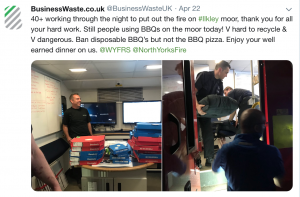
“Being based a stone’s throw from this week’s fire on Ilkey Moor, we’ve seen first hand the devastation that can be done, and we are indebted to the incredible, tireless fire service who have been ensuring nobody was hurt.”
“As amazing as the emergency services have been, we shouldn’t have to rely on already-stretched public services to tackle completely preventable damage. Items which are not only environmentally unfriendly due to their packaging and disposal, but also repeatedly cause enormous, irreparable damage to our countryside should be banned without question, and it is our duty to champion that cause.”
Everyday life can be hectic and small details often get missed – but a staggering 95% of households have ‘no idea’ which of their rubbish bins are due to be collected each week, waste disposal experts BusinessWaste.co.uk have found.
The survey conducted by BusinessWaste.co.uk, which polled 1,400 households, showed that the vast majority of households could not remember which of their bins was due to be collected that week – and an entertaining number of respondents admitted to resorting to ‘Bin Chess’ to find out.
Kelly, 38, from Bristol, laughed: “It starts on a Sunday evening – you can see people popping their heads round their curtains seeing if anybody’s made the first move yet so that everyone else can follow suit.”
While it might sound like something from a spy film, this is much less glamorous than James Bond – instead, hapless residents are lying in wait for their (hopefully more knowledgeable) neighbours to indicate which bin needs placing by the kerb for collection.
Macclesfield resident Stuart, 46, said it occasionally resulted in a stand-off, adding: “Sometimes you know it’s going to be a long night when nobody’s made a move by 9pm!”
The BusinessWaste.co.uk study showed that, despite their frequency, bin collections continued to be a source of trouble for households, indicating that:
Despite the comical image of a half-asleep neighbor chasing after the bin lorry dragging their recycling bin, failure to prepare for collection can cause a number of issues for residents.
Mark Hall, spokesperson from BusinessWaste.co.uk, said:
“In many places, each type of bin is only collected once a month – so while it might be easy to forget in our busy day-to-day lives, we could find ourselves with much bigger problems down the line. Piling black bags next to our jam-packed bins is a magnet for local cats, foxes, and rats, not to mention unsightly, and many local authorities will refuse to collect extra bags of rubbish from the kerbside.”
When asked what they do with excess waste due to forgetting the bin collection date, survey respondents had mixed responses. Some, like Anna from Chiswick, said they waited until they could get to a local tip. She added: “It’s a massive pain, and you end up carting smelly leaky bags in your car – I hate it but I can still never seem to remember to take the bins out right for more than a few months at a time”.
Others resorted to more underhand tactics. Ollie, 19, a student in Birmingham, admitted: “We just shove our binbags in next door’s bins when we’ve forgotten to put ours out. After one party we ended up putting about 20 cans in their recycling bin and they still don’t know it was us – well, we hope!”
Mark Hall concluded:
“Most people will forget to put their bins out and now and then – but instead of conducting covert missions to a neighbour’s garden or driving to the tip, households could find easier ways to remind themselves. Most councils have printable calendars on their website with the dates of upcoming collections, and many even now have an app which will send you notifications – saving you a rubbish-based nightmare in future!”
Consumers are increasingly turning towards second-hand clothing, studies are revealing – with conscientious buyers set to make pre-loved items a bigger market than so-called ‘fast fashion’ by 2029.
In a poll conducted by waste management collection company, BusinessWaste.co.uk, almost half of the 1500 respondents (45%) said they would buy clothes that had been pre-owned. This mirrors other studies that show that the second-hand clothing market was set to double in the next five years – and overtake the fast fashion movement in the next decade.
Fast fashion, commonly seen on the High Street, focuses on regular changes to clothing ranges, cheaply made garments, and low prices – meaning it has seen a boom in recent decades, as fashion conscious shoppers became accustomed to having the latest look. But it also results in many tonnes of clothing – much of which is made from non-recyclable fabrics – being sent to landfill.
However, it seems that consumers are beginning to shake off their prejudices about wearing second hand clothing. While just 20% said they currently regularly buy second-hand clothes, a huge amount said they could be influenced to start doing so
What would encourage you to buy more second-hand clothing?
Friends or family doing so first 90%
Celebrities doing so 94%
Nothing would 6%
Interestingly, while both younger and older fashionistas were seemingly happy to shop second-hand – 80% of 16 – 21 year olds and 91% of over sixties, respectively – the overall percentage averaged at 45%, suggesting that there are cultural elements at play.
Mark Hall, Communications Director of BusinessWaste.co.uk, said:
“Older people are used to buying clothes that were made to last and passing hand-me-downs through families, which explains this age group’s willingness to buy second-hand. And, on the other end of the scale, young people are increasingly environmentally conscious, which could certainly influence their shopping decisions and cause them to turn away from fast fashion. However, those in their thirties and forties are perhaps of a generation more used to consumerism, having grown up in the excessive 1980s – it’s certainly an interesting generational divide.”
Of those who said they would be happy to buy second-hand garments, there was a clear consensus that image played a part – with charity shops still carrying a slight stigma. 62% (2) said they would be happy to purchase from charity shops – much lower than the figure who would buy elsewhere.
Would you buy second-hand clothes from:
A charity shop? 62%
A High Street retailer? 80%
Interestingly, 92% said they’d buy second-hand clothing from a High Street retailer if celebrities or friends did first, suggesting that there remain some hang-ups about being part of the ‘in crowd’ when it comes to fashion.
Hall added:
“People are turning to second-hand clothing – not just out of financial necessity, but out of choice. There’s a huge opportunity here for retailers to improve their green credentials and tap into a growing number of consumers who would like to buy stylish clothing, but without the ethical concerns. Some well-known retailers already feature vintage or pre-loved selections in store and there’s clearly room for these to be more widely available – consumers still have the benefit of shopping curated lines of (second-hand) pieces in line with their preferred style, but without the environmental impact.”
A waste transfer note (WTN) is a legally required piece of documentation that must be completed when waste changes hands. This means if a business needs waste disposing of or collecting by a waste disposal company and it’s passed over to another business, perhaps for recycling or processing, a WTN must be completed.
The only notable exception is when a householder initially parts with waste. In those circumstances, a WTN is not required for the waste to be removed. However, if it’s passed on, then a WTN will be required. WTNs can cover either a single transaction or a number of similar transactions (a “season” WTN).
Waste needs to be disposed of legally and correctly – and completing a waste transfer notice is a legal requirement. To achieve this, it’s essential that there’s a clear audit trail showing what type of waste has been transferred and what happened to it when it was transferred between owners (if anything).
If the waste is hazardous, waste consignment notes help ensure the safety of the employees working with it as it’s moved through the waste disposal process.
Non-hazardous waste is covered by a generic duty of care waste transfer note. This contains details of the waste producer and waste receiver, as well as information regarding the type and volume of waste.
If you some or all of the waste is hazardous, you must complete a hazardous waste consignment note. This enables those handling, managing, and disposing of the waste to do so safely and appropriately. Broadly speaking, hazardous waste is any type of waste dangerous to humans or to the environment.
Common types of hazardous waste that require a consignment note can include batteries, asbestos, solvents, paints, brake fluids, fridges, pesticides, and oils. These types of waste must be dealt with professionally.
A separate type of WTN – a Vehicle Purchase Receipt – is required if a vehicle is sold for waste.
A waste consignment note is a piece of documentation that needs completing every time hazardous waste is moved, regardless of a transfer in ownership. In comparison, a waste transfer note is completed when waste changes hands. Non-hazardous waste doesn’t require the completion of a waste consignment note.
Hazardous waste consignment notes are part of a system of audit information that shows how a company stores, manages, and moves the hazardous waste in its possession. Companies owning hazardous waste are legally required to show how they are managing it appropriately – a waste consignment note is part of this process.
There’s no formally levied charge for completing a WTN or a waste consignment note. WTNs can be completed by your waste carrier for free, by simply using a generic waste transfer note template – see the example below. If a company attempts to charge you a fee for filling in a WTN, be suspicious!
There’s no reason why a charge should be applied. It could be that a business is attempting to extract cash from you for a piece of paperwork that should be completed at no additional cost, as part of the waste transfer transaction. At Business Waste we provide all our customers with their duty of care waste transfer note for free.
Yes, a waste transfer note is needed as it’s legally required when passing on your commercial waste to another party – except where a householder is parting with waste. If in doubt, fill in a WTN. Companies have been prosecuted and fined in the past for failure to complete a WTN when required to do so by law. Why take the risk?
WTNs should be kept for audit purposes for at least two years. Remember that the relevant information can be stored online if paper storage is likely to prove too onerous. Where possible it’s best to extend the waste transfer note retention period, just to be safe.
Waste consignment notes should be kept for at least three years. In the same way as WTNs, waste consignment notes can be stored online as well as in paper form.
A waste transfer licence is required by any company that transports waste as part of their business. You do not need to produce or own the waste, but if you move it to a recycling facility or landfill site, you must have a waste transfer licence. At Business Waste, all the drivers we work with are licensed waste carriers.
Meet your duty of care with the below waste transfer note example. Use this waste transfer note template for an example of what needs including to ensure your rubbish is removed safely and legally.
Learn more about waste transfer notes
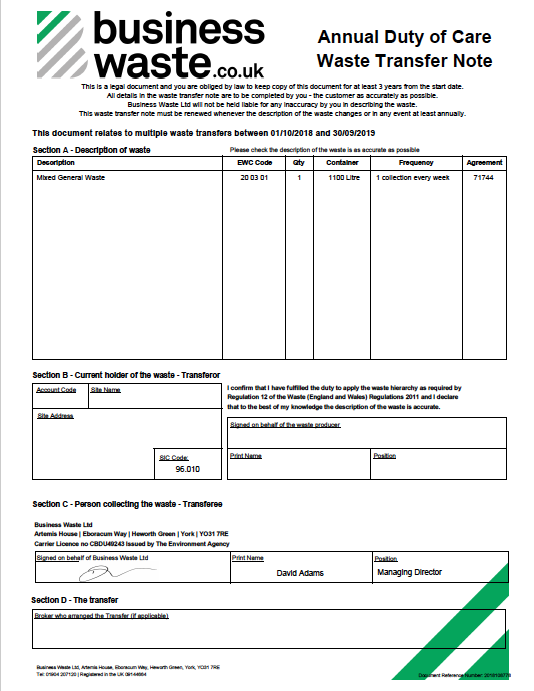
That wonderful time of the year has come and gone – but those thoughtful gifts will soon turn into an environmental headache as millions of candles head to landfill in January.
A report by business waste management service BusinessWaste.co.uk has shown that, far from being a light-hearted stocking stuffer, candles are one of the worst offenders for Christmas-related waste.
The candle market in the UK is now worth an eye-watering £90 million, with over a quarter of households now buying them regularly – and with this huge increase in popularity has come an increase in candles, particularly by luxury brands, making a widely-purchased gift during the festive season. Even lower-end retailers such as Aldi jumped on the home fragrance bandwagon, releasing hugely sought-after copies of more expensive scents – even causing scuffles to break out in stores where stock was lower.
So where does this increase in our obsession with lighting candles come from? It seems the Scandinavian trend of ‘hygge’ might have a lot to answer for. The term, which has become synonymous with cosiness, is Danish and represents “creating a warm atmosphere”. This cosy ideal has been widely adopted as a ‘lifestyle goal’, particularly by the Instagram generation, and it is often depicted by luxurious blankets, fairy lights and – of course – twinkling candles.
It’s no wonder, then, that their popularity is soaring – particularly as on-trend gift last Christmas. However, the environmental impact of this huge uptick in candle sales cannot be underestimated. Candles are often packaged in plastic wrap and even plastic holders – particularly popular tea-light style candles – and recipients are failing in their droves to recycle the remains of their cosy evenings in.
The average candle in retail outlets in the UK burns for six hours – meaning that for just six hours of household decor, the plastic casings of candles could remain in landfill for up to 1,000 years. And plastic isn’t the only culprit – many manufacturers also use glass and metal casings. While the general public has begun to increase its household recycling for the most part, reports suggest that efforts are mostly focused on food packaging, meaning that hundreds of thousands of other household waste items – such as candles – are still heading straight for landfill.
Mark Hall, Communications Director of BusinessWaste.co.uk, cautioned:
“As relaxing as a candle-lit room in the depths of winter can seem, households need to be aware that their choices as consumers have a direct impact on the environment. We see novelty candles flood the shelves throughout the run-up to Christmas and while they make a nice, cheap gift, their long term impact is just not worth the brief enjoyment they bring.”
Adding to the poor recycling rates for candle packaging is the fact that paraffin, a key component in most candles available on the High Street, is a by-product of petroleum, which means the increase demand for candles is adding to the already considerable pressure on non-renewable energy sources – and burning them also releases the greenhouse gas, carbon dioxide. Luckily for ethically-minded consumers, beeswax and soy alternatives are available and lessen the impact on the environment.
Hall added:
“Of course, many of us like to add a few luxuries to their homes – and there are certainly ways to reduce the impact you have on the environment. If you’re buying candles as gifts, aim to purchase those made from more eco-friendly waxes such as soy or beeswax with longer burn times, to maximise useage before recycling.
“For those of you who received a few scented candles in their stockings this year, please do ensure you’re recycling the remaining plastic, glass or metal afterwards wherever possible – it might be nice to have a festive glow in your living room, but the planet pays the price for it!”
READ – ALL THE CHRISTMAS WASTE FACTS
SIt’s something most of us won’t give a second thought while wrapping our presents during the festive period – but is there a more sinister consequence to using Sellotape, and should it be banned for the good of the environment?
The UK’s waste management service, BusinessWaste.co.uk, has delved into this sticky subject as Christmas – and with it, the enormous increase in purchases of sticky tape – approaches. It found that, alongside wrapping paper and plastic bows, sellotape was one of the most-purchased items during December, with 6 million rolls sold in the UK in the run-up to Christmas.
Of course, by the time the Queen’s Speech begins on Christmas day, eager families will have long since opened their presents, and it is the aftermath of this wrapping bonanza which BusinessWaste.co.uk is concerned with.
Sellotape, or sticky tape, is non-recyclable – generally made of a type of plastic called polypropylene, and one which many people may mistakenly believe can go in their recycling bin. Incidentally, many types of wrapping paper are also non-recyclable – meaning that Christmas day can create an enormous amount of waste headed directly for landfill.
Even the more eco-conscious amongst us who seek our recyclable paper may see their efforts thwarted, as paper with sticky tape on it causes problems further down the line at recycling centres – meaning that, with an average of 1.1 billion presents bought each Christmas, the implications for landfill sites are enormous.
Mark Hall, Communications Director at BusinessWaste.co.uk, commented:
“While it’s easy to get lost in the twinkling lights and excitement of Christmas, we have a very real responsibility to consider the impact millions of rolls of non-recyclable plastic have on the environment every year. With over a billion presents being given each year, consumers must act to reduce the unnecessary landfill totals each December.” We will use some 6+ million rolls of sellotape, more than enough to go to the moon and back.
It’s not all doom and gloom for December’s environmental impact, however. There are plenty of alternatives to this sticky problem – with the rise in eco-friendly entrepreneurs meaning there are now a number of biodegradable tapes on the market. Of course, you could also go back to the more traditional string or ribbon methods – string, particularly, has had a renaissance in recent years for its rustic look, and it’s cheaper than plastic tape.
Shoppers who are the ultimate in thrifty – and environmentally conscious – gifting, could consider giving gifts which don’t require any wrapping at all, such as concert tickets, charity donations or experience days.
Hall
concluded:
“When it comes to this time of year, people are often caught up in the consumerism and the desire to buy (and wrap) huge numbers of gifts for their families – but we should remember that gifts that contribute to damaging the environment are hardly in the Christmas spirit! Turning to recyclable or biodegradable wrapping methods will leave you with the warm glow of knowing you’ve done something good for the environment, as well as from your favourite Christmas tipple.”
READ – ALL THE CHRISTMAS WASTE FACTS
A surprising majority of shoppers have confessed to stealing plastic carrier bags during their weekly shop, it has been revealed.
Despite the 5p plastic bag levy introduced by the Government in 2015, a survey collated by waste management agency, BusinessWaste.co.uk, shows that light-fingered shoppers are still sneaking bags past the scanners in a bid to avoid paying.
The survey, which covered 1,000 shoppers from across the UK, showed that 41% admitted to the theft of plastic bags at least once in the past 12 months, blaming shops who charge more than the minimum 5p amount set by the legislation.
One unabashed shopper added: “Most places charge 10p now – that’s just too much, especially when I’ve got a grand’s worth of them under the sink already!”
This appears to be a common attitude, with social media awash with jokes about plastic bag stashes being worth a small fortune after the charge came into effect – suggesting that households are well aware that bags should, and can, be reused.
However, those who avoid paying the levy despite hoarding plenty of bags at home highlight a misunderstanding of the purpose of the charge – in that it was introduced by the Government to encourage reuse of existing carrier bags, or a switch to a reusable product such as cotton shopping bags.
The move saw a dramatic reduction on the number of carrier bags issued in the year after the charge was introduced – down to 19 per person from 140, suggesting that Brits have responded to the financial disincentive and are adopting more eco-friendly shopping habits. However, 1.04 billion plastic bags were still sold by the seven major supermarkets in 2017-18 – and single use plastic bags can take up to 1,000 years to break down, meaning there’s still an enormous risk to the environment if shoppers don’t change their ways.
Mark Hall, Communications Director of BusinessWaste.co.uk, warned:
“Shoppers may resent paying for plastic bags – but the solution is certainly not to steal them! A cotton or jute tote bag is easy to keep in the car, your handbag, or by the front door and can be used hundreds of times. Of course, it means remembering to take it with you, but with a bit of preparation you never need to buy a plastic bag again – which is great, not only for the environment, but also for your wallet.”
Shoppers may soon find themselves more inclined to switch to reusable bags, as the Government has announced a consultation on the plastic bag levy, to take place at the end of this year. The consultation could see the charge rolled out to all retailers, not just supermarkets – and crucially, could see the minimum levy double to 10p per bag.
Hall added:
“With Government plans to further increase scope and cost of the plastic bag levy following the success of the initial 5p charge, it’s the perfect time for shoppers to make the switch over to reusable bags.
“Many people will have suitable bags lying around already, but they’re readily and cheaply available and, as with many lifestyle changes, once you’re used to taking a cloth bag with you, it’ll become second nature. A tiny amount of forethought could have an enormously positive environmental impact, and that is something we should all endeavour to spend an extra second or two on before we head to the shops and think about plastic recycling.”
Despite the rise of recycling and recent high-profile debates in Government and the media about plastic use, 90% of businesses still do not have a green policy, it has been revealed.
UK waste management agency BusinessWaste.co.uk, says that the overwhelming majority of businesses are still behind the times when it comes to reducing their environmental impact.
Mark Hall, Communications Director of BusinessWaste.co.uk, explained:
“Households are expected to recycle their waste as a matter of due course now, and we are seeing much more media coverage of environmentally unfriendly items such as plastic water bottles or straws – but many businesses have been slow to implement changes into their day-to-day operations”
BusinessWaste.co.uk conducted a survey with 700 companies and found;
80% Had no separate recycling bins (internally or external)
96% Did not use recycled paper
59% Used plastic cups at the water fountain
20% Had an written green policy
6% Used green cleaning products
36% Used an fridge not AA+ rated
Johnny who works in marketing said “Mel in accounts is always asking for a paper recycling bin, I don’t know why we don’t have one to be honest”
Hall from BusinessWaste.co.uk added
“It isn’t just about recycling their waste – although this is, of course, very important – there are small changes which can be made each day which add up. Paper cups instead of plastic at the water cooler and encouraging employees to turn off lights in unused meeting rooms are two seemingly small ways to improve a business’s green credentials – and each of these actions has real benefits.”
However, failing to address environmental impact – or even consider a green policy – isn’t just bad for a firm’s impact on the environment. A study reported in the Guardian in 2015 showed that young people were increasingly more likely to consider a company’s ethical standing when applying for a jobs – including its approach to sustainability, which suggests that businesses may be damaging their own desirability as employers, too.
Environmental experts recommend including both employees as well as management in the creation of new green policies in the workplace. Not only does engaging with employees create a sense of ownership over the workplace and its collective environmental impact, it can also help generate broader discussions about policies which are most relevant to their daily routines. For example, teams working in paper-heavy departments may be more likely to suggest moving to paperless systems, while employees who frequently travel to meetings might be more inclined to suggest conference calling as an alternative to cut the firm’s carbon footprint.
Creating an environmental policy is an opportunity for businesses to review whether its operations are environmentally responsible. It can also help lower cost through reduced consumption and waste, providing a real incentive for firms to look at all aspects of their day-to-day running, including their suppliers, energy use, and use of consumables.
Hall added:
“Some businesses, especially smaller companies, may feel daunted by the idea of creating a green policy – but it doesn’t have to be War and Peace. Simply looking at your current use of energy and consumable items and setting some goals for reducing waste (alongside small, easily-implemented actions such as buying recycling bins for break areas) go a long way.
“Not only does this have a measurable effect on both your environmental impact and your overheads, it can also be a positive reflection on your business for clients, suppliers, and potential employees. Considering how urgent and crucial the issue of environmental damage, particularly waste going to landfill, has become, businesses cannot afford to ignore it any longer – and the good news is that companies can begin make a huge difference with just some small changes.”
This week, environmental protesters have hit the headlines for posting their empty crisp packets back to the UK’s largest crisp makers, Walkers – but ready salted snacks aren’t the only offenders.
Thousands of empty packets have been posted to the food giant’s freepost address in a protest designed to highlight the fact that, despite a continued trend towards more environmentally friendly packaging, crisp packets are still not recyclable.
Although the protests have drawn attention, leading business waste management service, BusinessWaste.co.uk, says that protesters haven’t gone far enough.
Mark Hall, Communications Director of BusinessWaste.co.uk, said:
“Enormous companies, including Walkers, respond to financial pressure – while posting crisp packets back to them is a good way to draw media attention for the greater good, ultimately it doesn’t hurt their bottom line, and won’t effect change.”
With over 4 billion packets of crisps produced by the company each year – 11 million per day – its environmental impact is considerable.
In April this year, a young boy discovered a 30 year old crisp packet washed up on a Cornwall beach whilst litter picking[1], highlighting the concerning fact that plastics, such as those used in food packaging, do not biodegrade and remain in the ecosystem for decades. This, plus the disappointing response from Walkers, who pledged only to have replaced their plastic bags with eco-friendly options by 2025, has led consumers to take a stand against the environmentally unfriendly packaging.
Hall added:
“Consumers could really push this issue by making the returns more difficult for Walkers to deal with – for example, by filling the packets with heavier items, just like consumers did to the freepost credit card applications a few years ago. This will be more costly for them to process and, in turn, cause them to address the reason for the protest – which is that, in 2018, it is deeply concerning that a large business continues to use non-recyclable packaging.”
“While this is clearly a pressing issue, other manufacturers are guilty of similar lack of care. Disposable nappies, the household staple for many families with young children, create millions of tonnes of waste per year, with 8 million thrown away per day in the United Kingdom. Not only are they widely used, meaning that billions of individual nappies enter the waste disposal system each year, they also contain non-recyclable plastics which can take hundreds of years to decompose.[2]”
Hall from BusinessWaste.co.uk noted:
“If consumers want to lobby companies who produce widely-use products with damaging environmental footprints, then perhaps they should also be sending nappies back to their manufacturers.
“For hundreds of years before plastic disposable nappies were invented, babies – and the environment – coped perfectly well without them; but their introduction sees millions of tonnes heading to landfill every year, despite there being less harmful and much cheaper options out there.
“Unfortunately, big businesses do not care about finding an ethical solution while consumers are happily using their products. While we know that the convenience of disposables is irreplaceable for many families, perhaps a glut of used nappies sent to the manufacturer – like these crisp packets – might force businesses to take notice of how consumers feel about unethical and environmentally damaging products.”
“We would suggest the answer isn’t posting back used items, it’s not buying those items to begin with”
Bin shaming, for making a mess of recycling? Households could soon be charged a return fee
Households who fail to recycle properly could soon be hit with a bin shame fee by their local council in a bid to reduce landfill waste.
The plans, reported by BusinessWaste.co.uk, would see local authorities charge individuals whose households incorrectly put recyclables into general waste bins, causing a bigger strain on landfill sites.
Despite huge increases in the rate of recycling nationwide, there remain tonnes of paper, plastic and other recyclable goods which needlessly go into landfill each year. Councils are under pressure to keep the rate of recycling high – including introducing penalties for households who fail to properly separate their waste.
The scheme, which has been described as a way to ‘shock repeat offenders’, aims to remove the burden placed on landfill sites, which saw 44.7 million tonnes of waste[1] – of an overall 203 million tonnes of waste handled – in 2016. Councils across the UK budgeted a staggering £6.3 billion for waste management in 2017-18[2], and many authorities are looking both to reduce the burden of landfill fees as well as meeting strict recycling targets.
While households may worry fear that the proposals will mean complicated or time-consuming additions to their waste disposal routines, it won’t add any extra difficulties into the recycling process. Rather, it will follow the existing recycling guidelines, with penalties only incurred by those who fail to place recyclable materials in their usual designated bins.
BusinessWaste.co.uk say that the charges will only form part of the new measures. The incorrectly-sorted items will be returned to the household to be correctly recycled – with the fee covering the shipping and handling costs for sending the waste to its original source. It is hoped that the move will force households to think more closely about the environmental costs of waste management by imposing a financial cost on those who contribute unnecessarily to the problem.
Mark Hall, spokesperson at BusinessWaste.co.uk, commented:
“It may seem like an excessive move, but with recycling bins provided to all households, there’s no excuse not to take a few seconds to seperate your waste. Hopefully this will also prompt consumers into making more conscious decisions when they shop – for example, choosing items which can be recycled – and thus further reduce their environmental impact!”
“Of course, we don’t necessarily agree with levying charges on homeowners as a punitive measure. We’d like to see councils and local government take an educational approach to ensure that the general public are well-informed of the benefits of recycling, which is a more positive way to help form life-long habits. However, this is certainly one way to turbo-charge recycling growth, especially for councils with historically low recycling rates.”
There is plenty of information online and elsewhere that espouses the benefits of recycling. It saves on energy, it encourages us to reuse things, it cuts down on waste sent to landfills… and on it goes.
But what about disadvantages? It would be foolish to assume there are none, but this is not an area many people think about. We thought we’d cover some of the disadvantages to even up the balance.
It takes time
Separating recyclables from non-recyclables takes time. It’s also easy to throw something away you think isn’t recyclable when it is, and vice versa. The more you know about recycling in this way, the easier it gets, but it is a point worth noting.
It takes up more room
If we threw away everything, as we used to in years gone by, we’d only ever need one bin. Nowadays, most people have at least three bins to sort their waste into, sometimes more. Glass, plastic, paper, regular rubbish… all these things must be cleaned, sorted, and put into the correct receptacle.
It costs more to start with
To recycle plastic, the right processes must be in place to make it happen. That means investing in vehicles to collect and transport the waste. It also means making sure the right machinery is provided to make it possible to recycle the waste. However, once these are in place, the long-term cost would be very different.
Recycled products are not always safe or of good quality
This varies enormously from one product to the next. However, it is worth noting some recycled products are of a poorer quality than ones that are made from new. The original products must be cleaned, melted, pulped, or otherwise dealt with to make it possible to recycle them. That isn’t always a good thing.
Putting best practices in place
While there are many benefits to recycling as much as we can, it makes sense that we would need to adopt best practices from start to finish to create the ideal scenario. Everyone wants to do their bit for the environment, so it is vital that we find the best ways to recycle products without causing further harm to the world around us. Learning more about the products we use, how we use them, and how we dispose of what’s left, is very important. It makes sense to do what we can to preserve the world we live in.
One very important feature of the new GDPR legislation that came into effect on 25 May 2018 is the correct disposal of confidential waste.
Under the new law, every company who has clients within the EU is now responsible for the appropriate disposal of GDPR waste, including items such as hard drives, old computers, memory sticks, old client data files, paperwork, and marketing materials.
How can you get GDPR disposal right?
The first thing to know is that the destruction of any form of data is classed as a form of data processing under GDPR. The best way to ensure that you stay within the law is to employ a secure data destruction provider such as Business Waste to carry out data disposal for you.
We will securely collect any unwanted media from your business and destroy it by means of approved GDPR shredding or GDPR recycling procedures. As per GDPR requirements, we certify that the data has been destroyed, providing you with a clear audit trail from the beginning of the process to the end.
Which items of equipment should you consider for GDPR waste management processing?
Where electronic data is concerned, you need to know that hard drives can be held within any form of electronic device from CCTV systems, to photocopiers and printers. Under GDPR you are required to identify all these data sources and you must be able to account for how long you have stored data on them and the reasons for doing so.
When you are auditing your equipment, you must consider every kind of media storage device your company uses, including:
• Hard disk drives
• Media tapes
• Solid state drives
• CDs
• DVDs
• Mobile phones
• Memory sticks
• Laptops
• Tablets
During the disposal process, we remove the hard drives from the equipment so you can be sure that all the data contained within them is processed right through to destruction. There’s no risk of any of your data being stolen and your company suffering a serious data breach.
Paper documents and files
Paper documents and files should be disposed of by shredding them on-site. Once the documents have been shredded, the remnants should be disposed of securely by bagging them and placing them in one of our bins. Be sure to store the bin in an area that cannot be accessed easily so that the contents cannot be stolen.
We can ensure that your business remains safely within GDPR waste disposal requirements. For more information and to find out more about waste management, contact our friendly team today.
Untangling the hair grip problem. It goes by many names – it might be called the hairpin, the bobby pin or the hair grip.
But whatever you call it, The UK’s waste management agency have called for these hair essentials to be made exclusively from recycled materials.
BusinessWaste.co.uk argue that the much-used hair grip is used and lost so frequently by women around the world that they risk becoming an unnecessary blight on the environment, as well as a huge waste of materials.
Spokesperson Mark Hall from waste collections company BusinessWaste.co.uk said: “While boys might not know exactly what they’re looking at when they see one, girls can’t do without that small piece of metal that somehow gets absolutely everywhere.
“Sometimes they might only be used once and then thrown away or lost, which is why you see them littering everywhere from gyms to pavements, workplaces, pubs and anywhere else ladies with hair might go.
“Because we know how frequently they’re discarded, it’s only right that they should be made from recycled materials, otherwise we’re just wasting resources on something that is effectively disposable.”
A survey was conducted by BusinessWaste.co.uk which involved over 3000 people. When asked where they’d seen hair grips discarded, people had some strange and interesting responses. 53% of people said they’d seen hair grips in public bathrooms, even down the loo in some cases, although it’s not clear whether they ended up there on purpose or by accident.
86% of people had found them in their own homes with no idea how they got there.
Of the 86% who had found them in their homes the most common places where
Under the bed
Down the side of sofa
Bathroom floor
Draws
And some odder finds including
In the dishwasher
In the toilet
9% of men surveyed by BusinessWaste.co.uk said they’d been put in a tricky situation at some point in their lives, with a girlfriend finding a stray hair grip that wasn’t hers in their home or car.
Steve, 33, Leeds said: “I was seeing a couple of girls at once when I was at uni, one didn’t go to my university and one did so their paths never crossed. I thought I was being really smart and careful, but then the uni girlfriend, Sarah, found a hair grip in my bathroom left by the other girl, Laura, I was rumbled. I tried to convince Sarah it was her own hair grip but she had really short hair and never used them – and neither did I.
“The irony is that Laura later found Sarah’s earring under my bed so she dumped me too. Lads need to know what these things are otherwise we’re going to slip up, that weird little bit of metal can ruin your life.”
It’s estimated that tens of millions of hair grips are sold in the UK each year, with many coming in multipacks of 50 or more. On average, each one of these hair grips lasts up to two weeks before it’s lost or broken, inevitably ending up in landfill.
BusinessWaste.co.uk say that switching to recycled materials would be a much more environmentally-friendly and sensible way to make hair grips, and would have a considerable impact on our planet considering how many are bought each year
Read next – A guide to hair salon disposal
Shoppers no longer bothered about the 5p fee as carrier bag use shows signs of bouncing back.
Supermarket plastic bag use is showing signs of increasing again as the 5p charge for a carrier no longer acts as a deterrent.
That’s the view of the UK’s waste and recycling company, which thinks that now, is the time to increase the fee to a more realistic level.
The BusinessWaste.co.uk company suggests – after carrying out a poll of supermarket customers – that a charge of £1 is the only way to finally make plastic carrier bags a thing of the past.
“The introduction of the 5p charge in England led to an 85% decrease in the number of plastic carrier bags being used,” BusinessWaste.co.uk ‘s Mark Hall says.
“Unfortunately, 5p is no longer the shock to the system it once was, and we’re certain that the next government statistics will see a significant rise.”
With the next set of statistics due at the end of July, BusinessWaste.co.uk is confident that the annual figure will rise above the billion mark for the first time since the charge was introduced.
Previously, English shoppers were getting through seven billion single-use bags every year.
“We want to see that figure fall to zero within five years,” says Hall, “and the only way that can be done is by increasing the charge, while making reusable bags cheap and widely available.”
BusinessWaste.co.uk polled nearly 2,000 shoppers who patronise a wide range of stores from the budget end to the luxury end of the market. We found widespread agreement that 5p was no longer a hurdle to asking for a plastic bag, though there was not a great deal consensus on raising the charge.
When the 5p charge was introduced, did it stop you using plastic carrier bags?
Yes: 84%
No: 16%
Are you now routinely paying 5p for carrier bags at the supermarket?
Yes, for all my shopping: 24%
Yes, for some of my shopping: 38%
No: 36%
“It’s clear that we’re backsliding on our shopping habits, and the main reason is that we no longer care about adding a few pence onto our shopping bill,” says Business Waste’s Mark Hall.
“And that’s straight from the mouths of shoppers who find the whole performance of remembering your reusable bags a bit of a palaver.
“That’s especially the case for those who pop into their convenience store for a few items on their way home, now accounting for a staggering number of supermarket visits.”
And while there’s still resistance to increasing the fee (with even some demanding it be scrapped), it looks like that the only way to increase use of reusable bags is to hit shoppers in the pocket.
What’s the most you would be willing to pay for a supermarket carrier bag?
Nothing: 3%
5p: 16%
10p: 23%
20p: 38%
50p: 14%
£1: 6%
Mark Hall: “It’s hardly surprising that there’s resistance to raising the charge to 50p or a pound, but that’s the pressure we need to put on shoppers to make them change their habits.
“Raising the plastic bag fee to 20p – while it would be great for the charities who benefitted by millions in the last year – would only leave people in their comfort zone where they won’t miss the money.”
Says the BusinessWaste.co.uk spokesperson: “It’s got to be set to a high level for the charge to actually work.”
Can we decide what to do with fidget spinners once the craze is over?
Britain’s kids (and quite a few adults) have succumbed to the fidget spinner craze that’s swept the world, but like all crazes it’s going to come crashing down sooner rather than later.
And that’s when millions of the metal and plastic devices will end up in the bin, with the vast majority going straight to Britain’s already brimming landfill sites.
That’s the opinion of the UK’s waste management company BusinessWaste.co.uk, who says the spinners will go the same way as loom bands did before – into the bin and a big hole in the ground.
“We’ve seen it before, we’re seeing it now, and we’ll see it again,” says BusinessWaste.co.uk spokesperson Mark Hall. “The market’s saturated with the things, kids have moved on, and there are literally millions of them gathering dust in the shops.”
The problem is two-fold, says Hall. Firstly, there’s the millions of spinners in the hands of (currently) happy users who will soon get bored with them.
“They’ll either gather dust in a drawer before being sold as a genuine antique on Ebay in ten years’ time, or they’ll end up in the bin,” he says. “My money’s on the latter.”
And the second – far larger problem is the unsold stock filling shop backrooms and warehouses all over the country.
“We saw this with loom bands,” says Hall, “Shops and mail order companies over-ordered like they were going out of fashion, and suddenly they did just that.”
No amount of discounting will shift them, and they’ve got to go somewhere, Business Waste says.
That somewhere is straight into the bin as companies cut their losses, and BusinessWaste.co.uk hopes this is done responsibly, as the spinners contain parts that can be recycled.
What are fidget spinners made from?
• It all depends on the quality of the spinner
• The best ones are made from high-quality metals such as titanium, brass, stainless steel or copper
• At the cheap and more popular end of the market, they’re dominated by aluminium, low-quality steel and padded out with plastic
• But whatever the manufacturing process, the metals are recyclable
“If they go straight into the general waste – and that’s the temptation for many individuals and companies who will eventually be sick of the sight of them – that’s a huge waste of resources, not to mention precious landfill space,” BusinessWaste.co.uk ‘s Mark Hall says.
The BusinessWaste.co.uk spokesman recalls a previous craze that backfired: “Back in 2014, landfill sites looked like an accident at a spaghetti factory because there was so much loom band waste from shops and warehouses – companies didn’t know whether to recycle them or not, so just binned the lot.”
And that’s going to be the same with fidget spinners, as the plastic content sows doubt in the mind of those making decisions on which bin to use.
“There really ought to be separate plastic bins for fidget spinners this autumn,” Hall says, “Not to mention separate areas at rubbish tips and fidget spinner amnesty boxes at charity shops and school reception areas.
“We can hoover up millions of the things if we do this right.”
There is an easy way to get rid of them, though. Business Waste’s advice to mum and dad for when the kids eventually get bored with their devices is simple.
“Take a family trip down to your community waste facility. Keep the kids in the car for safety’s sake, and bung the spinners in the bin marked ‘metals’. Job done.”
The south-east London borough of Lewisham has been named the worst borough for household recycling in London following research carried out by a private sector waste company.
The information was taken from official data collected by the Department for Environment, Food and Rural Affairs (Defra) and local authorities.
The national average for householder recycling is 44.9% in England.
According to the latest statistics, only 17.1% of residents in Lewisham are recycling their waste. While the residents of Newham aren’t performing much better, with only 17.2% their taking the time to recycle.
Out of the 32 London boroughs, it was Bexley which came out on top in this recycling war. An impressive 54% of householders here are regular recyclers; more than the national average.
Bromley and Kingston-upon-Thames were the only other boroughs beating the national average, with rates of 48% and 45.7% respectively.
Westminster was ranked 30 out of the 32 boroughs for its householders commitment to recycling, with a rate of 19.1%.
One industry expert involved in the research said he was surprised that the rate for Westminster was so low below the national average, considering it is one of the wealthiest London boroughs.
London’s seemingly poor recycling attitude has been blamed on the city’s growing population, which makes recycling harder to enforce, and the number of rented accommodation compared to properties occupied by homeowners.
Please follow this link for more info about our waste and recycling services.
Farmers top the list, with office workers at the bottom of the pile
The best workers in the country for recycling their rubbish are farmers, it’s been revealed – and they’re so good at it, they should be paid by the government to show the rest of us how it’s done.
That’s the finding of a British waste and recycling company which surveyed various sectors across the UK economy to see which group produced the highest percentage of recyclable waste compared to waste sent to landfill or incineration.
York-based BusinessWaste.co.uk found that sectors such as factories and farms, whose profits depend on reusing and recycling as much as possible came out on top, while office workers came bottom.
“Office workers generally aren’t aware of the cost implications of throwing everything into their desk-side bin,” says BusinessWaste.co.uk spokesperson Mark Hall, “And in a large organisation that can soon add up to literally tonnes of rubbish.”
BusinessWaste.co.uk looked a tallies from its own operators to find out which areas of the UK economy recycled the best and found:
Britain’s top commercial recyclers:
1. Farmers
2. Factories
3. Pubs & restaurants
4. Retail
5. Hospitals and clinics
6. Schools
Britain’s worst commercial recyclers:
1. Office-based businesses
2. Night clubs
3. Takeaway food establishments
“Why are famers go good at recycling?” Hall asks. “The answer is simple – they’ve been doing it for centuries, and they have a waste-not-want-not ethic that has survived down the years.
“From small family-run farms to giant agri-businesses, it’s the same – everything is collected, assessed and re-used where possible.
“Only the absolute detritus is thrown away, and then only with reluctance,” says the BusinessWaste.co.uk spokesperson.
BusinessWaste.co.uk say factory owners and operators have the same sort of ethic, but for entirely different reasons.
“Every tonne of unrecyclable waste they produce costs them money to get rid of,” says Hall. “Industry has gone to great lengths to find alternative uses for its waste, often selling it on to another sector that finds it useful for their own products.”
Waste rubber and glass going on to be constituent ingredients of low-noise road surfaces is a fantastic example of this cooperation between industrial sectors, Business Waste says.
Offices, on the other hand, have little incentive to boost their recycling waste, and many simply can’t be bothered – or simply don’t have the time in a pressured environment – to move from their desks to find the bin for their empty drink can.
And that’s why farmers should be employed by the Department of the Environment (DEFRA) as recycling ‘champions’ to pass on their knowledge to the slackers and refuseniks at the bottom of the survey.
“They’ve got generations of knowledge that could and should be passed on to others,” says Hall, “And because it results in everybody saving money and resources, it’s a scheme that will easily pay for itself in the long run.
“And the sight of a farmer telling a nightclub owner how to improve their business margins is something I dearly want to see.”
Charities losing out as criminals leave their own bins in town centres
Local and national charities are being cheated out of income by an ambitious criminal who has started leaving fake clothes banks in towns and cities.
Fresh from scams involving convincing-looking plastic charity bags being pushed through people’s doors, the fraudsters are now thinking big, a national waste and recycling company says.
According to BusinessWaste.co.uk, it’s got to the point where local authorities are impounding dishonestly-placed “charity” bins which only exist to make crooks richer.
“The people are a blight on decent society,” says BusinessWaste.co.uk spokesperson Mark Hall, “They prey on people’s charitable instincts just for personal profit.”
BBC Radio 4’s You and Yours program highlighted the difficulty that local charities face against dishonest traders who steal donations of clothing from literally under their noses – with Manchester City Council telling the BBC that they had identified at least two recycling bins in the city with no markings.
“It’s certainly enterprising, but the bottom line is that they are taking money away from the needy,” says Hall, “And apart from trying to catch the crooks in the act of picking up their bin, there’s very little the authorities can do to apprehend them.”
The newly discovered fake bin con follows the tried-and-tested scam of fake charity bag collections, as well as stealing legitimate charity bags left out on doorsteps
“People are bombarded with charity bags, and it’s sometimes difficult to tell which are real and which are fake,” says Business Waste’s Mark Hall. “Legitimate charities are finding their names on fake clothes bags when they’re not even collecting in the area.”
And what happens to the dishonestly collected items?
The gangs will sort through “donations” and sell the best on the internet.
Other items are driven to Eastern Europe, where there is a boom in British-style clothing to be fed in local stores. None of the profits are returned to UK charities.
The rest, however, creates a problem, says BusinessWaste.co.uk.
“These items – to put it mildly – are rubbish,” says Hall, “And these are not the kind of people who are going to pay trade rates at the local rubbish tip.”
Instead, the criminal gangs will double up on their dishonesty by fly-tipping their unwanted clothes, shoes and other items.
“They’ve got no social conscience, and they don’t care that the likes of you and I have to pay for the clean-up out of our Council Tax,” Hall says.
But with so many people trying to make a quick pound by fleecing charities, there are still sure-fire ways of making sure that you’re giving to the good guys.
“Fill those charity bags that come through your door,” says Hall, “and then take them to your nearest charity shop, who will likely welcome you with open arms.
“They don’t even care if your bag has another charity’s name on!”
What many people don’t know is that clothes, textiles, and shoes charity shops can’t sell are collected and taken away for genuine recycling. That way, even your most “useless” of gifts still raises funds.
BusinessWaste.co.uk ‘s Mark Hall advises people to keep an eye open for fake collectors and to report them to local trading standards.
“That way, we can get these criminals off the streets, and restore trust in a system that they’re trying to con.”
The Association of Cities and Regions for Recycling and Sustainable Resource Management (ACR+) has published a report claiming that pay-as-you-throw (PAYT) waste schemes would increase recycling rates and help reduce the amount of waste produced each year.
The report, titled ‘Cross-analysis of ‘Pay-As-You-Throw’ schemes in selected EU municipalities’, discusses the financial and environmental benefits and potential negatives of introducing pay-as-you-throw waste systems in European municipalities.
The study focuses on PAYT systems in seven European cities in Sweden, Germany, France, Austria, Italy, Belgium and the Netherlands.
According to the report, nations across the globe are not doing enough to tackle the increase in product consumption and waste production, caused by emerging economies, recovering economies and a global population growth.
The report states that: “Connecting consumption with environmental impact will make up a critical part of addressing this challenge, and PAYT offers a potential piece of this puzzle by giving citizens an incentive to reduce waste.”
The possibility of a PAYT system has been discussed by the UK government. Such a scheme would see residents charged for municipal waste disposal based on the amount they produce.
However, Defra resources minister, Rory Stewart, said the implementation of a PAYT system in the UK would receive too much public objection to be successful.
The report itself also addressed the potential problems of a PAYT scheme. It states that a ‘one fit for all’ would not work as “no municipality is the same”.
It also adds that local authorities would have to implement more frequent collections and also be prepared to educate residents on waste reduction and recycling, however, this would not completely reduce the risk of increased fly-tipping incidents.
Please click here for more info about BusinessWaste.co.uk ‘s waste management services.
Return of the long-dead tradition is well overdue a comeback to increase recycling rates
One of Britain’s favorite childhood memories is long overdue a comeback in a bid to increase national recycling rates.
Paying a deposit on a glass bottle, which is then refunded when returned to a participating retailer, effectively died out in the UK with the advent of the disposable plastic bottle, but Britain’s fastest-growing waste management and recycling company says now is the time to bring it back.
According to York-based BusinessWaste.co.uk, figures from the United States – where bottle deposits are still widespread – show that the higher the deposit, the more likely a bottle is returned intact.
“We often look at the past with rose-tinted glasses,” says BusinessWaste.co.uk spokesperson Mark Hall, “but the bottle deposit was something that really did work.”
In the post-war period, children could make themselves a reasonable fortune by scouring their local area for empty bottles, which they’d then take back to the shop to receive a few pence each.
“It was killed off by plastic bottles, but that came with a legacy of millions of tonnes of waste in hedgerows and kerbs filled with bottles,” says Hall. “It’s time to end this epidemic of wastefulness.”
It’s something that worked very well back then, and can work again now, Business Waste says, and the reasons are simple:
• Recycling glass keeps production costs down for drinks manufacturers and bottlers, as it’s far cheaper to make bottles from used glass than it is to make new from raw materials
• Recycling glass is also greener than using plastic bottles as there are few waste products
• Human nature means that people are more likely to recycle if there is a reward
“The furore over the 5p charge for supermarket carrier bags so how worked up we get as a nation get about very small sums of money,” Hall says.
“We can turn this negative energy into a positive by rewarding customers for returning recyclables.”
BusinessWaste.co.uk says that in the United States, where container deposits are widespread, there’s a 70% return rate when it’s set at 5 cents, rising to a 97% success rate in Michigan where it’s set at 10 cents. In states where there’s no deposit scheme, recycling rates are only 33%.
“If the state of Michigan can achieve a 97% return rate with only a modest bottle deposit, then so can Britain,” BusinessWaste.co.uk ‘s Mark Hall says. “We expect that a scheme set at 10p per bottle will be a roaring success in the UK.
“Not only that, it’ll encourage a new wave of school-age entrepreneurs to get up and set about collecting as many bottles as they can,” he says.
There might even be a modern twist on the idea, BusinessWaste.co.uk suggests.
The burden of paying out return rewards could be switched away from shopkeepers, and could instead be paid onto a loyalty card account which can be “cashed out” at any time.
The reward would naturally be the same as the deposit paid, but it virtually guarantees continued custom and gives a good reason to continue returning used containers.
“Sometimes the old ways really are the best ways, and it’s time we reconsidered container deposit legislation in the UK,” Hall says.
“It’s great for recycling rates, it’s great for British industry, but best of all – it’s great for kids’ pocket money.“
Call to redistribute tens of thousands of publications to sick and needy
Every week, tens of thousands of unsold comics and magazines are returned from shops to retailers, who send them to be pulped, it’s been revealed.
Instead of this destruction, one national waste and recycling company suggests that they are redistributed at cost to hospitals and charities where they can be enjoyed.
According to the BusinessWaste.co.uk, there’s a particular problem with comics for children which have free gifts attached to the front cover, meaning they are often sent to be burned or buried in landfill.
“It’s an extraordinary waste,” says BusinessWaste.co.uk, spokesperson Mark Hall, “Because there are thousands of kids who’d appreciate those comics and gifts.”
BusinessWaste.co.uk, says that all of these unsold publications are perfectly saleable.
“While some of these are retained for the back issue market, huge numbers are simply destroyed within days of being replaced on the shelves by the next edition,” Hall says. “And with recycling figures stalling, it defies logic.”
Instead, Hall suggests, there should be an approved list of hospital children’s wards, nurseries, Sure Start centres and other organisations for young people which could receive a limited number of unsold comics and magazines for the enjoyment of patients and pupils.
Opportunity for charities
“It wouldn’t be a freebie,” Hall says, “The magazines could be bought back from the wholesalers at a price to cover their costs, and could even be funded by charitable donations.”
With the help of children’s charities – and this seems an excellent project for BBC Children in Need to become involved in – the gift of reading and play could easily be passed onto young people who need it the most, Business Waste proposes.
A straw poll carried out by BusinessWaste.co.uk, found firm backing for the idea among the British public:
• 94% said they’d support a charity-driven scheme
• 6% said they would not
“The nay-sayers have a valid point in that it might hit sales from the newsstands,” says Hall, “And that’s why we say such a scheme would be limited in scope to make sure that doesn’t happen.
“Shops and publishers have businesses to run, after all!”
One nurse told BusinessWaste.co.uk,: “You should see the books and comics that we have for the children – they’re falling apart at the seams, and I think even prisoners get a better deal. We rely on what parents bring in, but it’s depressing to see kids’ get bored because they have so little to read and do.
“A regular supply of recent comics and magazines would be brilliant,” she said.
There may even be scope to extend the idea to old people’s homes and hospital wards, where decent reading material is at a premium.
“It’s about improving people’s quality of life by keeping their brains active,” says Mark Hall.
Many doctors’ and dentists’ surgeries now use subscription schemes to keep their waiting rooms interesting with up-to-date magazines, and BusinessWaste.co.uk, says extending a charity scheme to the older generation would be careful not to tread on the toes of this expanding business model.
The aim, Hall says, is to stop magazines and comics going to waste by giving them to the people who need them most, but can’t usually get access to them.
“As a waste company we positively hate seeing perfectly good items destroyed,” he says, “And that’s why we want to see kids and comics reunited.
“It’ll be good for the environment, and it will be great for young imaginations, too.”
Research carried out by the environmental consultancy firm, Resource Future, on behalf of the Aluminium Packaging Recycling Organisation (Alupro) has found that the UK recycled 55 per cent of its aluminium waste in 2015, which is seven per cent higher than the initial figure.
The Alupro study discovered that more than 10,000 tonnes of aluminium recycling went unaccounted for when the 2015 aluminium recycling rate was calculated.
According to the initial figures, 48 per cent of aluminium packaging waste was recycled in 2015 and 60 per cent of used aluminium cans was also recycled. The combined recycling rate from these two figures means that the UK had already achieved the 49 per cent aluminium recycling target which had been set for 2015.
The research by Alupro found that more than 10,000 tonnes of aluminium recycling had gone unreported through the packaging recycling note (PRN) system. This means that the UK recycled 86,200 tonnes of aluminium in 2015, as opposed to the original figure of 76,027 tonnes.
Alupro used the EU’s methodology system (as set out in the European Commission’s new Circular Economy package) for calculating recycling rates. The executive director of Alupro, Rick Hindley, commented: “It is vital that the measurement system we use in the UK for calculating recycling performance is aligned to the methodology used throughout Europe.”
The study suggests that 55 per cent of the aluminium waste produced in the UK in 2015 was recycled. In addition, 69 per cent of aluminium cans were recycled, rather than the initial 60 per cent figure.
Mr Hindley added: “Our research clearly demonstrates the need to encourage more reprocessors to become accredited to ensure that the PRN system provides an accurate record of recycling performance.”
Please follow this link to find out more about Businesswaste.co.uk ‘s waste management services.
Waste businesses vie for electronic goods to release a small fortune in precious metals
There’s a new buzzword in the waste and recycling industry, and it’s “urban mining” – the act of reclaiming electronic goods to cash in on the precious metals inside.
With commodity prices still at high levels as investors turn away from diving oil prices, recycled gold and silver inside discarded electricals suddenly make sound financial sense, Britain’s fastest growing waste company says.
According to York-based BusinessWaste.co.uk, a standard laptop could contain up to £25 worth of gold at current prices, while high-end desktop machines could contain even more.
“Recycling companies are now seeing the contents of the WEEE bin as a quick win,” says BusinessWaste.co.uk spokesperson Mark Hall, “And they’ll take these goods away from their previous owners for free because – with the right tools and expertise – they represent a superb return on investment.”
And it’s not just obsolete electronics being cleared off the desks and warehouse shelves of companies who no longer need them. The habit of throwing tonne upon tonne of electronic goods into landfill mean our hills are – quite literally – full of gold.
“The high-end electronics industry relies on gold, silver and other precious and rare-earth metals to supply ever-faster and ever more reliable devices,” says Hall. “And it’s far cheaper to recycle these metals than it is to mine it from ore.
“And with prices at high levels, it has suddenly become all the more urgent to find precious metals the cheapest way possible – and that’s from obsolete equipment.”
What’s in an old laptop?
• Some 320 tons of gold and 7,500 tons of silver are used in the global production of personal computers every year
• It’s cheaper to recover previously refined precious metals that it is to prospect, mine and process “new” gold from the ground
• According to the Dell Computer company, the circuit boards inside a laptop can contain about £25 worth of gold
• A mobile phone can contain £3-4 worth of gold, and a tablet computer around £10
• Older computers will contain more precious metals, meaning some company storerooms could represent a treasure trove
Effective urban mining means increased margins for the waste and recycling industry, and that results in more competition between companies to uncover waste from large companies who are replacing their technology.
“At any given moment, a large blue chip company or public service organisation in the United Kingdom is undergoing a technology refresh programme,” Hall explains. “They usually retain their old equipment for data integrity reasons, but will soon wish to dispose of it safely and with all due respect to confidentiality.”
That’s when a responsible waste management company becomes involved. They’ll come under contract to make sure that sensitive equipment is thoroughly destroyed, while trying to maximise their return from recovering metals and plastics from the gear they’re “mining”, Business Waste says.
“It’s a smart balancing act,” says Hall. “Verifiable destruction combined with the smart recovery of precious metals can now be achieved by companies with the right expertise and right equipment, and it’s these urban miners who are going to profit from British industry’s continuing need for up-to-date equipment and readily-available raw materials.”
That’s going to mean deals with local authorities, waste handlers and all kinds of businesses and public sector organisations to have their unwanted electronics diverted away from the rubbish tip, BusinessWaste.co.uk says. “It’s recycling by another name, only with much higher stakes,” says Hall.
There are also moves to address the millions of items underground at landfill tips, but this is a more complex process that comes with its own risks and safety issues.
“But it’s entirely possible that urban mining means just that – digging down for old reusable goods. Britain’s rubbish tips are full of precious metals, just waiting to be unlocked,” says BusinessWaste.co.uk s Mark Hall.
With the average office computer having a service life of around five years, hundreds of thousands of processors containing vital metals enter the waste and recycling system every year, BusinessWaste.co.uk says. It’s only now that we’re realising how important it is to capture as many as possible to save the UK economy a small fortune in gold.
“British industry has the expertise to unlock this money,” says Hall. “We’ve got the tools – let’s get on with it.”
A new highly-detailed data report produced by the Organisation for Economic Co-operation and Development shows the municipal recycling rates for its member countries.
The report shows the good, the average and the ugly; from the current leader, Germany, topping the table with a 65% recycling rate; to the USA, which is lagging behind many European countries, with a 35% recycling rate; and then to the struggling Turkey, which recycled a pitiful 1% of the nation’s municipal rubbish in 2013.
Here is a list of the top OECD nations that are leading the recycling race. (The results were collated by OECD and reflect the municipal waste that was recycled and composted in 2013):
12. United Kingdom (43%)
In contrast, the following is a list of the OECD nations that are currently at the bottom of the recycling pile:
According to Forbes, a report produced by Eurostat claims that Germany sent just 63.8million tonnes out of 353million tonnes of municipal waste to landfill in 2012 and just 11 million tonnes went to the incinerators. The remainder was either recycled or used for energy recovery.
There is a suggestion that Germany’s recycling success is partly due to its plastic bottle and aluminium can deposit system. One can often see unemployed/homeless people rooting around inside bins for any discarded bottles and cans. However, such systems are also used in Canada, where the recycling rate is just 24%.
Please follow this link for more information about our waste management services.
A severe lack of hygienic sanitation in developing countries throughout the world causes 700,000 deaths every year, according to World Bank, who say the problem is responsible for many development issues.
Many private and public sector initiatives have been set up to tackle the problem as the United Nations makes ‘universal access to hygienic sanitation by 2030’ one of their Sustainable Development Goals.
The senior manager of the World Bank’s Water and Sanitation Program (WSP), Jyoti Shukla, spoke out about the importance of safe sanitation for the world’s population. Ms Shukla said: “Stunting and malnutrition are directly related to poor sanitation; quality of learning and productivity is affected by sanitation; and dignity and empowerment of women and girls is influenced by how we deliver sanitation.”
Sanivation, a company based in Kenya, is just one of the private sector businesses tackling the issue. They install safe toilet stations in poverty stricken areas, slums and refugee camps and carry out weekly collections to remove the human waste.
Sanivation then treats the human waste at its processing plant, where it is mixed with agricultural products to create briquettes. The briquettes are then sold on to farmers who use them as fertilizer on their land. The business is making money from the collection of human waste, but the work that it is doing is important for developing countries.
Chief executive of Sanivation, Andrew Foote, believes that, in the case of providing safe sanitation to a wide network, private sector businesses are more effective than public sector and charity organisations.
Mr Foote said that, despite making progress: “…with rates of urbanisation and population growth, despite the efforts of many actors, the number of people lacking access to sanitation in sub-Saharan Africa and in urban areas has actually been increasing in the last 10 years.”
If you want to read more about our waste management services, please follow this link.
Recycle your paint and save thousands of pounds per year. Painting and decorating trade could save tons of hazardous waste annually
The commercial painting and decorating trade could save thousands of pounds every year if it used teamwork to recycle its unwanted paint.
A national waste and recycling company says that most paints used in the industry are classified as hazardous waste, meaning that it costs the trade a small fortune to dispose of safely and legally.
Instead, the BusinessWaste.co.uk company suggests that the trade should take part in a paint swap scheme so that as little is wasted as possible. Business Waste suggests medium-sized companies can save up to £10,000 per year in this manner.
“We reckon that even a one-man-band painting and decorating contractor can save thousands every year in waste site gate fees,” says Business Waste spokesperson Mark Hall. “Teaming up with their local competitors and colleagues means that they needn’t throw that excess paint into the skip.”
BusinessWaste.co.uk spoke to painters and decorators, from man-and-van operators to major companies, and found that no matter what the scale of the organisation, most contracts tend to over-estimate the amount of paint they need by between 5 – 10%.
• In fact, paint giants Dulux reckon 55 million litres of paint and 90 million containers are wasted every year both domestically and through the trade
“That usually no big deal when you’re painting a bedroom with a water-based emulsion,” says Hall, “But when it’s a large job weatherproofing the outside of a large building that means substantial wastage of specialist materials.”
BusinessWaste.co.uk says that this excess is often built into the quote to the customer, meaning it’s no real deal when it comes to company expenses, but that still means that painters are still throwing away tons of paint every year. However, there’s still the problem of storing, transferring and disposing of specialist paints that add to both overheads and company paperwork.
• Community RePaint is a scheme that collects leftover paint from the trade and redistributes it to community groups. There are around 70 schemes like this in the UK, says Dulux
While Community RePaint is an excellent yet patchy scheme serving parts of the UK, it still doesn’t address the tide of wasted water- and solvent-based paints that are left over from commercial jobs every week of the years.
“A paint swap with nearby companies is certainly something we’d consider,” one medium-sized decorating company in the Midlands told BusinessWaste.co.uk. “It’s just a matter of setting up a Freecycle-style Facebook group, and advertise unwanted quantities to other companies.
“And we’ve got a storeroom full of leftovers that we’d only be too glad to get shot of in this way.”
Another owner-operator says he’d be only too pleased to take unwanted paint off the hands of larger operators: “It’ll save them money, it’ll save me money, and it’ll save dumping perfectly good paint as hazardous waste. Everybody’s a winner,” he says. “And it works both ways too – I’ve got stuff in my garage that might come in handy for somebody. Let’s talk!”
Business Waste says that paint and paint products make up the single biggest by-product of the whole construction industry that can easily be saved and recycled for other jobs.
“We handle whole truckloads of paint containers at the end of any building job, which go straight to the tip because they’ve already been budgeted, “says Hall.
“It’s something that can easily be stopped, and the decorating trade can lead the way by (literally) pooling their resources.
“It saves money, it saves chemicals, and – best of all – it saves us the headache of handling tons of hazardous waste. Swap and reuse your paint, you know it makes sense.”
Billions are thrown away each year in scandalous and preventable waste, which also destroys companies’ green credentials
The average British worker uses – and throws away – around 400 disposable plastic cups every year in what’s been dubbed one of the great-unreported waste scandals.
This adds up to billions of cups disposed of every year, with a huge majority only ever being used for a couple of sips of water before being discarded, Britain’s BusinessWaste.co.uk’s waste management company says.
This preventable behaviour is wrecking the green credentials of companies up and down the country and it costing them money in landfill charges, yet simple ideas could be put in place to stop it, the York-based BusinessWaste.co.uk Company says.
“It is one of the great unreported waste scandals of our time,” says Business Waste spokesperson Mark Hall, “And often companies don’t even recognise it as a problem.”
BusinessWaste.co.uk has found that the average worker, across office, manufacturing and retail sectors will use in the region of two plastic cups every working day. This works out – subtracting weekends, sickness and holidays – at approximately 400 plastic cups per year.
The York-based waste management company found:
• 82% use plastic cups once, then immediately throw them away
• Only 18% will re-use a plastic cup (and 95% of these will throw it out at the end of the day)
Of those who throw their cups in the bin immediately:
• Only 23% will specifically search out a recycling bin
• 70% will use the nearest bin, regardless of the fact if it is for plastic recycling or general waste
• 7% said recycling is “somebody else’s problem”
Hall says there’s a “blindness” in British companies who don’t realise there’s a problem with this huge mountain of plastic waste.
“We’ve seen it with our own eyes,” he says, “We’ve worked with companies who have proudly told us of their green credentials while they automatically grab a plastic cup from the dispenser, drink a mouthful of water, and then throw it into the general waste bin.
“And it’s not just limited to water – plastic cups from coffee vending machines are just as bad (not as bad a coffee pods)” Hall says, “while many brands of ‘paper’ cup are hard to recycle as they come with a waxy lining to keep the water from leaking.”
The solutions are simple, and BusinessWaste.co.uk is urging companies to take a look at how they can cut down their plastic waste immediately.
• Encourage workers to drink from glasses, or their own reusable water bottles
• Consider giving workers their own water bottles
• Increase the use of china cups for hot beverages
“These solutions come with their own problems such as washing-up and cleanliness, but this is effectively offset by the huge tonnage of plastic waste that ends up in landfill every year,” says BusinessWaste.co.uk ‘s Mark Hall.
If anything, bosses should consider their own bottom line when it comes to wasteful single-use cups:
“Using plastic cups costs companies money, and it’s a waste of resources that should – by now – be as socially unacceptable as smoking in a kindergarten class.”
The roll top menace: Why this bin needs to be banned
The commercial roll top bin needs to be banned or completely redesigned to put an end to a series of accidents in the waste management industry.
That’s the opinion of Britain’s fastest-growing commercial waste collection company which says that the bin – one of the most widespread in the industry – is to blame for a long series of accidents which make it less than popular with operators.
According to BusinessWaste.co.uk, it’s all too easy for the roll top to slam shut, often on an unsuspecting arm, and it’s this history of incidents which make it unsuitable in a trade that prides itself on its safety standards.
“The fact that most injuries caused by roll tops bins are relatively minor in the grand scheme of things means that they’re overlooked as a cause of workplace injuries,” says BusinessWaste.co.uk spokesperson Mark Hall, “but minor injuries stack up, and no employer likes paying sick pay and compensation for preventable incidents.”
The problem is that the design of the bin means that it can shut quickly without warning, and an operator whose attention is elsewhere might find themselves injured. While the lid itself is made of heavy-duty plastic, it still packs enough of a punch to break bones.
The reliability of the lids on commercial roll top bins is a known issue. While perfectly safe to use when new, the lid mechanism tends to seize up over time, meaning they are either wedged open permanently, or act in an unpredictable manner when being emptied. That’s when they can slam shut as the mechanism frees itself and become a danger to operators, says Business Waste
BusinessWaste.co.uk, in conjunction with Yorkshire-based health and safety consultancy Protecting.co.uk found that most injuries laid at the vicious door of the roll top bin are crushed and broken fingers, broken and bruised arms, and the occasional blow to the head.
Some of these injuries have been relatively minor, but most result in days off work and lost productivity.
• As one bin operator put it: “One minute I was wheeling a roll top back to the company’s bin bay, the next I was rolling around on the floor clutching three broken fingers. My mates say it just slammed back shut on me for no reason. I was off work for months.”
• Another said: “More fool me to try to force a jammed mechanism on one of those stupid bins. Broken wrist.”
“Employers have a duty of care to their workers, and frequent injuries caused by equipment might leave them open to prosecution or a civil case for compensation,” Protecting.co.uk’s Jonathan Ratcliffe explains. “Both the waste company and the commercial client can find themselves at risk of a claim if bins are found to be faulty following an accident.”
And it’s this risk which has driven BusinessWaste.co.uk to call for a complete ban on their use. Roll tops were introduced as a convenient alternative to the lift-top bin. They’re also a space-saving measure for areas where there’s little room to lift a lid.
However, this convenience has introduced a new level of risk which BusinessWaste.co.uk says is unacceptable.
“There’s really no place in a modern, safety-conscious industry for a piece of equipment that fails so regularly and is a constant cause of incidents and injuries,” says BusinessWaste.co.uk ‘s Mark Hall.
“Either a new, safer mechanism is introduced across the board, or we roll back the roll tops and just use lift-top bins from now on.”
While development of a safer alternative with incur extra costs, BusinessWaste.co.uk says it’s a small price to pay to end the growing mountain of sick days and compensation claims.
“Safety should be our number one priority,” says Hall, “But we’ve turned a blind eye to this menace in our industry for too long.”
“Get rid of the roll tops.”
Car parts, encyclopaedias, and scrupulously shining tins: Britain’s weird recycling habits revealed
People up and down the country have eccentric habits when it comes to putting out their recycling, it appears.
A nationwide waste management company has been collecting stories of the weirdest things that have been left out in recycling bins by the British public.
Even though complete sets of encyclopaedias, surgical implements and – in one case – an engine block from a Ford Escort have been left out for the bin men, it proves that the UK is enthusiastic about recycling, says the Business Waste company.
“We hear all sorts of weird and wonderful stories from waste operators,” says BusinessWaste.co.uk spokesperson Mark Hall, “And it would be a shame not to share them.”
It’s not just households, either, BusinessWaste.co.uk says. “When companies, shops and businesses get into the recycling spirit, you’d be amazed what they throw out.”
• One of the most common things that domestic waste operators say they find are household recycling bins full of bottles and tins that have clearly been through the dishwasher.
“It’s more common than you think,” says Mark Hall, “And we believe it’s down to basic pride. Heaven forbid that the neighbours see you putting out dirty rubbish.”
Business Waste says that tins and bottles are melted down, so they don’t need washing out at all. However, if you’re worried about vermin getting among your recycling, a quick rinse is more than adequate.
But it’s the ever-growing list of strange things left in recycling bins by both households and businesses that raises eyebrows at BusinessWaste.co.uk HQ in Leeds. Among the most bizarre are:
1. A complete set of encyclopaedias (“We suppose they prefer Wikipedia these days”)
2. A collection of surgical appliances in somebody’s household waste
3. Engine block from a 1997 Ford Escort (“Too big. We told them to take it to the tip”)
4. A full-sized skeleton (“We were assured it was plastic held together with metal”)
5. One thousand commemorative Royal Baby tankards from a company where “Kate” was spelled “Kait”
6. A decorative cremation urn (“Empty and unused. They buried their loved one instead, we’re told”)
7. A signed photo of Jeremy Clarkson
8. A batch of General Election leaflets where [unnamed party] got the election date wrong
9. A framed printed copy of Van Gogh’s Sunflowers (“At least we hope it was a copy. We’d be feeling a bit stupid if it wasn’t”)
10. A commercial bin full of company merchandise after the business changed its name (“We’ve never seen so many promotional mouse mats in the same place”)
The most important thing to remember despite all the recycling craziness is that Britain is still recycling, and thinking hard about what should be put out to be collected Business Waste says.
“Government figures say that we’re still only recycling about 45% of our waste, so we have to appreciate the half of the country that is making the effort,” BusinessWaste.co.uk ‘s Mark Hall says.
“We appreciate them, even when they fill out world with weirdness.”
Red tape wrapping its way around the environment leads to fines and fly-tipping
Who’s watching your rubbish bins? That’s the question that’s being asked as phantom bin stuffers are avoiding tip fees and council fines by stuffing their rubbish into other people’s bins.
It’s an anti-social behaviour that many in the recycling industry warned would happen as extra red tape makes it cheaper for rogue traders and lazy householders to dump their rubbish onto other people, says a national waste management company.
Recent cases of criminal activity meeting official lack of common sense have resulted in residential bins not being emptied because bin lids are open less than an inch, and companies unlocking their premises in the morning to find their bins filled to the brim with another company’s rubbish, the Business Waste company says.
“The phantom bin stuffers are out there, just as everybody predicted,” says BusinessWaste.co.uk Waste Management Director Mark Hall, “They’re the same as fly-tippers – heaping their waste on others because they’re too lazy or too tight-fisted to deal with it themselves.”
Red tape out of control
In a recent incident, one resident of Gloucester found that local contractors had not emptied his domestic bin because the lid was open by less than an inch, after a phantom bin stuffer had filled his wheelie bin to the brim overnight.
“It’s this kind of mindless red tape brought in with the best of intentions, that is infuriating for the victims,” says Hall. “And when councils start handing out on-the-spot fines for over-filled bins or the wrong kind of recycling, it’s only going to get worse.”
“‘Closed lid’ policies that encourage people to recycle more sound great in a council meeting room, but in practice it reeks of bureaucrats not understanding the real world,” he continued. “Council policy is often geared to punishing people for full bins, rather than help them cut down on their waste.”
BusinessWaste.co.uk offers a few solutions for people who find their bins filling up too fast, some of which may not be entirely practical:
• NO: Jump up and down on your rubbish – Comes with obvious health and safety dangers
• NO: More bins – But what if you’ve already got four and no space?
• NO: Guard dogs, or all-night bin-watching vigils
• YES: Pressure your council for more recycling points and better tip facilities
• YES: Recycle more, reduce waste, and try to buy items with less packaging
Unfortunately, many people don’t see bin stuffing as anti-social behaviour, much less a crime. Business Waste spoke to some residents who saw no problem with using other people’s bins once theirs are filled to the brim.
“It all goes to the same place, so what’s the problem?” one person said.
“We had too much rubbish the week after Christmas and a week to wait for the bin men. So lucky for me there was a builder’s skip down the road,” said another.
Commercial sector losing thousands in waste crime
But it’s in the commercial sector that the worst damage is being done. With commercial waste being subject to the landfill tax, and with sensitive or dangerous waste having their own processing costs, fly-tipping has always been a problem.
Rogue traders are always looking for less than legal ways to cut their overheads on waste management, leading to a plague of bin stuffing up and down the country.
BusinessWaste.co.uk say they’ve heard of dozens of cases of companies finding their bins stuffed with other traders’ waste, and in some cases they’ve found dangerous materials such as asbestos and waste chemicals.
“It’s pure criminality,” says Hall, “And it’s costing British industry millions of pounds every year to clear up.”
The problem has become so widespread that companies are installing CCTV systems to guard their bins. “It’s partially to stop valuable metal waste from being stolen,” Ratcliffe says, “but now it’s also to catch people trying to put rubbish into the bins.”
BusinessWaste.co.uk says people have enough to worry about without criminals and lazy neighbours causing them inconvenience and expense through their fly-tipping.
“But with better waste policies and a crackdown on the criminals, we can make this a thing of the past,” says Hall.
Learn to cook and help save the planet and yourself
Food packaging waste is killing the planet, and it’s all down to lazy meals
Packaging waste produced by British homes could be slashed by up to a half if people dumped ready meals and learned how to cook again.
That’s the opinion of a national waste and recycling company, which says that we as a nation have slipped out of the habit of home-cooking, with potentially disastrous consequences for both health and the environment.
Despite the popularity of TV programs like Masterchef and Great British Bake-Off, the BusinessWaste.co.uk company has found that most people think they haven’t got time to cook a meal from scratch in the evening, and lack the skills to do so.
“Lazy eating is becoming a national epidemic in this country,” says BusinessWaste.co.uk spokesperson Mark Hall, “And not only are we filling ourselves up with excess sugar and salt from ready meals, but we’re creating mountains of food packing waste that goes straight into the bin.
“So much plastic waste – it’s killing the planet in the name of an easy dinner.”
BusinessWaste.co.uk asked hundreds (1450) of householders how often they cooked an evening meal from scratch using fresh ingredients and were shocked by their own findings:
• Never 34%
• Once a week 43%
• More than once a week 21%
• Every day 2%
How often do you eat ready meals? (‘Ready meals’ also includes food from takeaway restaurants)
• Never 3%
• Once a week 31%
• More than once a week 48%
• Every day 19%
“That’s nearly a fifth of people eating ready meals every day,” says Hall. “That’s pretty depressing, and an indication of how far down the road we’ve gone as a convenience society.”
• Eve, who works in central London was typical of people BusinessWaste.co.uk asked: “I’m too tired to cook when I get home. I can pick up something from the supermarket by the station and stick it in the microwave. That’s pretty healthy, right?”
Unfortunately, many supermarket-bought ready meals contain excess quantities of sugar and salt and could be damaging to health in the long-run. It’s worse if the meal is of the instant variety:
• Jake, another commuter living in Woking said: “Home. Pot Noodle. Watch the football down the pub. I haven’t got time in my life to cook. Who has?”
• Maria, who is a working mum, added some context: “I’ve got a busy life as it is, and my lazy family expects me to put dinner on the table every night. The hubby helps, but most times it’s something out of the freezer and straight in the microwave. I’ll always try for some fresh veg, though. I don’t want them to die of scurvy, right?”
• Brian, a dad from Coventry says: “We try for a home-cooked meal most nights, but sometimes we’re all just too tired. I feel really guilty about the number of plastic pots that go in the bin when we have a lazy meal – surely there’s another way?”
BusinessWaste.co.uk said food packaging waste can be lowered by a massive 50% of people started cooking more meals at home, rather than relying on processed food for their diets.
“Our lives are really no busier than they were twenty or thirty years ago,” says Hall, “but we’ve fallen out of the habit of cooking for ourselves. Now there’s an emerging generation that doesn’t have those skills at all. Some people can barely boil an egg.
“We’ve made ourselves prisoners in the ready meals aisle,” he says.
While the tens of thousands of tons of extra food packing are a serious issue, the health of the nation is just as bad, with a reliance on low-quality food causing obesity, diabetes and other conditions which will cost Britain dearly in coming years.
“Dumping the ready meal really will save lives, and help save the planet,” says Hall.
One person who spoke to BusinessWaste.co.uk e put the issue into perspective: “Maybe I’m looking at this with rose-tinted spectacles,” said Stephen, 40, “But as we were crowded around my iPad watching the progress of our pizza order, I remembered a time when we crowded into the kitchen to make an evening meal together.
“We might give that a try this week.”
Companies could save millions using ‘mushroom’ alternative
Plastic packaging for factory goods should be banned in all but the most exceptional of cases now that alternative products are on the market.
Single-use boxes used for good packaging should be made of biodegradable materials that can be recycled or mulched, saving companies millions of pounds, says a leading UK waste management company.
With British companies wasting a small fortune every year on protective packaging, it’s clear that sustainable materials should be used rather than plastics which are routinely sent to landfill, the Business Waste organisation says.
“As a nation, Britain uses over a quarter of a million tons of plastic every year, with a sizeable proportion used in packaging,” says Business Waste spokesman Mark Hall. “With newly-emerging packing based on biodegradable mushrooms available, the days of plastic are numbered.”
Hall says that current packing processes lead to enormous quantities of waste which could be eliminated at a stroke. “Tens of thousands of tons is either sent to landfill or burned,” he says, “That’s a massive waste of resources now that alternatives are on the market.”
Business Waste says that government should encourage companies to use green packaging wherever practical – either through a system of grants, or legislation to slash the use of plastics.
In most cases, plastic protective packaging for electronic goods is for cosmetic purposes only, and only exists to maintain brand image when the outer box is open.
“It’s a brave but forward-looking brand that abandons white plastic inserts and replaces them with biodegradable card or organic packaging,” Mark Hall says, “but it’s a step that businesses should be prepared to take.”
Alternatives that businesses should consider to replace plastic inter packaging include:
– Recycled card
– Biodegradable foam ‘peanuts’
– Shaped biodegradable foam
– Organic fibre inserts
The last of these is now a cheaply-available reality. It’s a type of fibre derived from the mushroom root system that can be turned into durable – yet 100% compostable – custom shapes ideal for any component or product. According to its developers, the environmental impact of this packaging is precisely zero.
“Boxes you can grow are the future,” says Business Waste’s Mark Hall. “Given enough backing an enthusiastic take-up across industry, we could finally see fewer plastics going to landfill or the furnace.”
Business Waste says that voluntary take-up may not be enough, and urges tightening of environmental laws to ensure green packaging is always considered before plastics, which should be seen as a last resort.
“The world is struggling under the weight of wasted plastic that can take up to 500 years to break down,” says Hall, “And they’re wasting their own money while they’re doing it.”
“Britain can do its bit with a ban on industry’s wasteful practices, and switch to green packaging.”
Why unaddressed paper ‘spam’ has to stop
The average household now receives over 500 pieces of junk mail every year, with the figure showing no sign of decline.
While direct advertising is a mainstay of many businesses, the truth is that up to 90% is binned unread, leading to millions of tonnes of paper waste every year, a Yorkshire-based waste management and recycling company says.
According to BusinessWaste.co.uk, the worst offenders for unaddressed marketing to Britain’s 25 million households are takeaway food businesses, charities, supermarkets, and banks and insurance companies.
“Among these companies are some of the UK’s best-known brands,” says Business Waste spokesperson Mark Hall, “and some of them claim to be champions of the environment.”
BusinessWaste.co.uk asked some 2500 households all over the UK about how they deal with so-called junk mail and found that the vast majority of people treat it as exactly that:
• 89% – We bin promotional leaflets without reading them
• 11% – We read promotional mail before disposing of it or keeping it
• 57% – We don’t bother recycling leaflets, unaddressed mail or takeaway menus, they just go straight in the bin
The waste management company found that the most likely companies and organisations who resort to direct addressed and unaddressed mailing are:
• Charities (including charity collection bags)
• Estate agents (which tend to use higher quality card or paper for their promotions)
• Banks and insurance companies
• Supermarkets promoting local offers
• Takeaway menus
It’s the takeaway menus which are less likely to be ignored, with some households interviewed by BusinessWaste.co.uk saying they had drawers full of them, some being antiques going back several years.
“It’s the charity begging letter, often with a pen, blank greetings card and other free gifts asking for a donation or direct debit that’s most likely thrown away unread,” BusinessWaste.co.uk ‘s Mark Hall says. “Ironically, some of these are environmental charities, so heaven knows what they’re thinking in their head offices.”
Unfortunately, Royal Mail’s current business model relies on postmen delivering wads of junk mail to households all over the country, Business Waste says.
Despite the newly-privatised company’s “Sustainable Advertising Mail” policy that encourages responsible sourcing of paper for mail-shots, the fact remains that over half of these marketing messages will end up in general waste and won’t be recycled. The companies involved also know that just one business lead out of hundreds of leaflets will make the marketing exercise truly cost-effective.
“The sheer scale of direct mailing in the UK is mind-boggling,” says Hall. “We’re talking over 500 pieces of mail per household per year – that’s billions of unsolicited pieces of junk mail.
“In terms of trees, conservative estimates put that at six million every year, despite attempts at using sustainable sources.”
While calling on companies to ease the flow of junk mail, Business Waste notes that less than 10% of households are signed up to the Mailing Preference Service or other door-to-door opt-out schemes.
“We can help slash paper waste by refusing junk mail in the first place,” says Hall, “but companies can make things easier by not sending it at all.”
To arrange a junk removal or your junk mail – contact us today!
1. Use old free clothes hangers as crisp clips and keep them fresh!
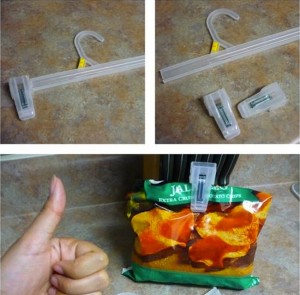
2. For the always-falling zipper, no need to throw those pants out!
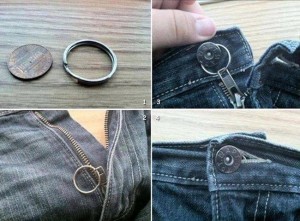
3. One for the wine lovers! Freeze grapes and chill wine

4. How to fit two bowls into a small microwave

5. A great idea on how to recycle a babies cot

6. Use a leaf blower and PVC pipes to clean gutters without a ladder and without having to pay for help
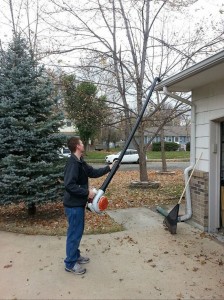
7. The easiest way to make an ice cream sandwich, better undo that belt buckle YUM!
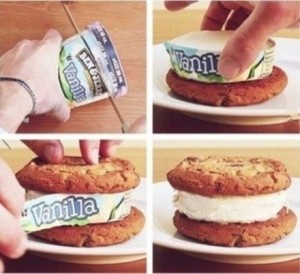
8. How to stop people from stealing your pens at work once and for all!
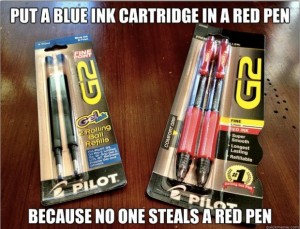
9. By putting your phone into airplane mode will charge it twice as fast. Easy!
 .
.
10. How to fix a blurry phone camera in seconds
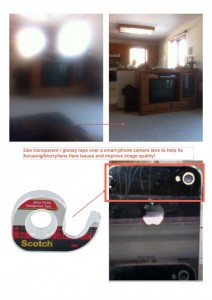
11. One for the men! Wrap a wet paper towel around beer, and put it in the freezer to cool in just 2 minutes.
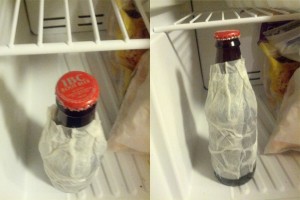
12. Use a can opener on tough annoying hard plastic packaging
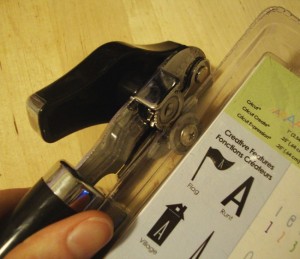
For more great up-cycling and recycling tips and ideas, check out these
Increased security measures mean thieves turn to easier targets
A spike in the theft of paper and cardboard earmarked for recycling is being blamed on scrap thieves looking for “soft” targets.
That’s the view of a major British waste and recycling company that says increased security measures for scrap metal mean that criminals turning their eye on what previously been considered less lucrative refuse.
According to BusinessWaste.co.uk, the recovery in the price of recycled cardboard means that it’s now economically viable for crooks to make off with bales from companies’ loading areas with minimal risk.
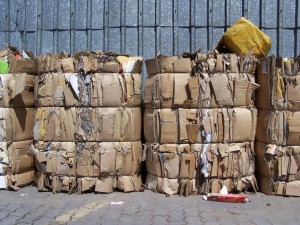
“While the CCTV cameras and alarms are all trained on the scrap metal bin, thieves are finding easy money elsewhere,” says Business Waste spokesman Mark Hall. “And most of the time it’s ready for them in easy-to-handle bales.”
BusinessWaste.co.uk says it’s a crime that’s not as “glamorous” as scrap metal theft that’s seen road signs stolen, as well as the long-running curse of raids on leaded church roofs.
“Some police forces don’t take this kind of behaviour seriously, as it appears on the face of it to be a victimless crime,” says Hall. “Why investigate the theft of something from a rubbish bin?”
However, with companies able to sell baled cardboard waste for between £50-£70 per ton, it’s a crime that can net the committed criminal hundreds of pounds daily if they know where to look and where to dispose of their ill-gotten gains.
“Industrial units and supermarkets are particularly at risk from groups targeting unguarded waste storage areas” says BusinessWaste.co.uk’s Mark Hall.
“But thieves will also cruise down shopping streets in an unmarked van just before the commercial waste collection arrives, lifting all the cardboard left out by shop owners.”
Some bin operators say they have encountered cardboard collection rounds where they’ve hardly picked up a scrap because organised gangs are so efficient. It’s a lucrative crime with quick rewards, with little appetite from the authorities to investigate, the company says.
“But it’s not a victimless crime,” says Hall. “They’re taking money out of the pockets of small businesses who are being paid per ton of their recyclable waste. That’s straight-up theft.
“And they’re also taking money out of the pockets of waste management companies who make money from collections. It’s a crime that costs British jobs.”
In fact, a recent report from the US says that cardboard thieves are costing recycling companies in New York up to ten million dollars every year.
“The rate of growth in this particular crime in the UK means that we’ll be reaching those levels very soon,” says Hall.
Calling on the police, local councils and the recycling industry to get together to address the problem, BusinessWaste.co.uk ‘sMark Hall says: “It’s high time this was taken seriously as a crime and stopped in its tracks.”
“It’s not rubbish that being stolen, it’s livelihoods.”